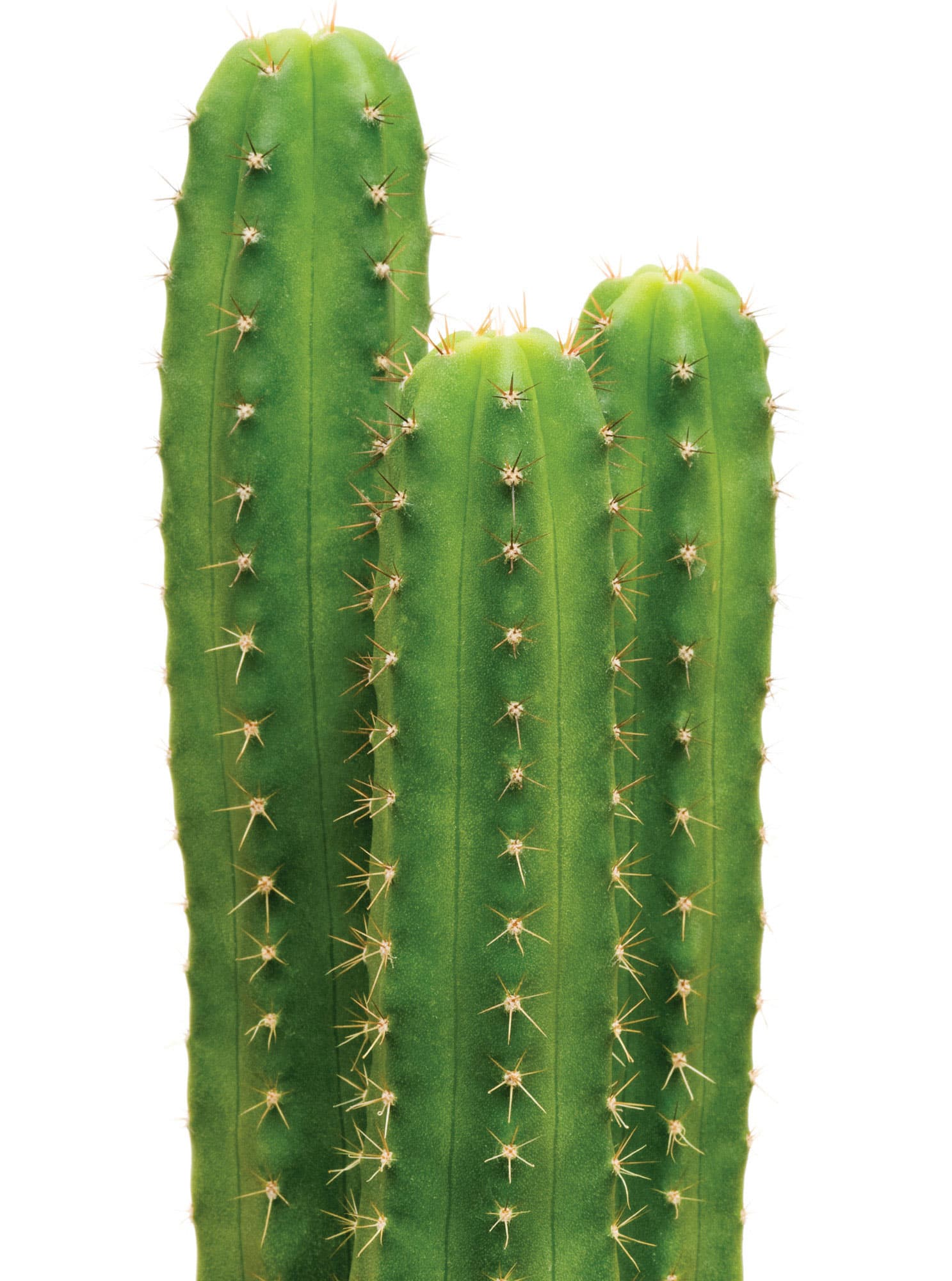Featured Plants
100 Top Choices of Cactuses and Succulents
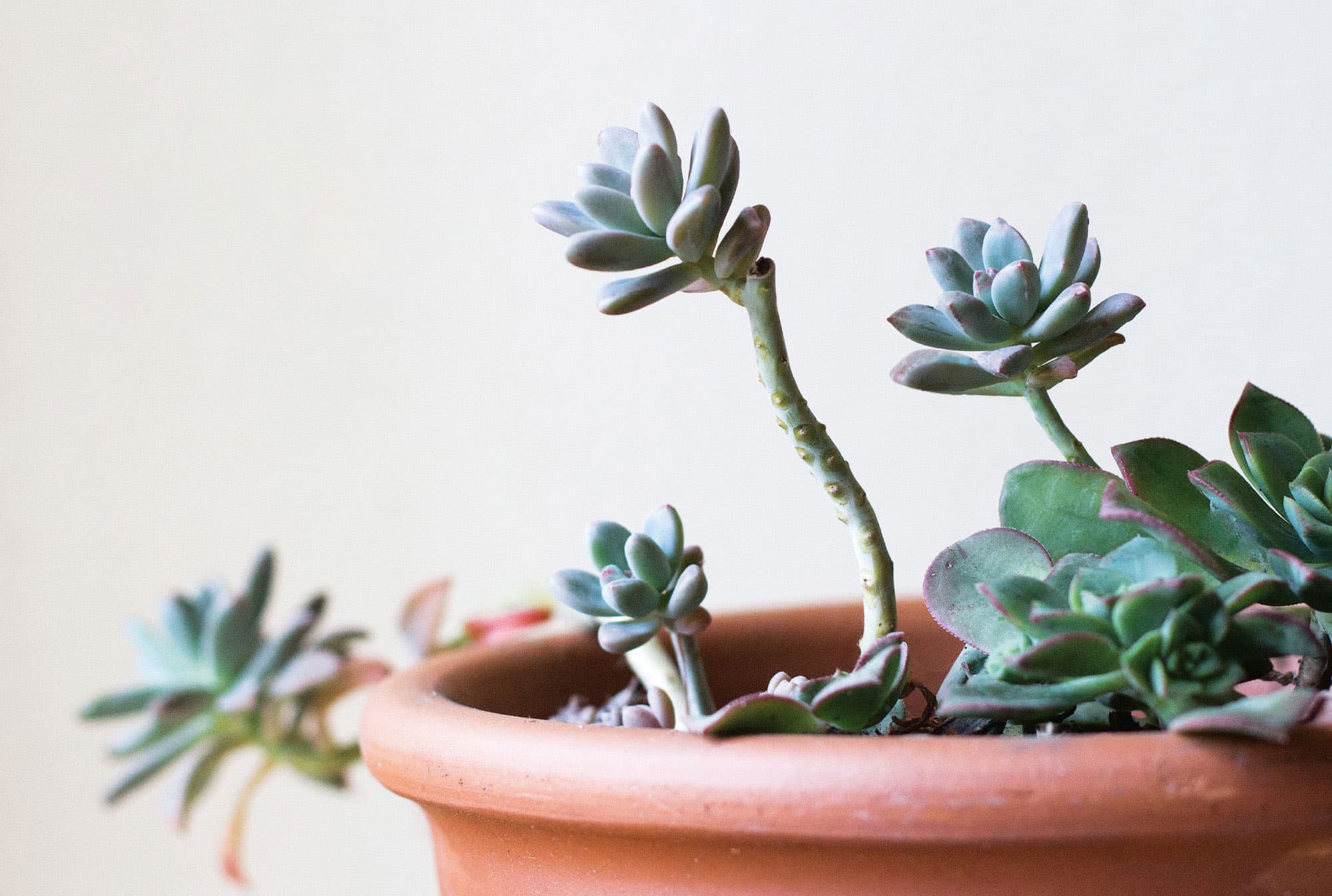
Adenium obesum
DESERT ROSE
FAMILY: Apocynaceae
ORIGIN: Tropical Africa and the Arabian Peninsula
CULTURE: Loves the heat and full sun and needs a very loose, well-drained soil mix. Enjoys regular watering during the warmer months, which are the primary growing period. Actually likes being rootbound. Be careful not to overwater; soil should be allowed to dry out slightly between waterings. Regular fertilizing in spring will promote more abundant flowering. When temperatures begin to dip below 55°F (2.8°C) in the fall, bring containers indoors to a sunny but cool location and reduce watering. Plants are deciduous (lose their leaves) in winter and have a dormant period until spring.
COLD HARDINESS: 40°F (4.4°C)
PROPAGATION: Primarily by seed
BLOOM TIME: Summer
The desert rose has an interesting swollen base known as a caudex that serves as a water reserve in times of drought. Breeders in Thailand have taken this species and produced a multitude of spectacular hybrids. The trumpet-like flowers can be white, pink, or red, with many new striped hybrids available. Best container grown in most locations because of its sensitivity to cold, plants can be left outdoors in a sunny location during the summer and moved indoors to overwinter. Often grown as a “faux bonsai”; the caudiciform base and plant shape in general are often shown off in a bonsai-type container.
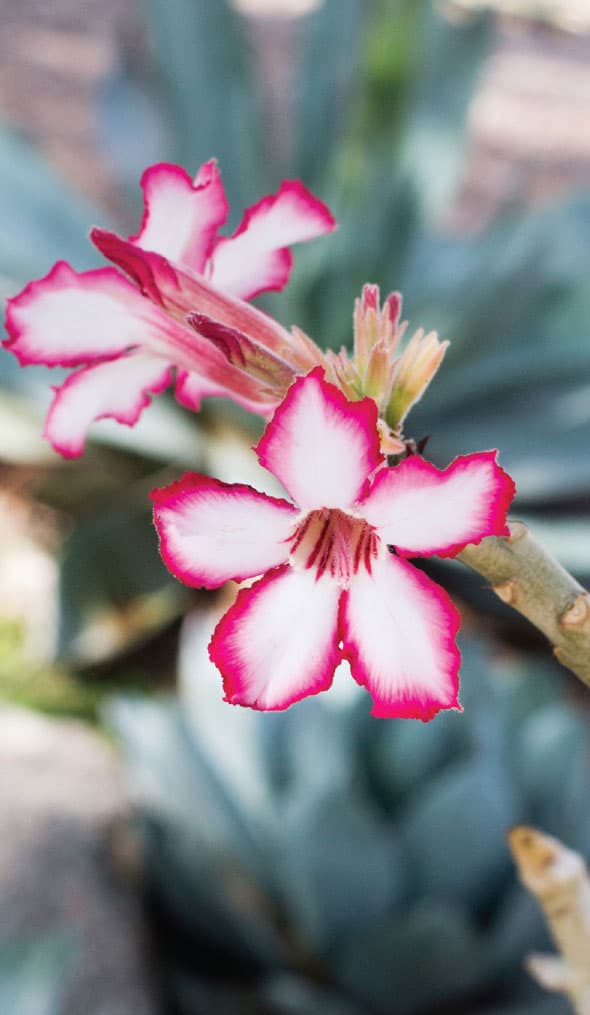
Adromischus cristatus
CRINKLE-LEAF PLANT, KEY LIME PIE
FAMILY: Crassulaceae
ORIGIN: South Africa
CULTURE: Grow in full sun in a well-drained soil and water regularly to occasionally, especially during the growth season from spring to fall.
COLD HARDINESS: 25°F (–3.9°C)
PROPAGATION: By cuttings
BLOOM TIME: Summer
Succulents take on many shapes reminiscent of the physical world. It may not be too farfetched to imagine the leaves look like a slice of green Key lime pie with a crimped pastry crust. This is one of the easiest of the Adromischus plants to grow. It is low growing, forming very tight clusters that make it an excellent subject for small-container, sunny windowsill culture. Grown almost exclusively for their leaves, it is a spring bloomer with small, green tubular flowers with reddish white flared-out petal tips. These are held on an 8"- (20.3 cm) tall stem above the plant. Flowers are interesting but somewhat inconspicuous.
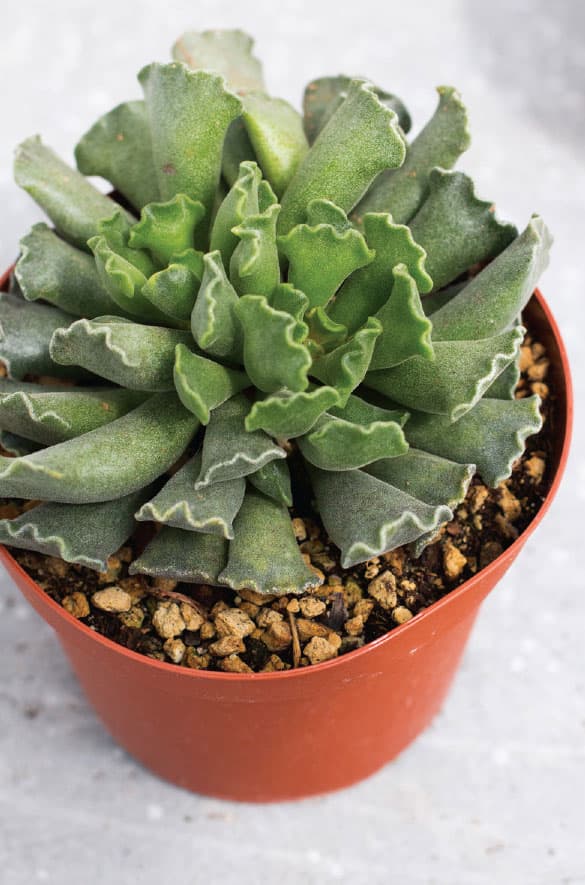
Aeonium arboreum ‘Zwartkop’
BLACK ROSE AEONIUM
FAMILY: Crassulaceae
ORIGIN: Canary Islands
CULTURE: Prefers full sun, coastal and light shade in hottest inland locations. Needs an open, porous soil and regular watering from fall to spring. Reduce water to occasionally in summer and provide some light shade if possible. Protect from frost.
COLD HARDINESS: 30°F (1.1°C)
PROPAGATION: By cuttings
BLOOM TIME: Summer
There is disagreement on the correct origin of the name—whether it is the Dutch Zwartkop or the German Schwartzkopf; however, both mean “black head” and are both generally accepted. This is likely the most recognizable of all the aeonium cultivars and hybrids, with its incredibly dark purple to near-black, rubbery leaves. Unlike most other succulents, black rose is a winter-growing species that is semi-dormant in summer and early fall when foliage is at its darkest. The summer bloom is an amazing large, cone-shaped inflorescence of thousands of small yellow, star-shaped flowers. Like many aeoniums, ‘Zwartkop’ is monocarpic, meaning that the stem that is blooming will die when the flowers are done. Lower, non-blooming stems typically carry on blooming the following year. The bottom right photo shows an interesting unknown A. arboretum hybrid or cultivar.
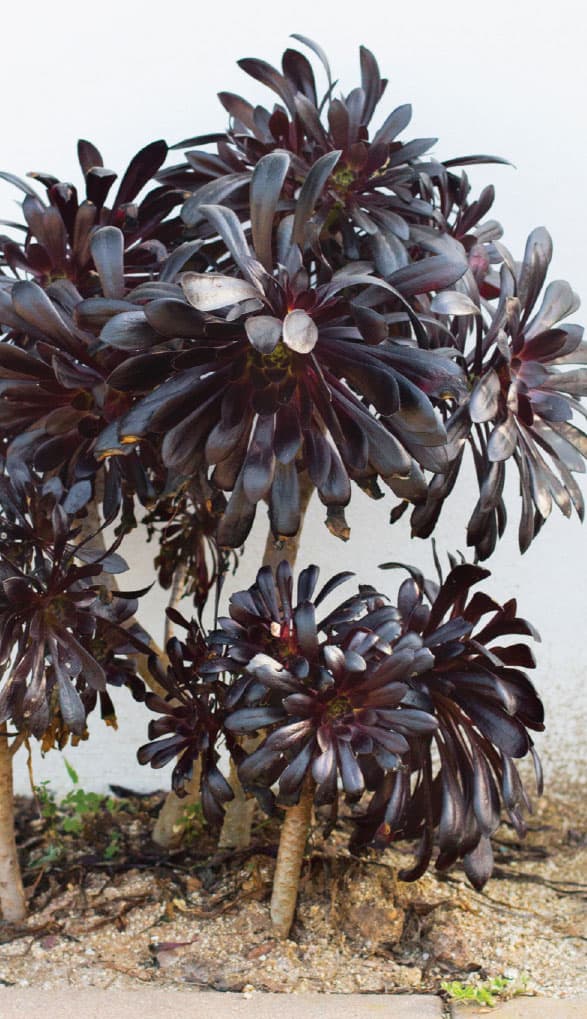
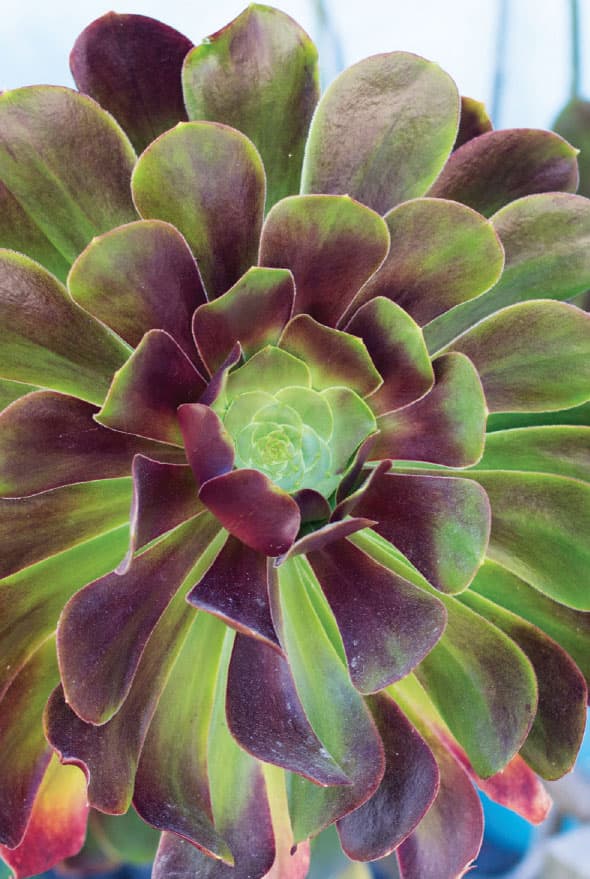
Aeonium haworthii Hybrid
‘KIWI’
FAMILY: Crassulaceae
ORIGIN: Canary Islands
CULTURE: Prefers full sun, coastal and light shade in hottest inland locations. Needs an open, porous soil and regular watering from fall to spring. Reduce water to occasionally in summer and provide some light shade if possible; slight cold hardiness but best to protect from frost.
COLD HARDINESS: 25° to 30°F (–3.9 to –1.1°C)
PROPAGATION: By cuttings
BLOOM TIME: Spring
Always popular, this is one of the easiest and most attractive of the aeoniums. It is a highly branching, sub-shrub-type plant with highly colorful rosettes of lime green and yellow with crimson-red leaf margins. It can readily grow 2' to 3' (0.6 to 0.9 m) tall and about 2' (0.6 m) wide over time. When planted in combination with the darker aeoniums, like ‘Zwartkop’, it creates a breathtaking visual contrast. The actual name and identity of this aeonium is somewhat murky and still contested. It can be found as A. percarneum ‘Kiwi’ as well as A. haworthii ‘Tricolor’. The frequently used A. haworthii hybrid is equally undefined regarding whether it is a natural or man-made hybrid. Needs full sun, well-draining soil, and regular to occasional watering, it does have a fair hardiness to cold but is best protected from any extended hard frost.
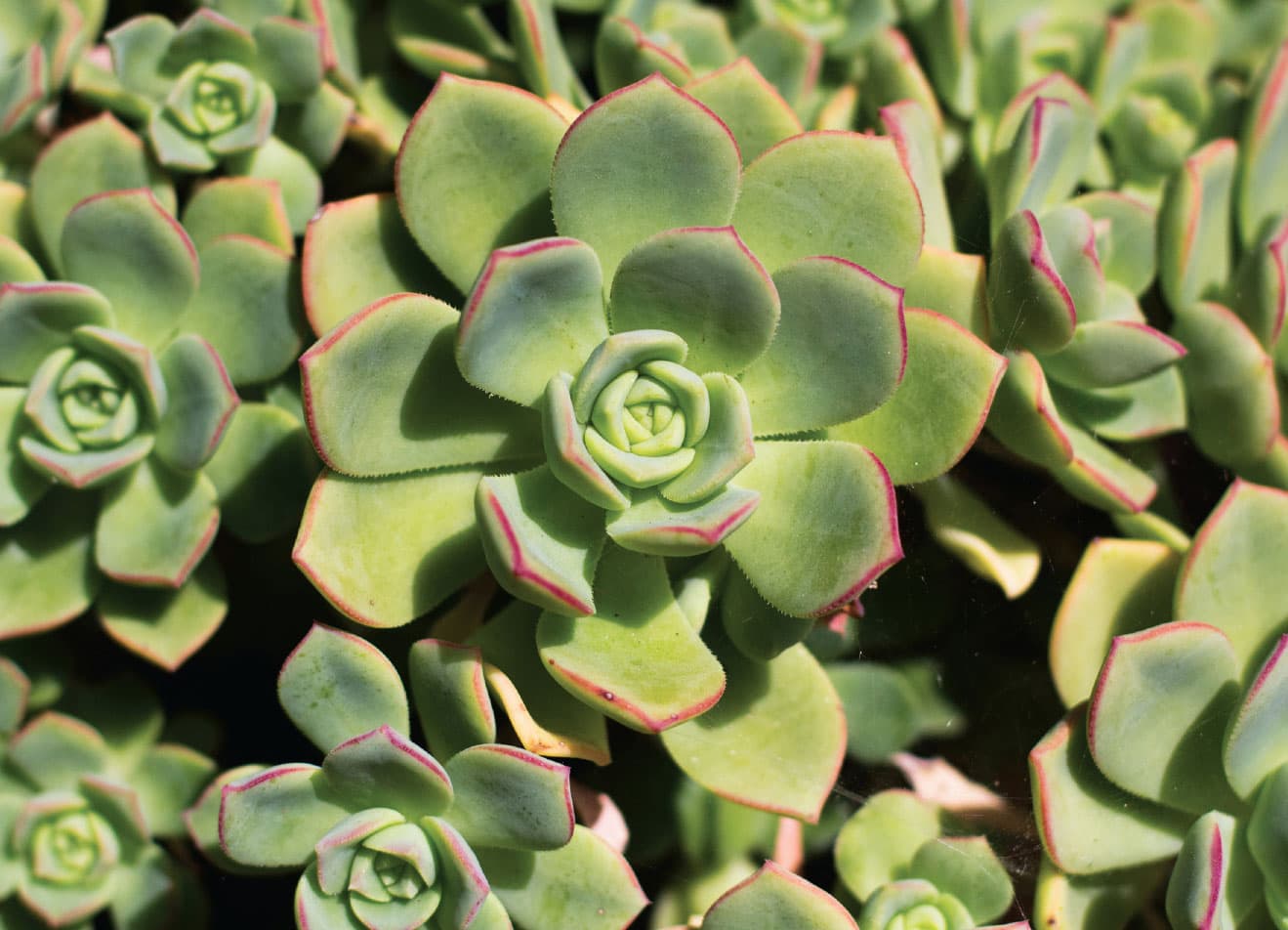

Aeonium Hybrid
‘MARDI GRAS’
FAMILY: Crassulaceae
ORIGIN: Nursery-grown hybrid
CULTURE: Prefers full sun in coastal locations, and light shade in the hottest inland locations. Needs an open, porous soil and regular watering from fall to spring. For best color, regular monthly feeding from fall to spring is recommended. Water only occasionally in summer and provide some light shade if possible. Best to protect it from frost.
COLD HARDINESS: 30° to 32°F (–1.1 to 0°C)
PROPAGATION: By cuttings
BLOOM TIME: Spring
This outstanding hybrid was created by Renee O’Connell of San Diego, California, after years of complex crossbreeding. The resulting plant is compact and early branching with kaleidoscopic rosettes. The leaves are a satiny yellow with apple-green mid-stripes. Further highlighting these colors are rose-painted margins that in cooler weather become a rich, dark burgundy. While most aeoniums are not heavy feeders, ‘Mardi Gras’ is at its best and most reliable color with regular monthly feeding with a diluted fertilizer during its active growth period of fall to spring. With aeoniums generally being monocarpic and dying after the main head flowers, the multiple branching helps to mitigate this problem. Like most others, it is summer dormant. The bulk of species aeoniums originate in the Canary Islands.
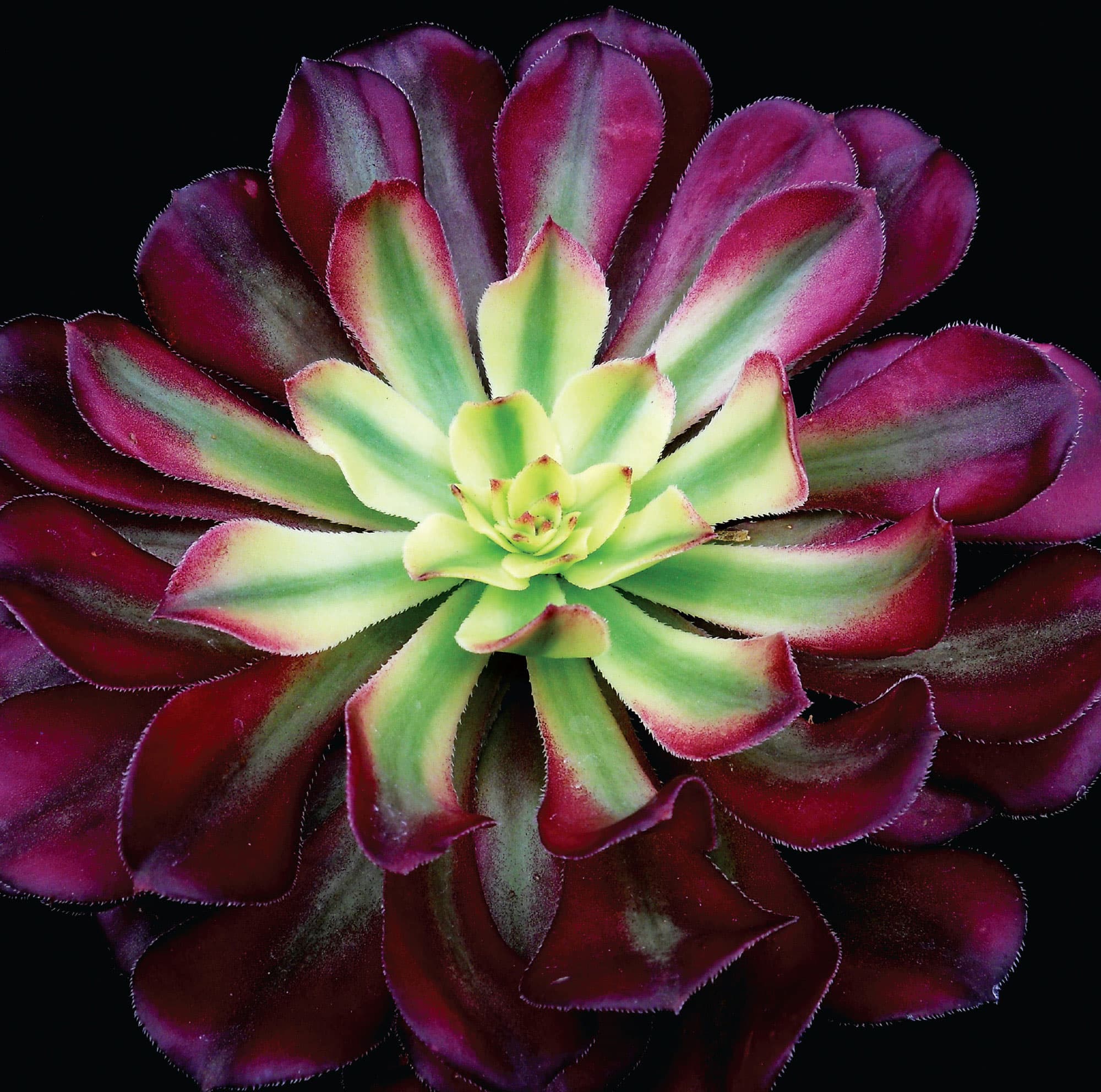
Agave
‘CONFEDERATE ROSE’
FAMILY: Asparagaceae
ORIGIN: Mexico
CULTURE: Best performance is in full sun with well-draining soil. Responds well to watering during the spring through summer active growth period. Needs infrequent watering once established but looks better with supplemental watering in the hottest of months. Watering should be reduced in winter, and it should be protected from hard frosts.
COLD HARDINESS: 30°F (–1.1°C)
PROPAGATION: By offsets
BLOOM TIME: Infrequently, at maturity
This is a terrific small century plant that is anything but shy when it comes to making offsets, or “pups.” It is highly prolific, forming dense clumps or colonies in a fairly short amount of time. These compact, very blue-gray rosettes rarely reach 12" wide, making them a favorite container agave. As attractive as they are, they are heavily armed with marginal teeth and a vicious terminal spine. No species name is called out on this plant, as the actual species is the subject of a lengthy and, as yet, undetermined debate. It had been thought to be a cultivar of A. parrasana; however, most recent opinions are leaning to it being a cultivar of A. potatorum.
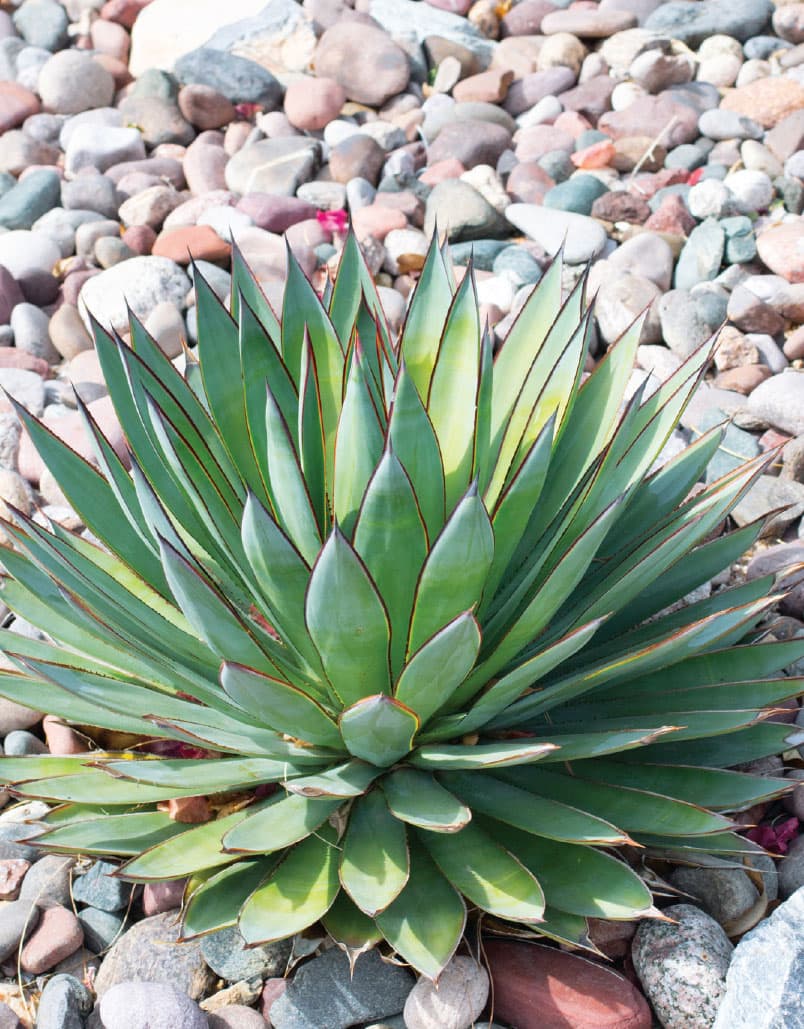
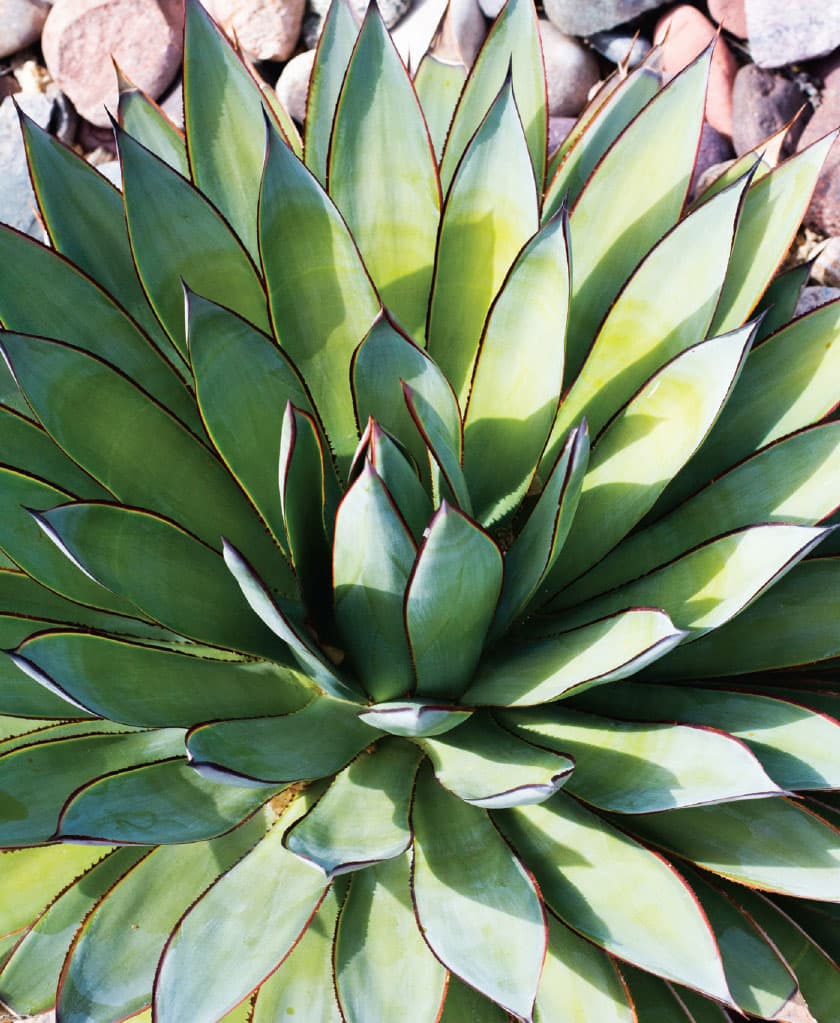
Agave Hybrid
‘BLUE GLOW’
FAMILY: Asparagaceae
ORIGIN: Mexico
CULTURE: Best performance is in full sun with well-draining soil. Responds well to watering during the spring through summer active growth period. Needs infrequent watering once established but looks better with supplemental watering in the hottest of months. Watering should be reduced in winter.
COLD HARDINESS: 25°F (–3.9°C), possibly lower
PROPAGATION: By offsets
BLOOM TIME: Infrequently, at maturity
A relatively new hybrid from breeder Kelly Griffin of San Diego, this plant is a result of the combination of A. attenuata crossed with A. ocahui. Unlike most hybrids, this one curiously does not really resemble either parent in any overtly obvious way. Blue-green leaves less than 2"(5.1 cm) wide have red margins edged with yellow and bear tiny soft spines. Each leaf is tipped with a short red spine. The namesake ‘Blue Glow’ is most expressed with any type of backlighting from the sun. The red and yellow leaf margins truly “glow” in this exposure. This is more of a medium-size century plant about 2' tall by 3' wide (0.6 m tall by 0.9 m wide). This plant should not be confused with the hybrid ‘Blue Flame’, which is a much larger plant.
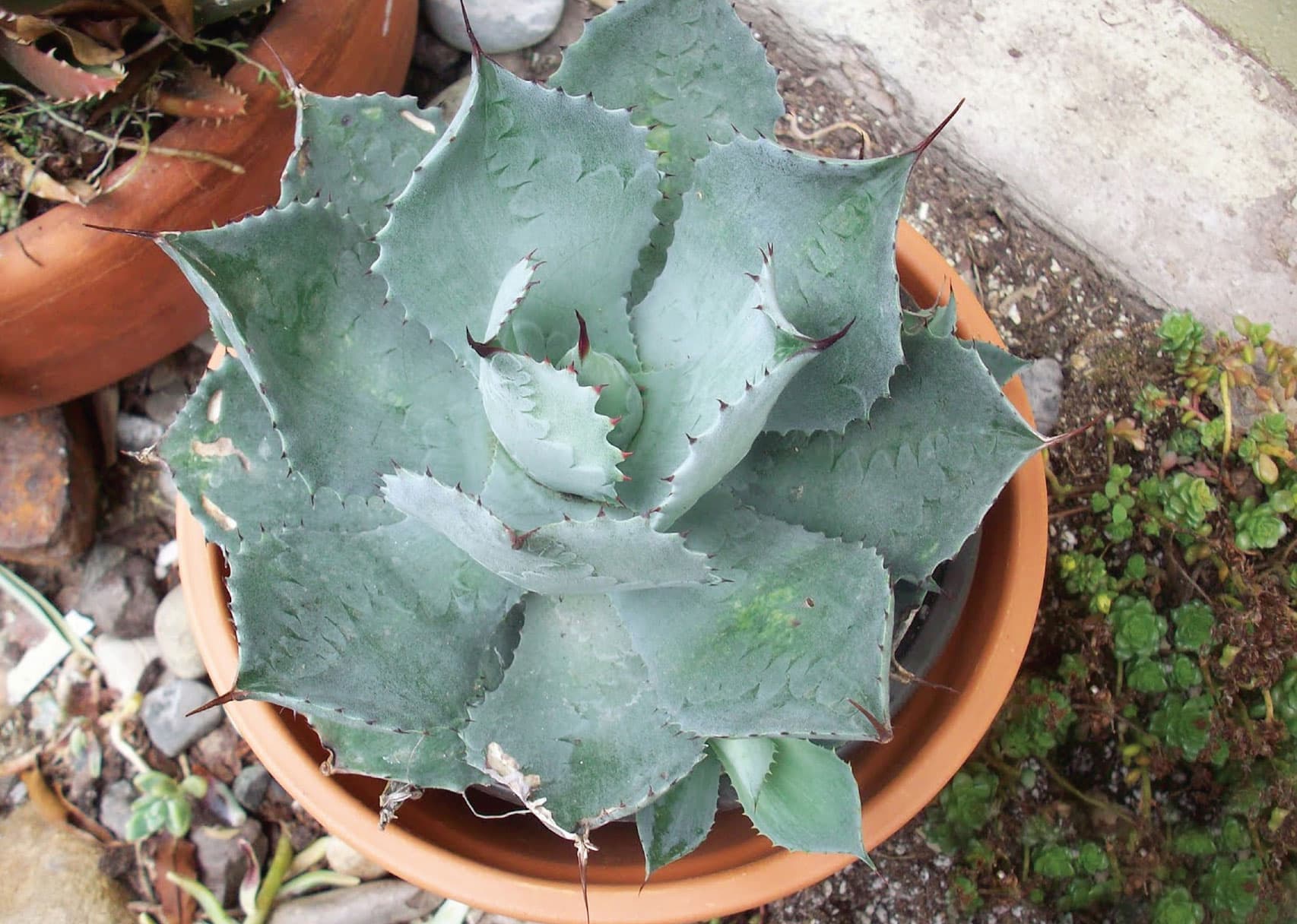
Agave lophantha ‘Quadricolor’
QUADRICOLOR CENTURY PLANT
FAMILY: Asparagaceae
ORIGIN: Mexico
CULTURE: Best performance is in full sun with well-draining soil. Responds well to watering during the spring through summer active growth period. Needs infrequent watering once established but looks better with supplemental watering in the hottest of months. Watering should be reduced in winter.
COLD HARDINESS: 15°F (–9.4°C)
PROPAGATION: By offsets
BLOOM TIME: Infrequently, at maturity
Here is an amazingly beautiful, smaller agave that is not only a stunner in the landscape but also perfectly suited to container growing. Only reaching 1' to 2' (0.3 m to 0.6 m) tall and wide, it is a riot of color. Each leaf has wide yellow margins with a dark green midsection that is split down the center with a light green stripe. The very edge of the leaf is armed with small, red-brown teeth that become redder in times of stress, such as extreme heat, cold, or drought. Agave lophantha ‘Quadricolor’ makes a dazzling specimen either in a container or in the ground from Zone 8 south.
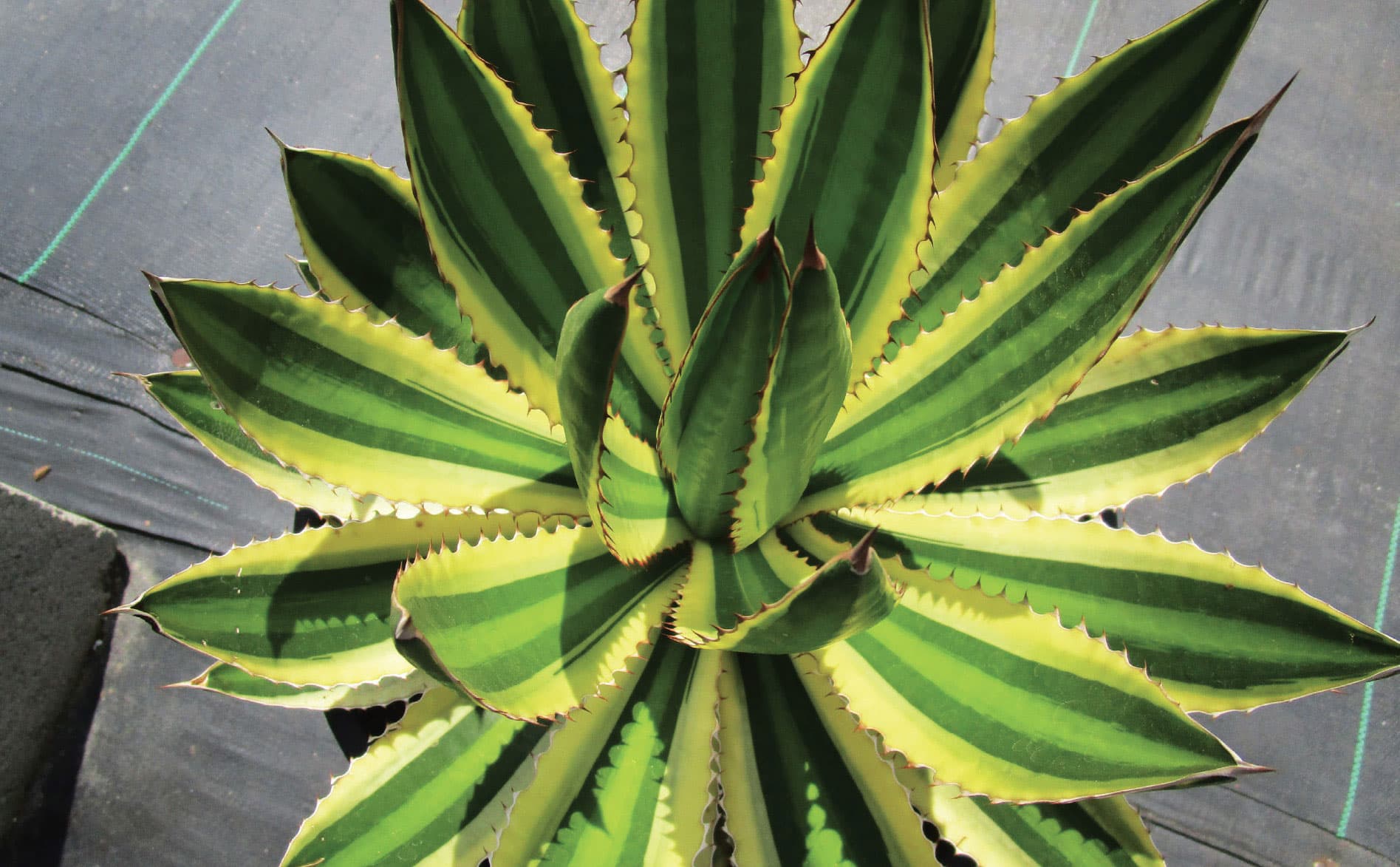
Agave victoriae-reginae
QUEEN VICTORIA AGAVE
FAMILY: Asparagaceae
ORIGIN: Mexico
CULTURE: Best performance is in full sun or light shade with well-draining soil. Responds well to watering during the spring through summer active growth period. Needs infrequent watering once established but looks better with supplemental watering in the hottest of months. Watering should be reduced in winter.
COLD HARDINESS: 15°F (–9.4°C)
PROPAGATION: By offsets, seed
BLOOM TIME: Infrequently, at maturity
Less than 1' (0.3 m) tall and less than 2' (0.6 m) wide, this is one of the most attractive Agaves in existence, with an outstanding symmetry displayed by its densely packed leaves. Very thick geometric leaves, with a noticeable keel, are marked with pure white margins and repetitive white-lined patterns on the keel side. This is a favorite visual ornamental. Should it flower, which usually is after many years, it puts forth, for a fairly small plant, a very tall, unbranched spike that can reach to 15' (4.6 m) tall! It has densely packed reddish purple flowers. After flowering, unless it has previously put out some offsets, the blooming plant will have to be replaced. There are also other uniquely beautiful variegated forms, such as ‘Golden Princess’ and ‘White Rhino’.
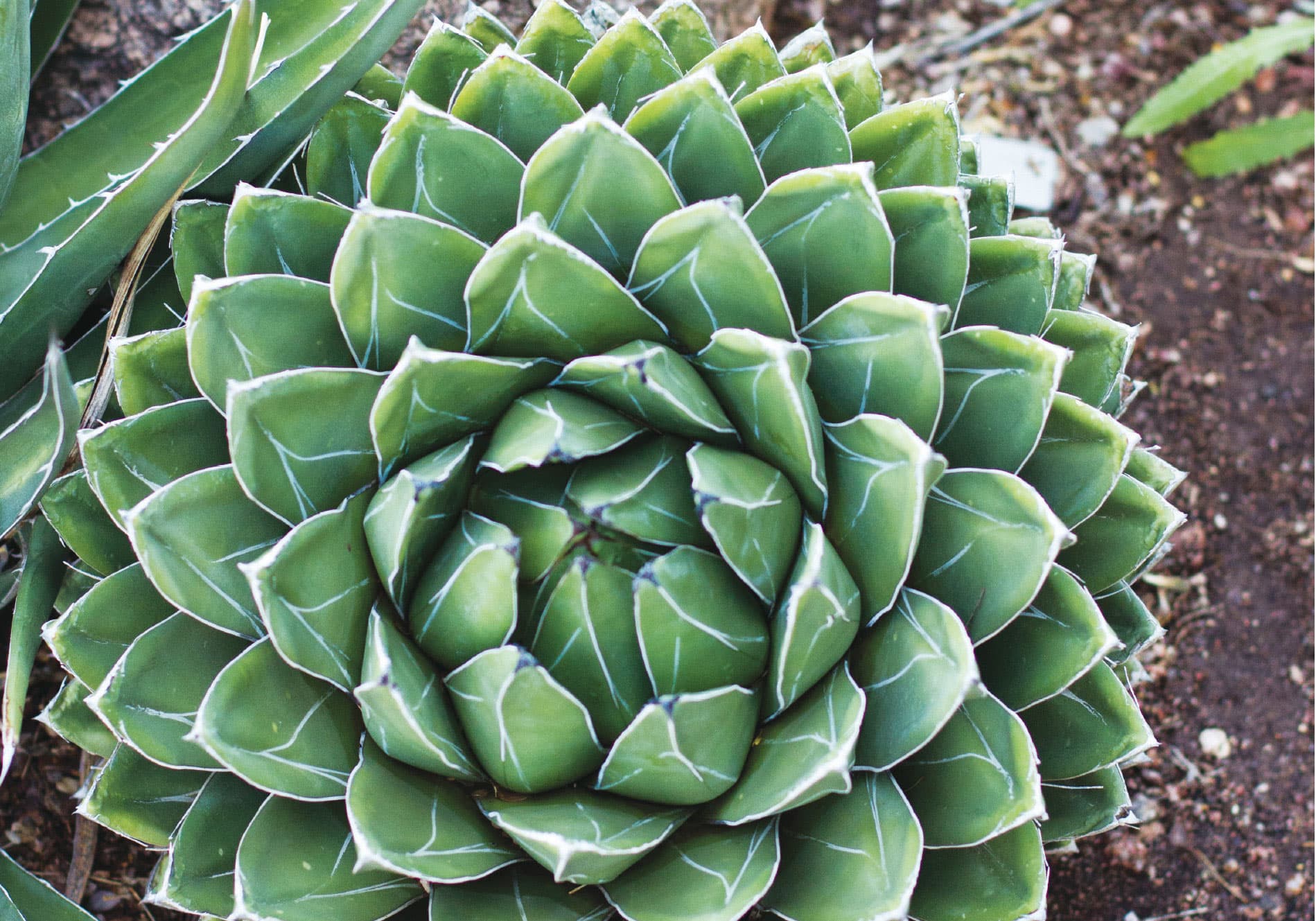
Alluaudia procera
MADAGASCAN OCOTILLO, FALSE OCOTILLO
FAMILY: Didiereaceae
ORIGIN: Madagascar
CULTURE: Best performance is in full sun or light shade with well-draining soil. Responds well to watering during the spring through summer active growth period. Needs infrequent watering once established but looks better with supplemental watering in the hottest of months. Watering should be reduced in winter.
COLD HARDINESS: 25°F (–3.9°C)
PROPAGATION: By cuttings
BLOOM TIME: Infrequently
Like nearly everything else in Madagascar, this is a fascinating, unusual plant. Occasionally branching, this is typically an upright, unbranched plant that can grow 15' to 25' (4.6 to 7.6 m) tall in nature but is usually shorter in cultivation. In its native habitat in the spiny forests of southwestern Madagascar, there are reports that the plant can reach to 60' tall. The typical trunk or stem diameter is 1" to 2" (2.5 to 5.1 cm), with the base becoming much larger over time to support the upright growth. The stems are covered top to bottom with rows of spines, and after the rainy season, a pair of small oval leaves sprout below each spine. The most interesting part is the leaf orientation. After losing all leaves to conserve moisture and water loss after the seasonal rains have gone, the plants remain leafless and semi-dormant until the next rains. When the rains return, any new length of the stem that was added from the previous growing season sprouts leaves that are horizontal to the ground to stop and catch as many raindrops as possible. All other leaves down the entire length of the plant emerge vertically to direct the rainwater from the top straight down to the root zone. In the following season, those leaves that were horizontal become vertical, with new horizontal leaves above them!
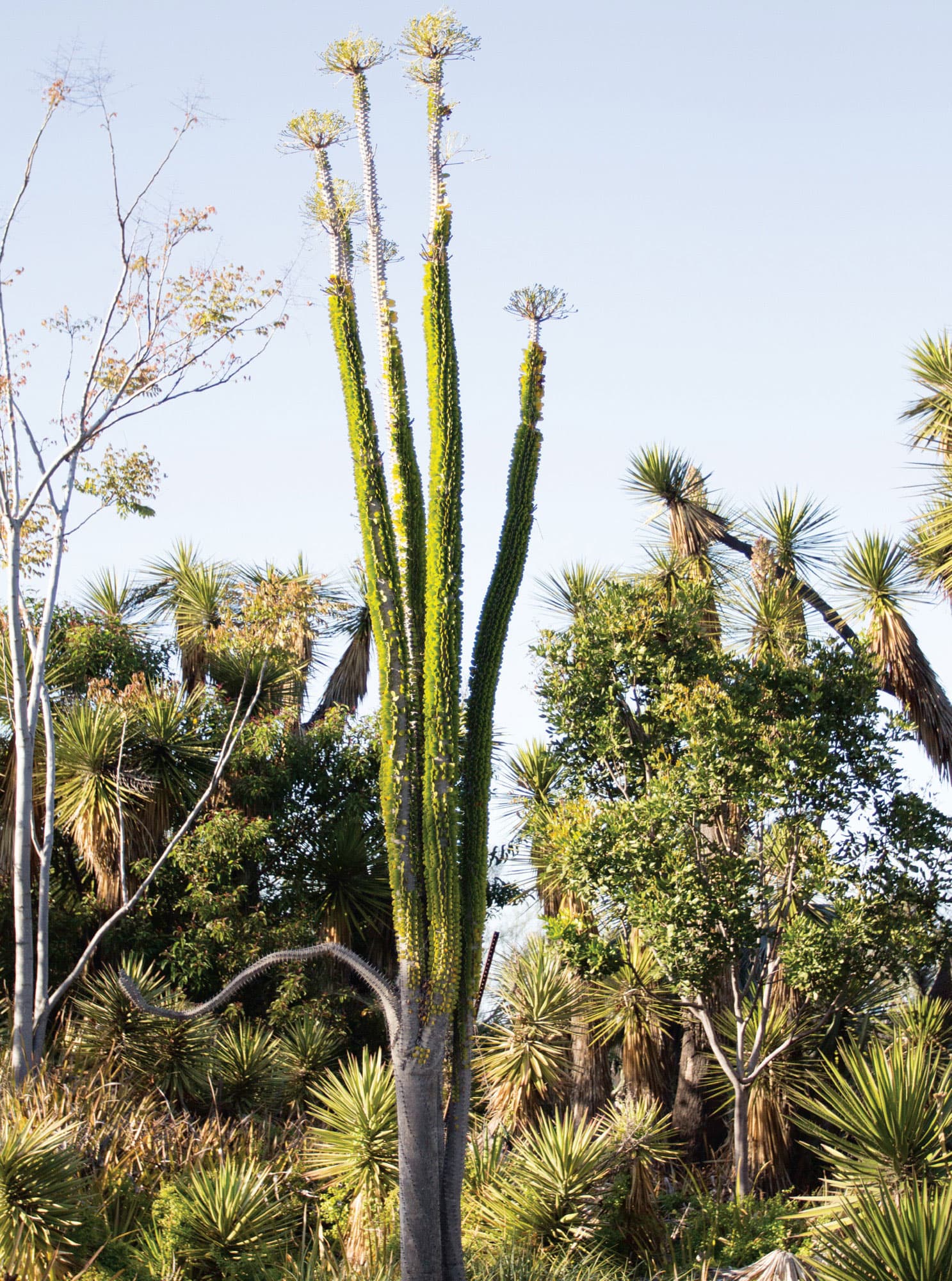
Aloe barbadensis
MEDICINE PLANT, ALOE VERA
FAMILY: Asphodelaceae
ORIGIN: North Africa, Arabian Peninsula
CULTURE: Grow in full sun to light shade with porous, well-draining soil. Water regularly to occasionally spring to fall, allowing the soil to dry before watering again. Keep on the dry side in winter, watering only occasionally, and protect from frost.
COLD HARDINESS: 35°F (1.7°C)
PROPAGATION: By seed, offsets
BLOOM TIME: Summer
Very few succulents—in fact, possibly no other succulents—are as well known as Aloe barbadensis, more commonly known as aloe vera. The health and medicinal properties of this plant are known and used globally. They include burn treatment, lowering blood sugar, natural laxative, and heartburn relief. Because of this, it is found growing well outside of its native habitat in tropical areas everywhere. Grown as a houseplant, it needs an extremely sunny, bright location to remain healthy. Grown outdoors where possible, plants can reach 2' (0.6 m) tall and in full sun take on a light coppery-bronze color. Flowers appear on a spike held above the plant and are yellow and tubular, much to the delight of hummingbirds.
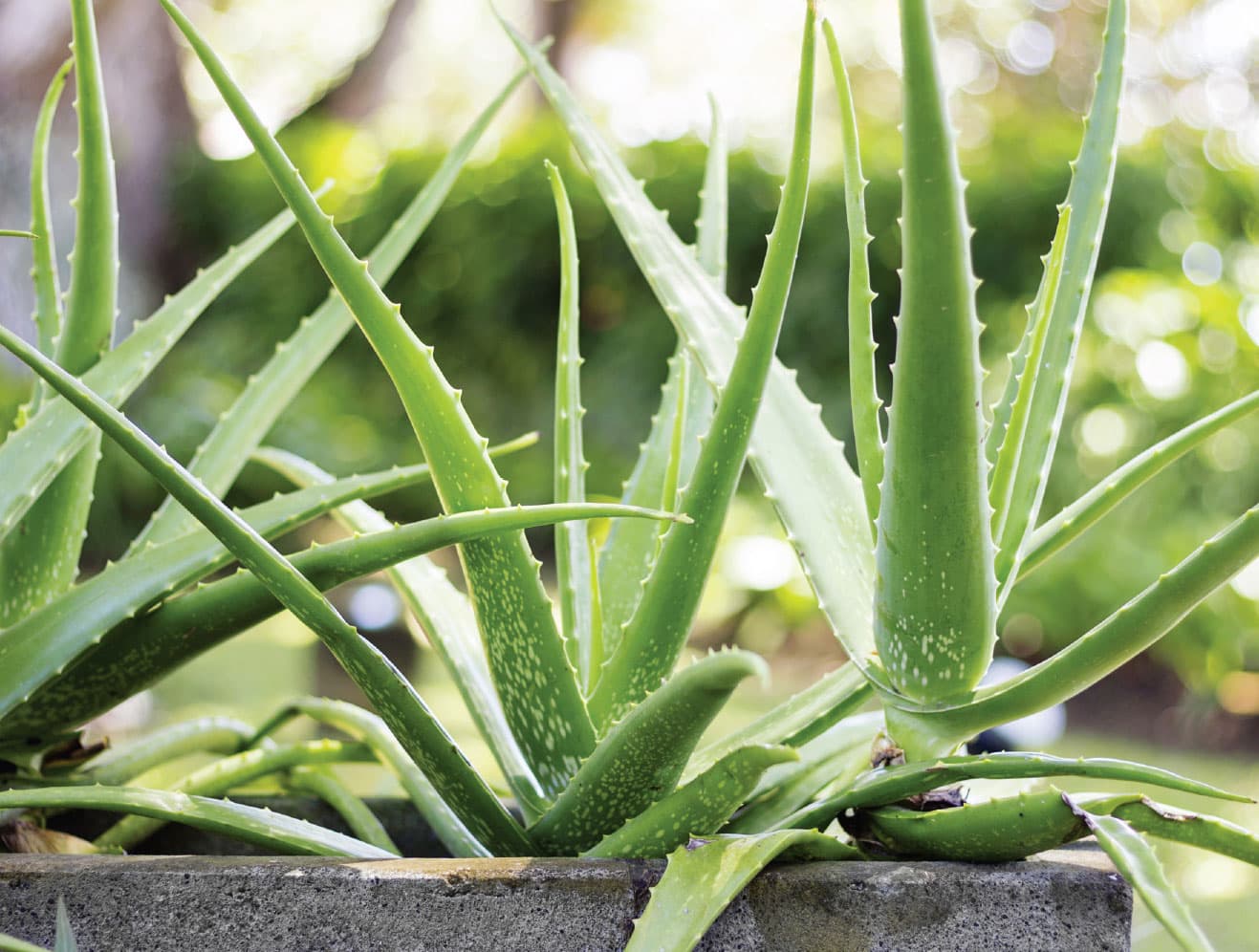

Aloe barberae
GIANT TREE ALOE
FAMILY: Asphodelaceae
ORIGIN: South Africa
CULTURE: Plant in full sun or light shade in a fairly well-drained soil and water only occasionally to infrequently once established. Water little to none in the winter.
COLD HARDINESS: 25°F (–3.9°C)
PROPAGATION: By seed, cuttings
BLOOM TIME: Fall to winter
The largest, grandest of the tree-like aloes, A. barberae makes an impactful architectural statement where it can be grown outdoors. This is a relatively fast-growing tree that develops a thick buttressed base to support the weight of the wide canopy. Branching nearly always occurs at the point where a previous bloom spike has appeared, thus constantly creating more and more potentially blooming branches. An impressive canopy is quickly created. The flowers are an attractive peach color on an inflorescence about 1' (0.3 m) long. This is not a messy plant, which makes it a favorite for use by pools and walkways. It actually grows quite well for a long time in a large container. There are a few exceptional hybrids of this species now available in cultivation: Aloe ‘Goliath’ (A. barberae × A. vaombe) and Aloe ‘Hercules’ (A. barberae × A. dichotoma). These are attractive plants with a shorter, more compact habit. Aloe barberae is often still found listed by the previous name of Aloe bainesii.
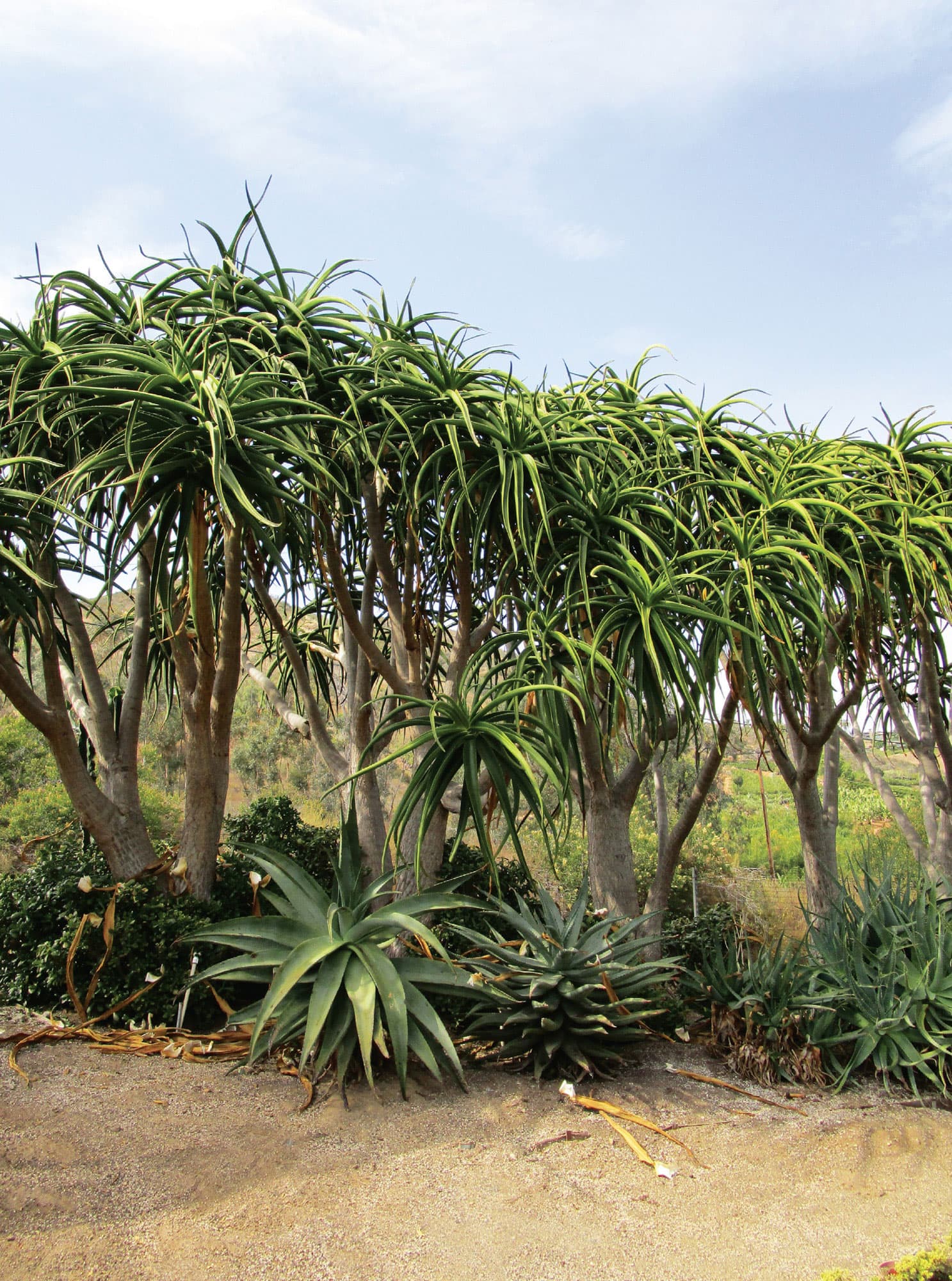
Aloe Hybrid
‘BLIZZARD’
FAMILY: Asphodelaceae ORIGIN: Nursery hybrid
CULTURE: Needs full sun to light shade with an open, well- draining soil. Water thoroughly during warmer months and allow soil to dry before watering again. Reduce watering in winter and protect from frost.
COLD HARDINESS: 28°F (–2.2°C)
PROPAGATION: By offsets
BLOOM TIME: Fall to winter
Attention-getting and cute as a button, this is one blizzard that gardeners can welcome. This striking little aloe hybrid was created by Renee O’Connell of San Diego using Aloe ‘Doran Black’ and another proprietary hybrid of her creation. Perfect for container growing and indoor culture with sufficient light, this has a very compact, upright habit. The foliage is barred with snow white and narrower dark green bands. Plants should be protected from afternoon sun in hot climates. It not only blooms in fall and winter but off and on through the year as well. The flowers are an orange, coral-apricot color. It freely produces offsets.
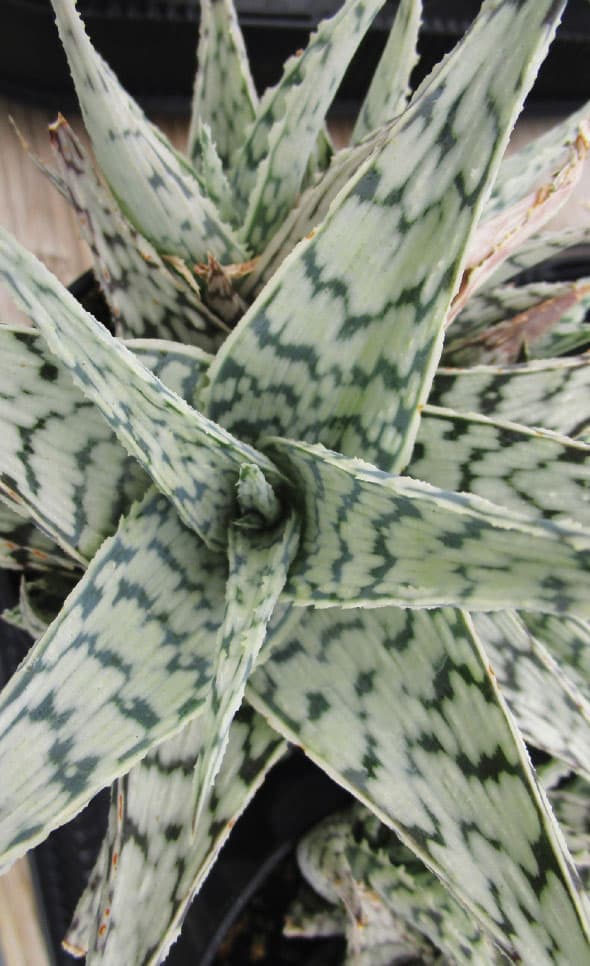
Aloe Hybrid
‘FIREBIRD’
FAMILY: Asphodelaceae ORIGIN: Nursery hybrid
CULTURE: Needs full sun to light shade with an open, well- draining soil. Water thoroughly during warmer months and allow soil to dry before watering again. Reduce watering in winter and protect from frost.
COLD HARDINESS: 28°F (–2.2°C)
PROPAGATION: By offsets
BLOOM TIME: Frequent, anytime
This is a blooming powerhouse and only 6" to 7" (15.2 to 17.8 cm) across with slender leaves and a loose habit. The olive-green leaves are only slightly dappled with light green to white dots and dashes. The flower stems hold small, extremely attractive, very bright tangerine flowers—their color is not a typical aloe pinky-orange. This hybrid was created by Shannon Lyons in the 1980s using A. descoingsii and A. thompsoniae. A superb choice for attracting hummingbirds.
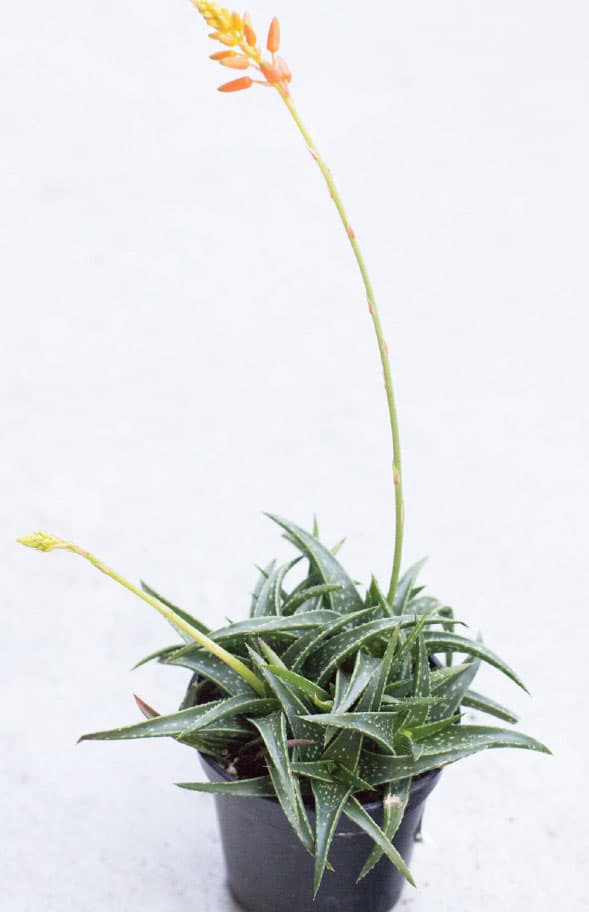
Aloe Hybrid
‘OIK’
FAMILY: Asphodelaceae
ORIGIN: Nursery hybrid
CULTURE: Needs full sun to light shade with an open, well- draining soil. Water thoroughly during warmer months and allow soil to dry before watering again. Reduce watering in winter and protect from frost.
COLD HARDINESS: 28°F (–2.2°C)
PROPAGATION: By offsets
BLOOM TIME: Fall to winter
Depending on the time of year and the amount of external stress from heat, cold, or drought, the short triangular leaves will favor either more of a blue or a green background color. In amazing contrast, the leaf surfaces are covered with raised singular or merged dark pink teeth appearing as raised, pointed dots and dashes. Teeth of the same dark pink color line the leaf margins. These are narrow and square to rectangular in various lengths, looking very reminiscent of the blade on a chainsaw—very unique. This is one of several hybrids created by Karen Zimmerman. The word oik, in its mildest sense, is British slang for a rowdy or unruly child.
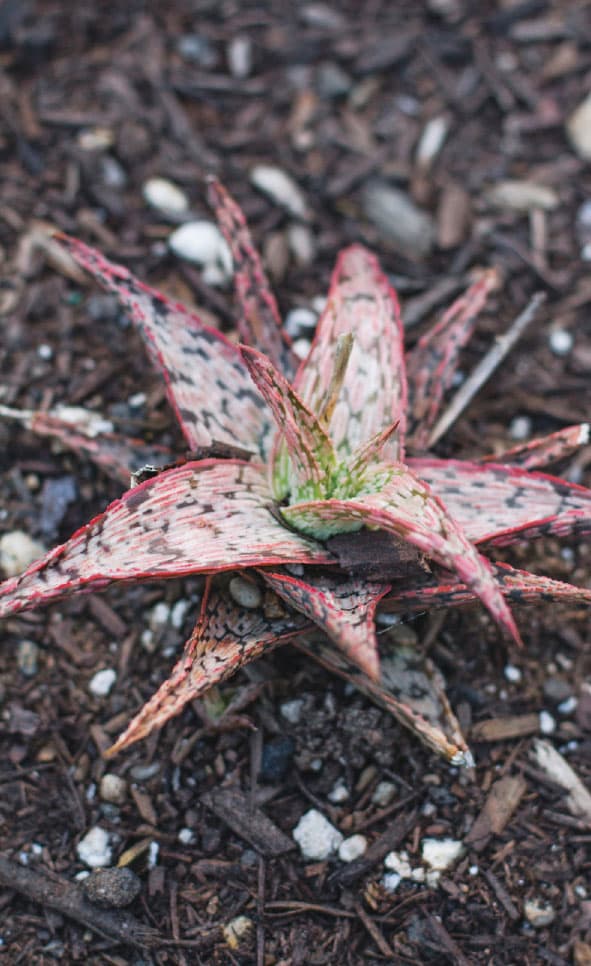
Aloe juvenna
TIGER TOOTH ALOE
FAMILY: Asphodelaceae
ORIGIN: Kenya
CULTURE: Grow in full sun to light shade with porous, well- draining soil. Water regularly to occasionally spring to fall (will appreciate more during the hottest months), allowing the soil to dry slightly before watering again. Keep on the dry side in winter, watering only occasionally, and protect from a hard frost.
COLD HARDINESS: 25°F (–3.9°C)
PROPAGATION: By cuttings
BLOOM TIME: Infrequently
Aloe juvenna is a small, clump-forming succulent. The leaves are speckled with light green and white irregular spots, and the margins are armed with light green to yellow showy teeth. In times of extreme heat, drought, or cold, the plant takes on a pleasant red blush. This aloe creates a dense colony that is suitable for both dry garden planting and containers. While the orange-red, small tubular flowers are appreciated by hummingbirds, they appear infrequently. Tiger tooth aloe is quite often found incorrectly labeled as Aloe zanzibarica.
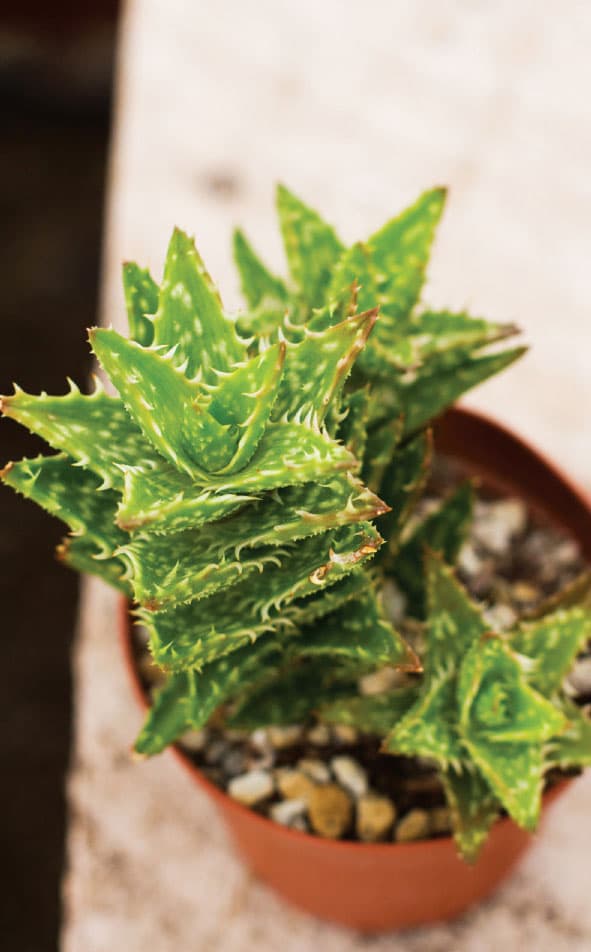
Aloe plicatilis
FAN ALOE
FAMILY: Asphodelaceae
ORIGIN: South Africa
CULTURE: Needs full sun in most locations, with light shade in hotter inland areas. Soil should be well draining; water occasionally during summer months. Reduce watering in the winter.
COLD HARDINESS: 25°F (–3.9°C)
PROPAGATION: By seed, cuttings
BLOOM TIME: Winter to spring
Primarily shrub-like and growing 4' to 8' (1.2 to 2.4 m) tall and approximately 6' (1.8 m) wide in regular cultivation, Aloe plicatilis can be taller and more tree-like in its native habitat. The habit is multiple branching, with each branch being topped with ranks of oppositely stacked leaves resembling 1'- (0.3 m) long, gray-green curved tongue depressors. Leaves with single plane symmetry give the appearance of a flat, folding fan. The trunk has corky, fire-resistant bark and the branches fork into pairs without a central leader, a pattern known as “dichotomous” branching. Each terminal leaf cluster will eventually bear a 1' to 2' (0.3 m to 0.6 m) flower spike supporting dozens of pink tubular flowers—a favorite of hummingbirds in the United States and sunbirds in its native habitat.
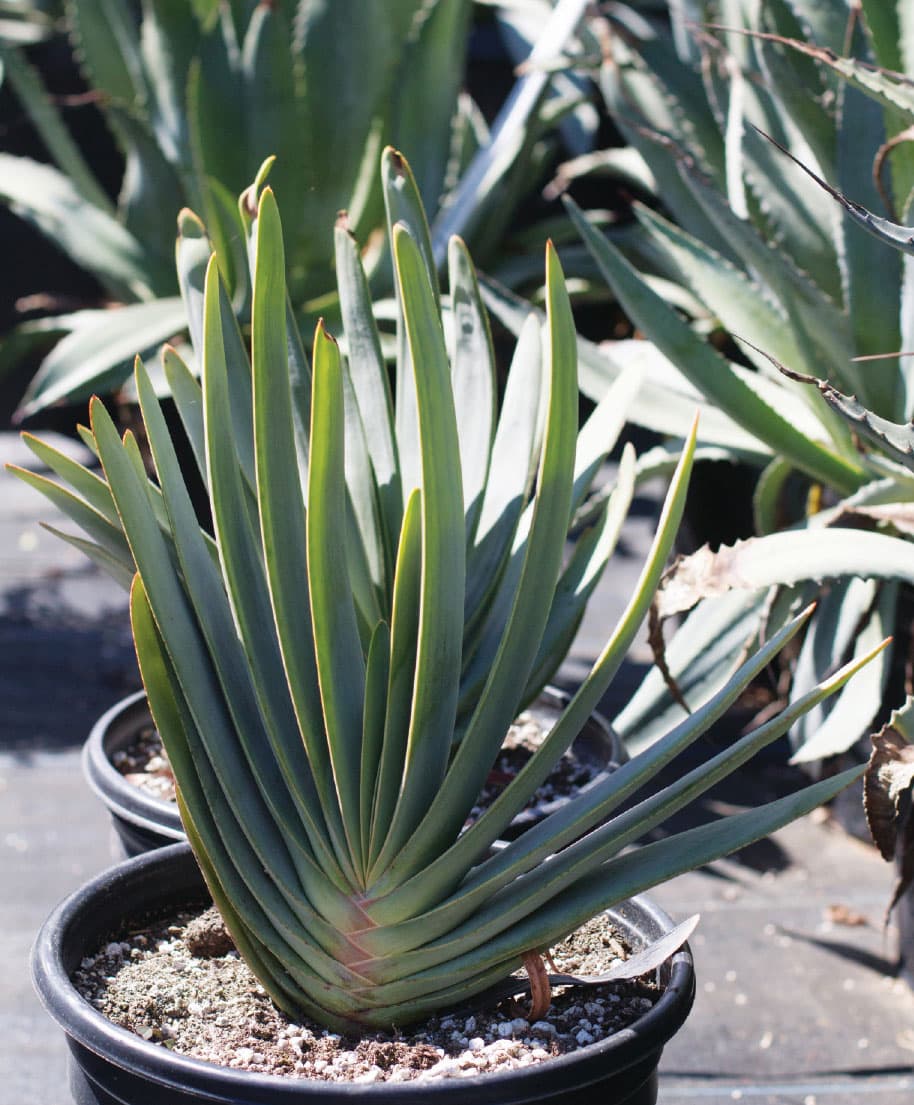
Aloe variegata
PARTRIDGE BREAST ALOE, TIGER ALOE
FAMILY: Asphodelaceae
ORIGIN: South Africa
CULTURE: Cool sun to light shade exposure with very well-draining soil. Little to occasional watering.
COLD HARDINESS: 20°–25°F
PROPAGATION: By seed, offsets
BLOOM TIME: Winter
Requiring less light than most other species in the genus, this unusual and beautiful aloe is one of the few that works well as a houseplant. A smaller aloe, it grows about 10 to 12" (25.4 to 30.5 cm) tall to 9" (22.9 cm) wide and forms rosettes with leaves arranged in three ranks that are upright with a boat-hull shape and a distinct indentation down the middle. Aloe variegata is so hardy that it can survive for several seasons with no water in the wild, although the leaves take on a reddish tinge and the plant won’t look happy. The common names come from the silvery speckles on the leaves. The tubular, nectar-laden coral flowers are held on a spike above the plant and are a favorite of hummingbirds.
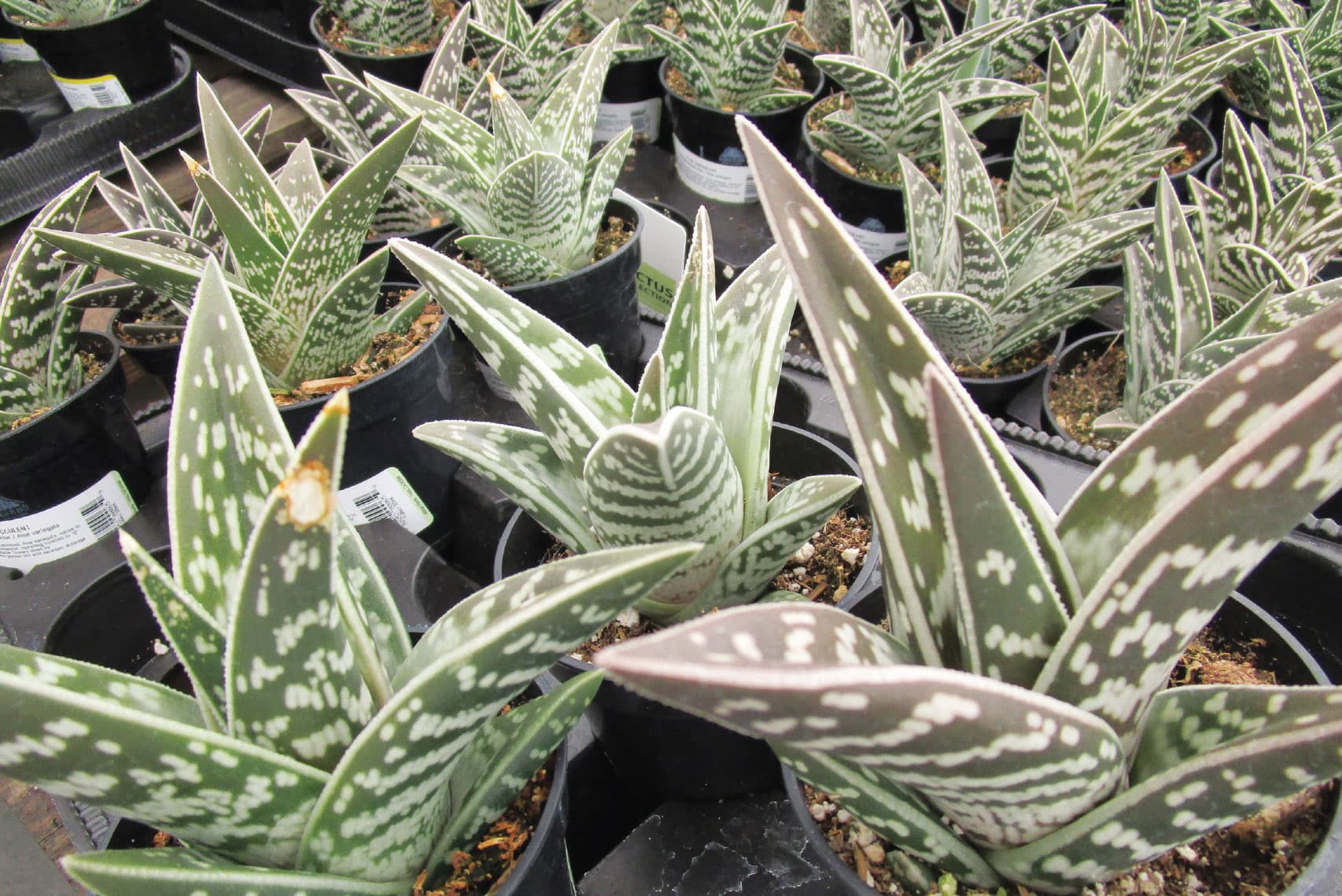
Anacampseros telephiastrum variegata
‘SUNRISE’
FAMILY: Portulacaceae
ORIGIN: South Africa
CULTURE: Does best in very bright light or filtered, dappled sun. Needs porous, well-draining soil and regular watering in the warmest months; allow the soil to dry slightly before watering again. Reduce watering in winter and protect from frost.
COLD HARDINESS: 35°F (1.7°C)
PROPAGATION: By cuttings
BLOOM TIME: Summer
Naturally, the form of this plant is rather drab in dark olive green with dark purple undersides, which helps it remain camouflaged against its native gravelly substrate to avoid being eaten by local wildlife seeking moisture. This beautiful form must come to market as a sport from a cultivated plant, as it would not survive predation in the wild. The small rosettes are almost jewel-like, glowing with intense rose, lime, and emerald green, with violet pink on the undersides of the leaves. In summer, 2" to 3" (5.1 to 7.6 cm) stems arise and support single or multiple buds, which become beautiful, relatively large pink flowers that are open for only a few hours in the afternoon. The plant’s rosettes are very tight and compact, but slowly and eventually take on a trailing habit with age.
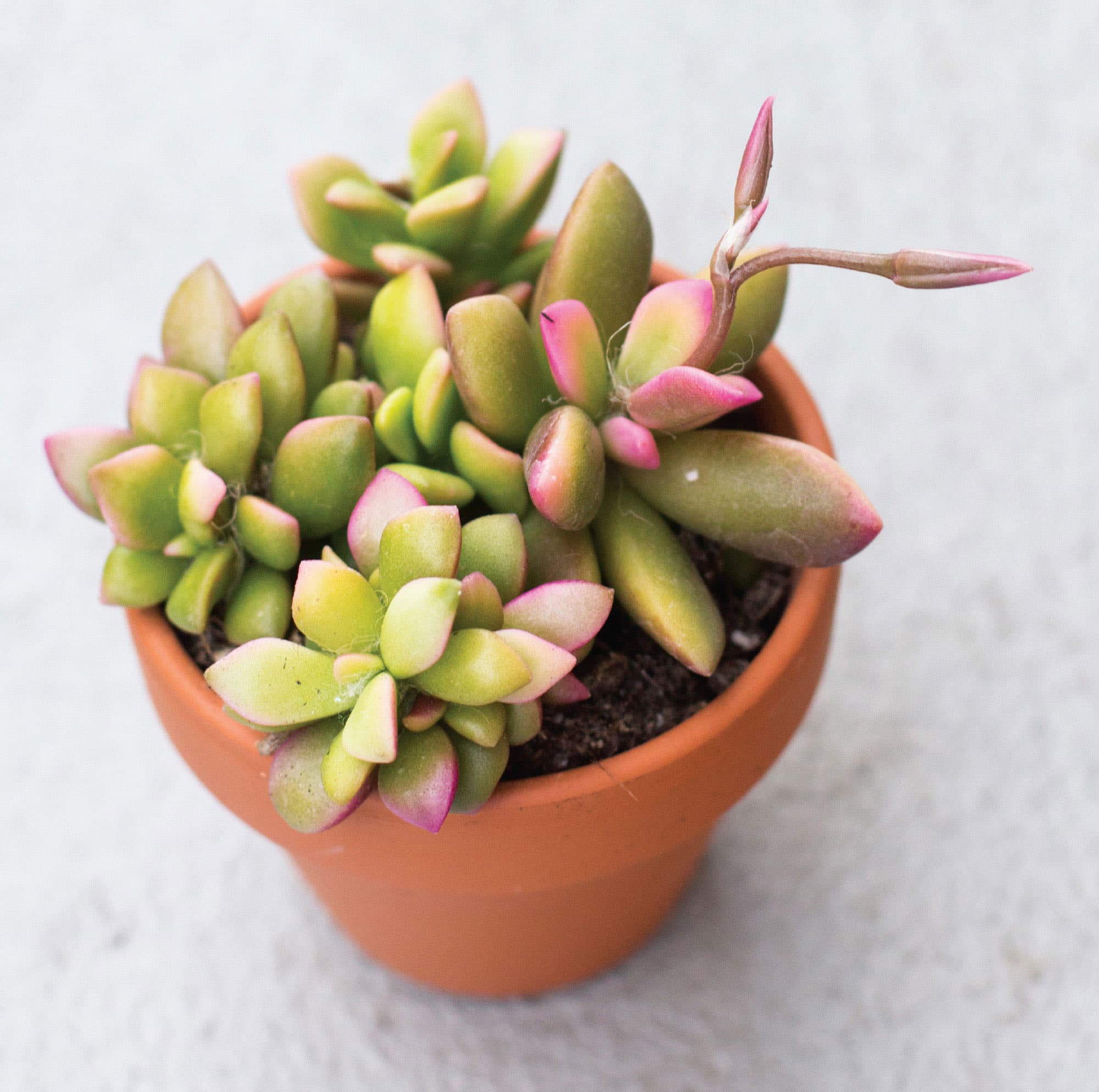
Astrophytum myriostigma
BISHOP’S CAP CACTUS
FAMILY: Cactaceae
ORIGIN: Northern and central Mexico
CULTURE: Grow in full sun to light shade with porous, very well-draining soil. Water sparingly from March until October and keep perfectly dry in winter.
COLD HARDINESS: 20° to 25°F (–6.7 to –3.9°C)
PROPAGATION: By seed only
BLOOM TIME: Intermittent spring through summer
This is a relatively slow-growing genus of cactuses usually seen as small plants; however, they can reach 2' to 3' (0.6 m to 0.9 m) tall over time, but they require a lot of patience to reach their full potential. Gray-white bodies of these cactuses have adapted to be colored much like the limestone sub- strate they grow on so that the plants are nearly invisible to potential predators. In bloom, it is topped with glossy yellow, sweet-scented flowers. Keep the soil dry as soon as temperatures start dropping in October, as it tends to rot at that time of year if kept wet. The thornless nature of this plant makes it a favorite of “spine shy” hobbyists. A. myriostigma has been the subject of passionate breeding and selection by the Japanese. The plant first arrived in Japan in 1868, just 30 years after its discovery, and the cultivars that have been grown are alien enough for the most obsessed collectors of oddities.
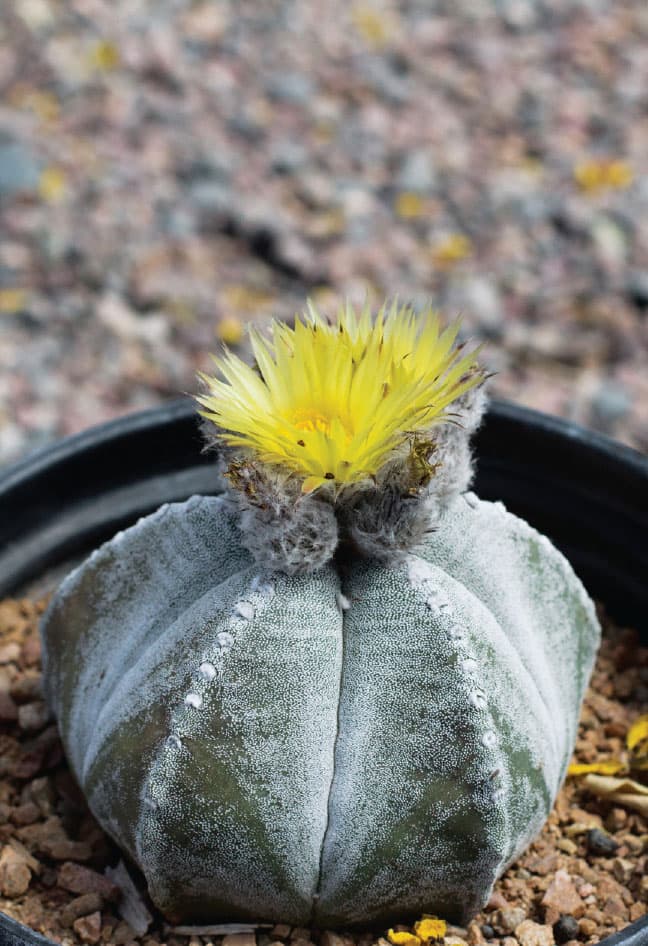
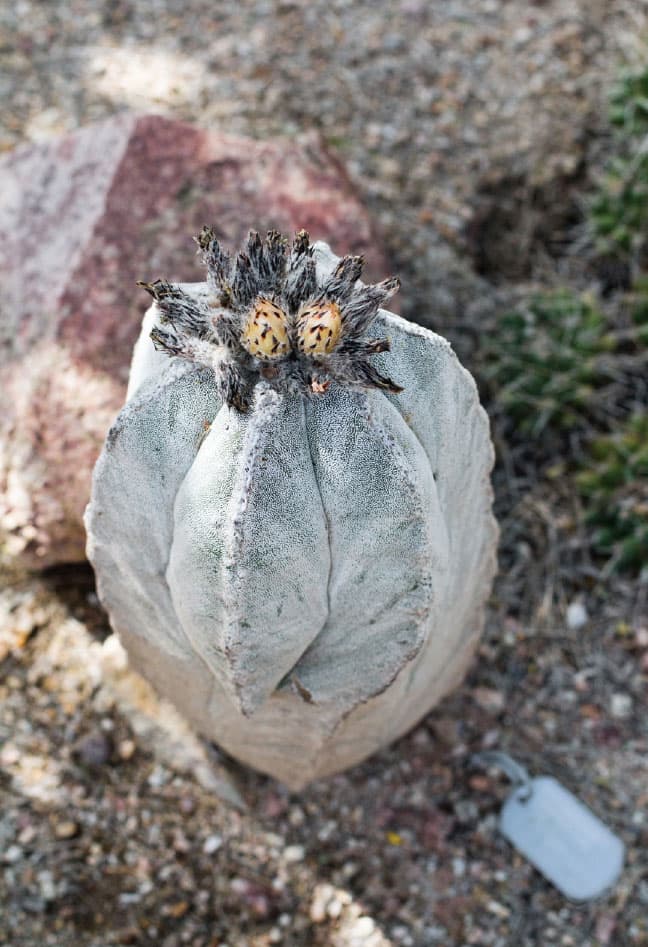
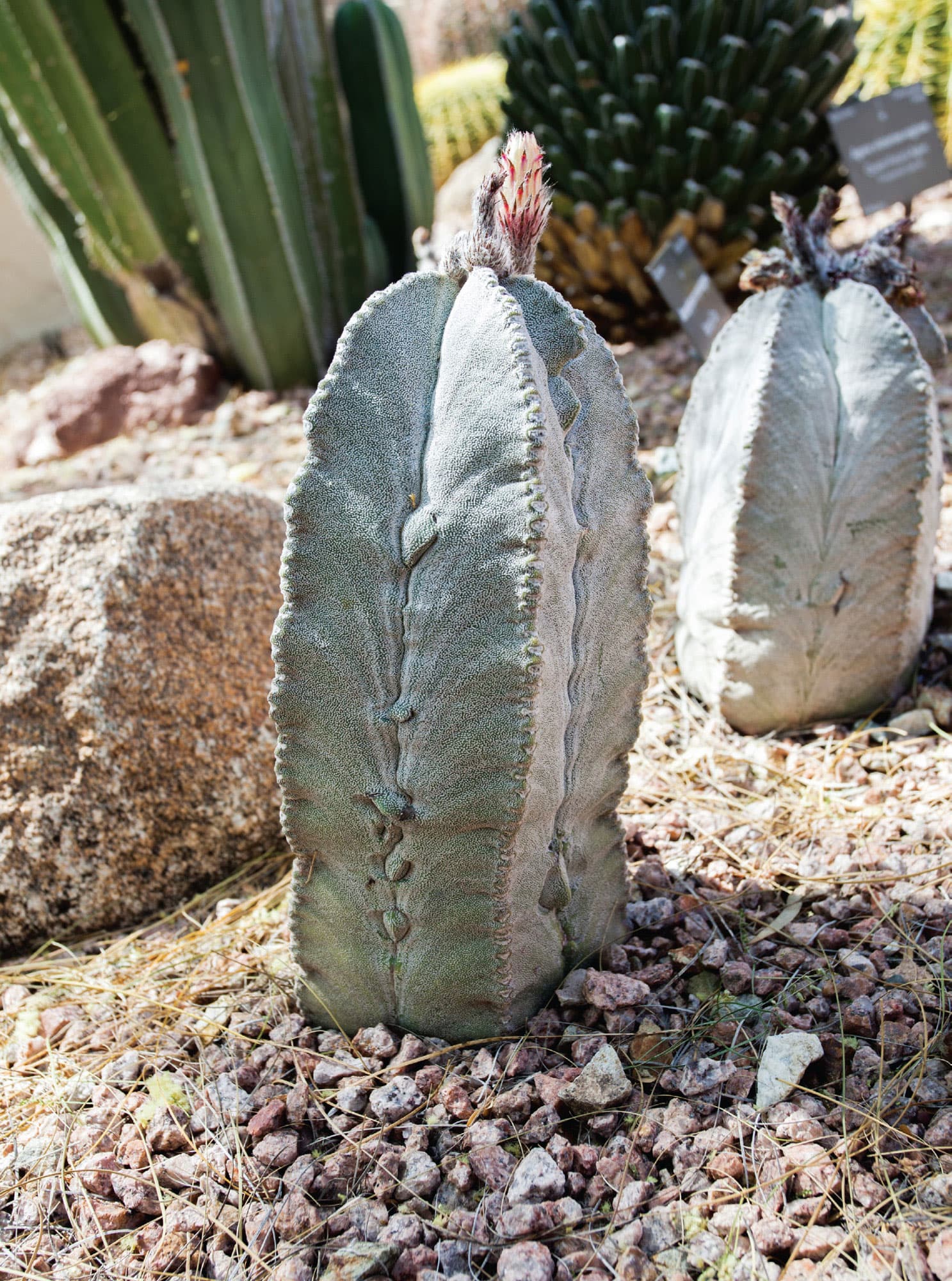
Bowiea volubilis
CLIMBING ONION, SEA ONION
FAMILY: Asparagaceae
ORIGIN: South Africa
CULTURE: Needs porous, well-draining soil and prefers full to part sun. Water regularly during growth period, winter to spring, allowing soil to dry out in betweeen. The plant is dormant in summer, so water little to none. Protect from frost.
COLD HARDINESS: 40°F (4.4°C)
PROPAGATION: By division
BLOOM TIME: Winter to spring
In its native habitat, the climbing onion is often covered in the local substrate, but it is much more interesting in cultivation with the bulb exposed above the soil. In late winter, the bulb develops a new, branched, scrambling or twining green flowering stem. Support is helpful, as this vine can top 6' (1.8 m) in length. Small star-shaped green flowers with an unpleasant aroma appear after the vine has extended. Once the plant has finished its growth it will go into dormancy, which is usually in the summer. At this time the vine will begin to dry, and the entire stem should be cut off at the bulb.
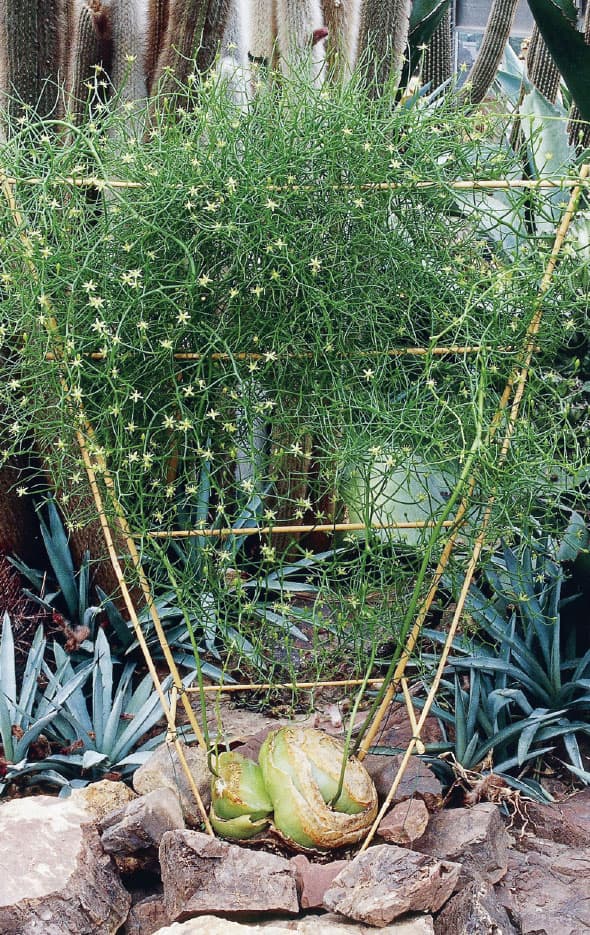
Cephalocereus senilis
OLD MAN CACTUS, OLD MAN OF MEXICO
FAMILY: Cactaceae
ORIGIN: Mexico
CULTURE: Needs very porous, well-draining soil and full to partial sun. Provide little to moderate water from spring to summer, and almost none in winter.
COLD HARDINESS: 20°F (–6.7°C)
PROPAGATION: By seed
BLOOM TIME: Spring
Googly eyes are often added to this plant as a novelty. One look at it captures the imagination of every cactophile. It is one of the most famous and recognized of the “Old Men” cactuses. It is extremely slow growing and in nature can take up to 20 years to reach 2' (0.6 m) tall. In cultivation, this is sped up somewhat with more consistent care. The long “hair” is a modification of the radial spines that give the plant extra protection from the sun, cold, or frost. The central spine is still present and quite a formidable defense. Taking at least 10 years to reach blooming maturity, flowers are rarely seen in cultivation.
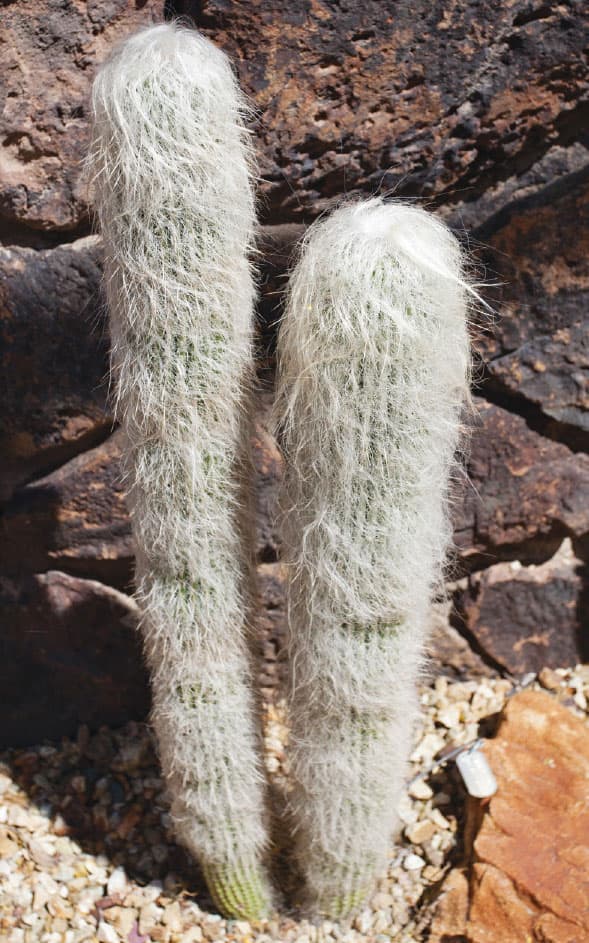
Cereus peruvianus/C. repandus
PERUVIAN APPLE CACTUS
FAMILY: Cactaceae
ORIGIN: South America
CULTURE: Needs porous, well-draining soil and regular watering during the warmer months; reduce watering in winter.
COLD HARDINESS: 28°F (–2.2°C)
PROPAGATION: By seed, cuttings
BLOOM TIME: Spring to summer
Peruvian apples make a useful landscape plant for frost-free locations or those with short, light frost events. It is fast growing, often 2' (0.6 m) or more per year, and becomes quite wide, branched, and tree-like. It enjoys more regular watering than most cactuses and produces very large, white, fragrant flowers. The added bonus of this cactus is the large, spineless, and delicious fruit! Like dragon fruit (Hylocereus spp.) but smaller, the round fruits ripen to a beautiful red color and are filled with a sweet white flesh flecked with tiny black, crunchy, edible seeds. The native name for the fruit in Latin America is pitaya.
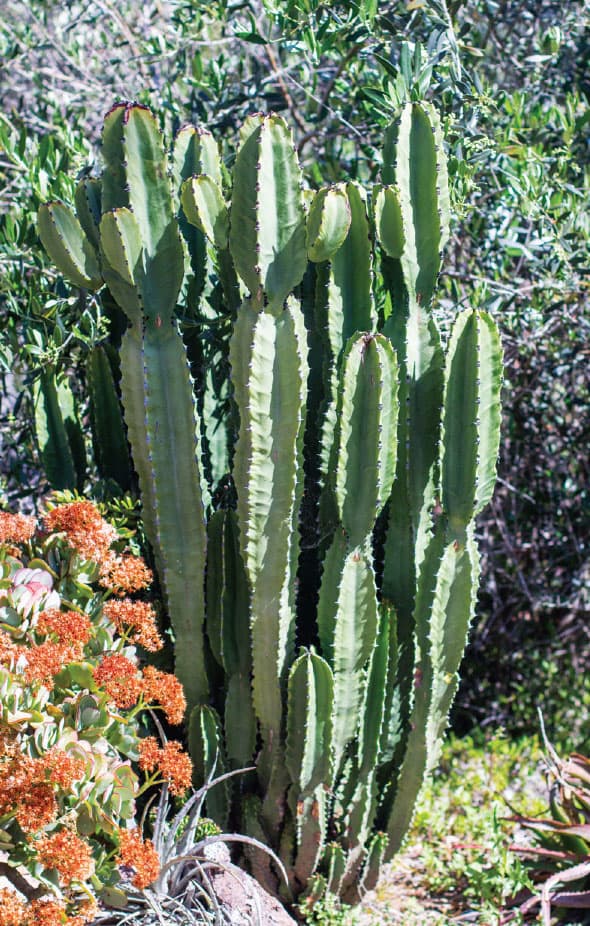
Ceropegia sandersonii
PARACHUTE PLANT, UMBRELLA PLANT
FAMILY: Apocynaceae
ORIGIN: Mozambique, South Africa
CULTURE: Needs full to part sun; porous, well-draining soil; and regular watering during the growth period (spring and summer), allowing soil to dry slightly before watering again. Reduce watering in winter and protect from frost.
COLD HARDINESS: 35°F (1.7°C)
PROPAGATION: By cuttings, seed
BLOOM TIME: Summer
Members of the Ceropegia genus are nature’s oddities. A trailing, vining plant, it has heart-shaped leaves and alien-looking flowers. Green with darker speckles and a slightly hairy margin, the petals remain attached at their tips, forming a tented tube with five openings around the perimeter. Simulating the scent of an injured bee, the flowers lure flies into the openings, which crawl down into the funnel-like tube, finding themselves covered in pollen and trapped by numerous downward-facing hairs. The flies remain there until the flower begins to end its bloom cycle and the hairs become too weak to resist their escape. They then crawl out and proceed to repeat the process, thus pollinating other flowers—a benevolent fly trap compared to some others.
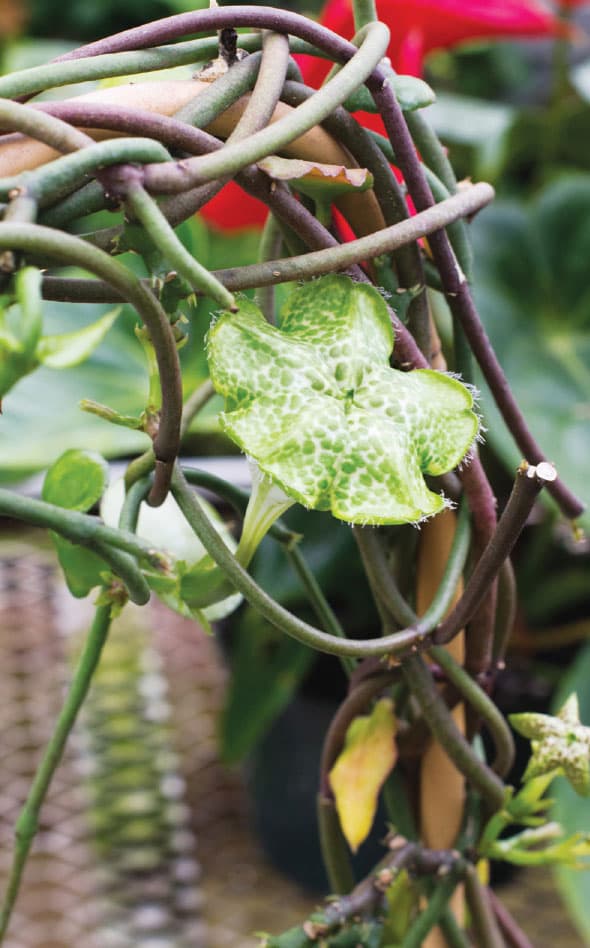
Ceropegia woodii
STRING OF HEARTS, ROSARY VINE
FAMILY: Apocynaceae
ORIGIN: South Africa, Swaziland, Zimbabwe
CULTURE: Needs part sun to light shade; porous, well-draining soil; and regular watering during the growth period (spring to summer), allowing soil to dry before watering again. Reduce watering in winter and protect from frost.
COLD HARDINESS: 50°F (10°C)
PROPAGATION: By cuttings, seed
BLOOM TIME: Summer
Another unusual tropical Ceropegia is a favorite houseplant that thrives in normal household temperatures with positioning in brightly lit locations. The dark green, heart-shaped leaves are decorated by a silvery, lace-like overlay and dark purple undersides. Not shy about blooming, the oddly shaped, tubular flowers are more or less a flamingo-pink with five stringy, near black, furry petals that are joined at their tips, forming a small cage-like structure. This is traditionally grown as a hanging plant and can become quite long over time. The variety ‘Variegata’, known as keepsake hearts, has leaves with a beautiful wide ivory or cream margin, a dark green center, and pink undersides.
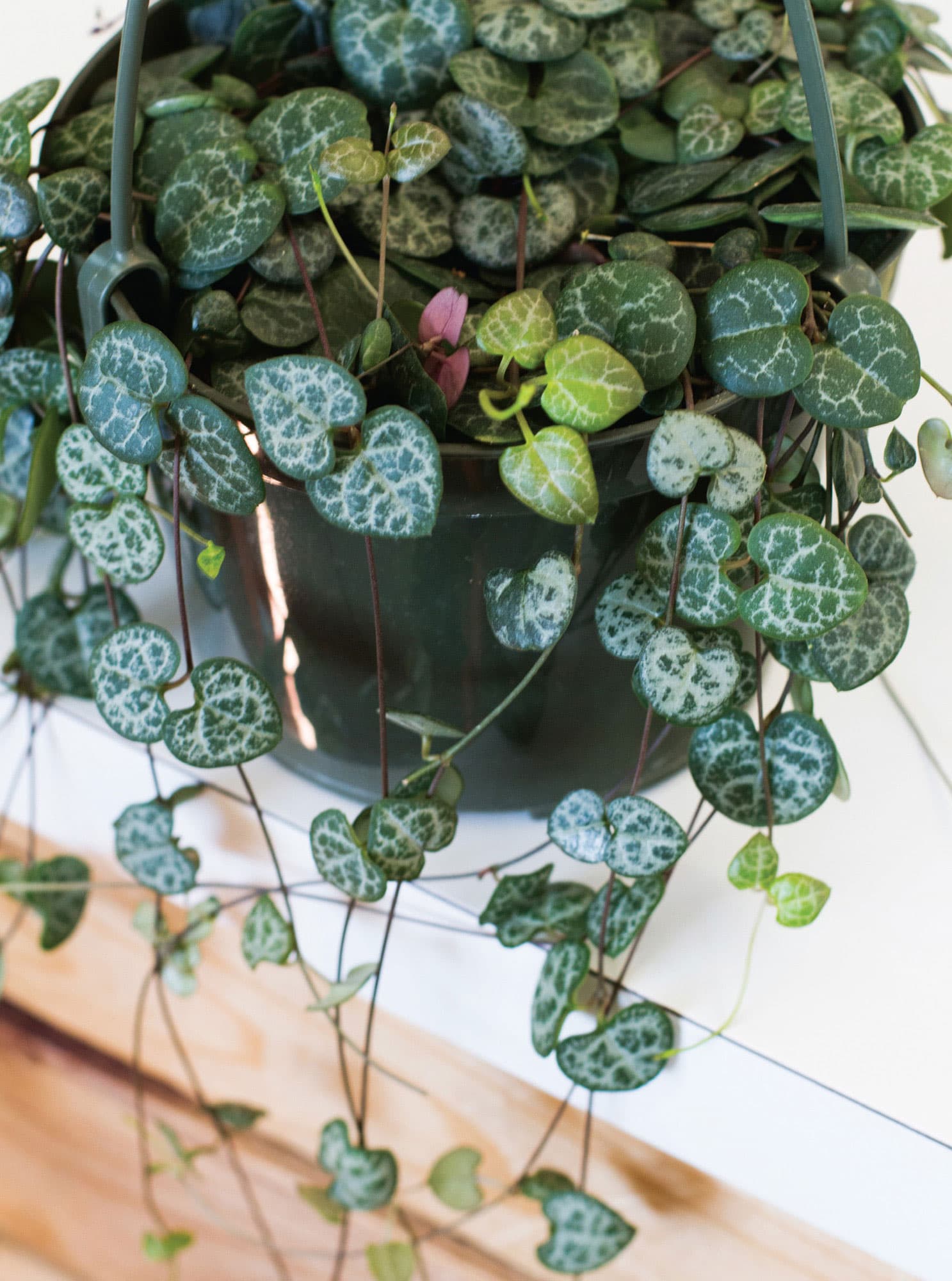
Consolea rubescens
ROAD KILL CACTUS
FAMILY: Cactaceae
ORIGIN: West Indies, Caribbean
CULTURE: Grow in full sun with porous, well-draining soil. Water regularly spring to fall, allowing soil to dry between applications. Keep on the dry side in winter, watering only occasionally, and protect from frost.
COLD HARDINESS: 35°F (1.7°C)
PROPAGATION: By cuttings
BLOOM TIME: Summer
This plant was previously known as Opuntia rubescens, and there is still discussion as to its actual classification. This is one of the tree-like, or “arborescent,” cactuses that can grow in excess of 15' (4.6 m) tall. When younger, this is truly one of the more unusual and comical cactuses, with extremely flattened pads. The whole plant looks as if it had been hit by a car, hence the common name “road kill cactus.” When looked at side-on, it almost becomes invisible, like a cardboard cutout viewed on edge. As it matures, the trunk puts on a fair girth of 6" (15.2 cm) or more in diameter, taking on an oval to round shape. Branching with age, it still sports the long, flattened oval pads. These are evenly dotted with raised areoles that have very short, nearly unnoticeable spines, making it more “user friendly” than most. In summer, the pads put forth numerous yellow to orange flowers followed by small fruits. Being a Caribbean native, it is more receptive to regular watering but also more frost tender.

Cotyledon orbiculata var. oblonga ‘Undulata’
SILVER RUFFLES
FAMILY: Crassulaceae
ORIGIN: South Africa
CULTURE: Well-draining porous soil, water only occasionally, full sun for best appearance.
COLD HARDINESS: 25° to 30°F (–3.9 to –1.1°C)
PROPAGATION: By cuttings
BLOOM TIME: Summer
One of the little treasures of life, this attractive sub-shrub is only slightly branching and grows 18" to 24"(45.7 to 61 cm) tall. The leaves have a very tightly undulated edge not unlike the side of a lasagna noodle, and they are coated with a very silvery-white, waxy bloom. Take care not to water from above, as this will remove the attractive coating. To add to the beauty, summertime brings forth roughly 12"(30.5 cm)–tall flower spikes with numerous pendent, bell-like, red-orange flowers that are frequented by local hummingbirds.
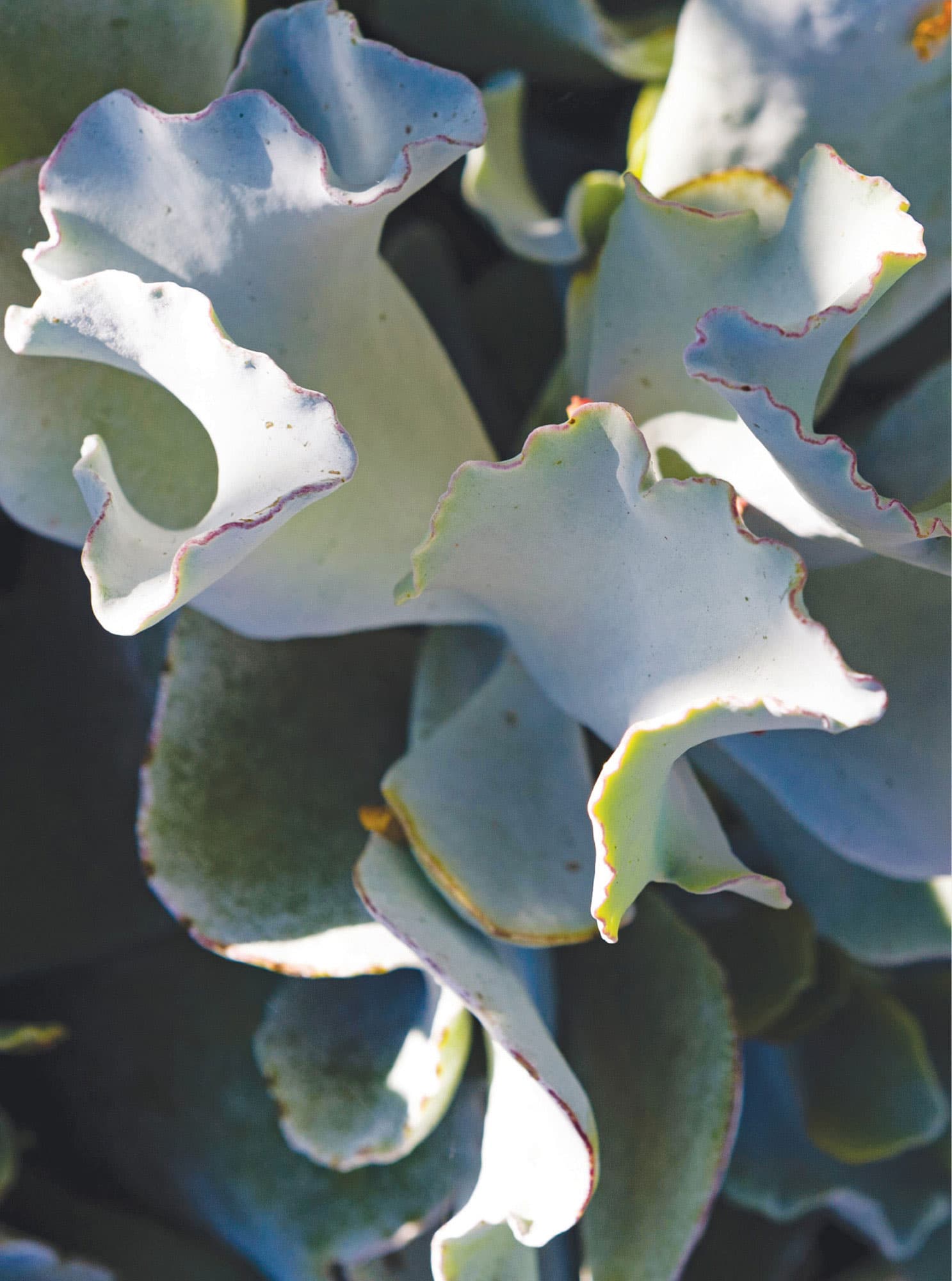
Crassula perfoliate var. falcata
PROPELLER PLANT
FAMILY: Crassulaceae
ORIGIN: South Africa
CULTURE: Needs porous, well-draining soil and tolerates regular watering during all warmer months; reduce water in winter. Place in full sun to light shade, and protect from frost.
COLD HARDINESS: 35°F (1.7°C)
PROPAGATION: By cuttings
BLOOM TIME: Summer
The thick, gray-green sickle-shaped leaves form tightly grouped stacking pairs, adding a fan effect to the overall appearance. In summer, flower spikes appear carrying large heads of small orange-red to scarlet-red fragrant flowers that remain for up to a month. They have a very heavy, floral aroma that on a summer day can be smelled from quite a distance. Up close, a whiff is intoxicating but quickly becomes too strong to handle and is best enjoyed from farther away.
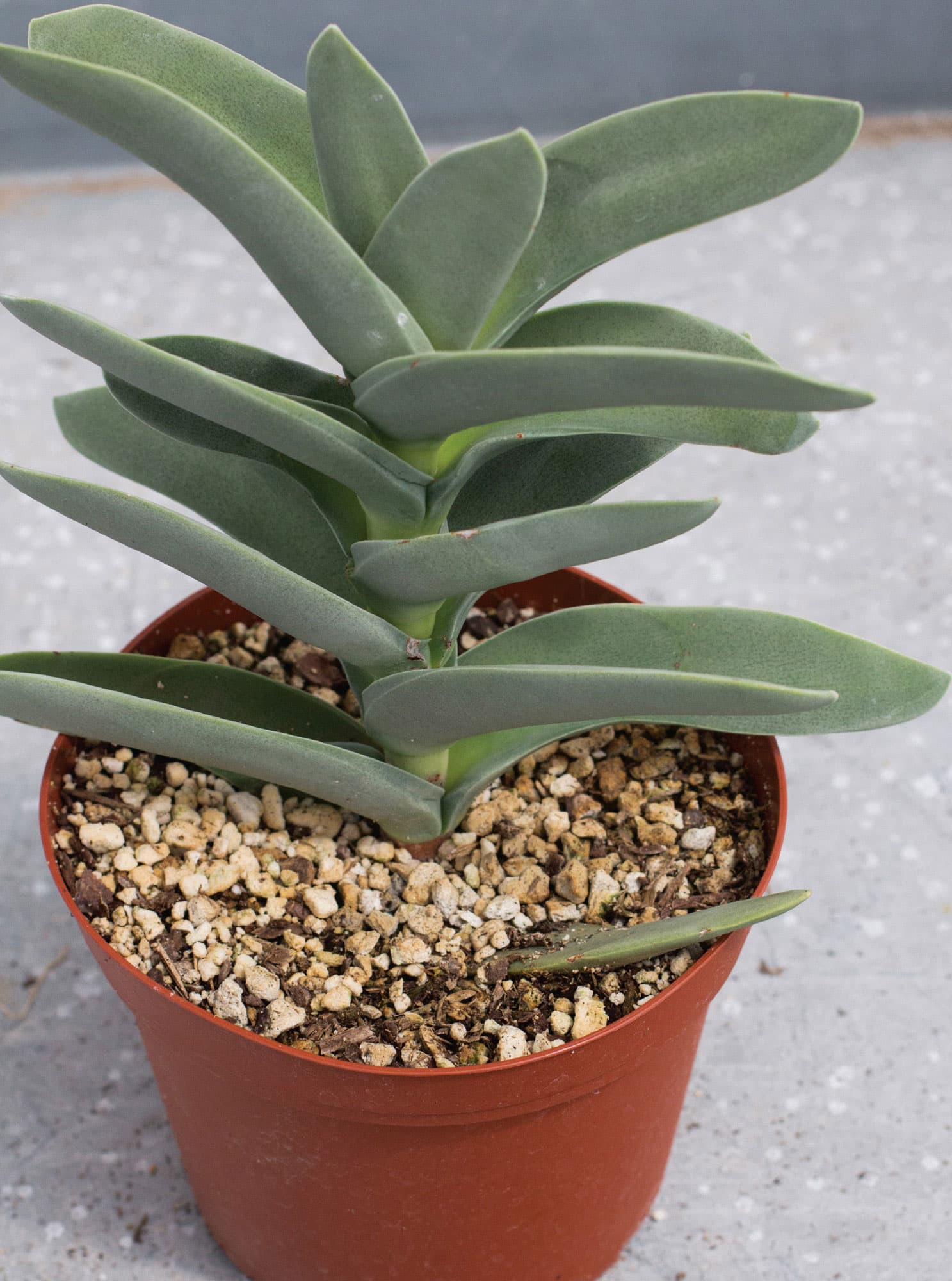
Crassula ovata
JADE PLANT, GOOD LUCK JADE
FAMILY: Crassulaceae
ORIGIN: South Africa, Mozambique
CULTURE: Needs porous, well-draining soil that should be allowed to dry out well before watering again. Full sun is needed for best growth and flowering; protect from hard frost.
COLD HARDINESS: 28°F (–2.2°C)
PROPAGATION: By cuttings
BLOOM TIME: Winter
One of the most popular houseplants, jade plant has rich green, succulent leaves considered by some to represent money, wealth, and prosperity. Indoors, jade plants need as much full sun to bright light as possible. Lack of sufficient light will cause the plant to stretch and become stringy and weak. When watering, do it thoroughly and do not water again until the soil has become almost completely dry—and never let it sit in standing water for any length of time. In the ground in full sun and light-frost or frost-free locations, the leaves often have a bright red margin, and it produces clusters of small, star-shaped, white flowers in winter that nearly cover the plant. These plants can easily become 6' (1.8 m) hedges. Plants grown indoors rarely if ever flower due to lack of constant full sun. There are many varieties and cultivars as well, such as the variegated ‘Hummel’s Sunset’ and the pink-flowered ‘Pacific Pink’.
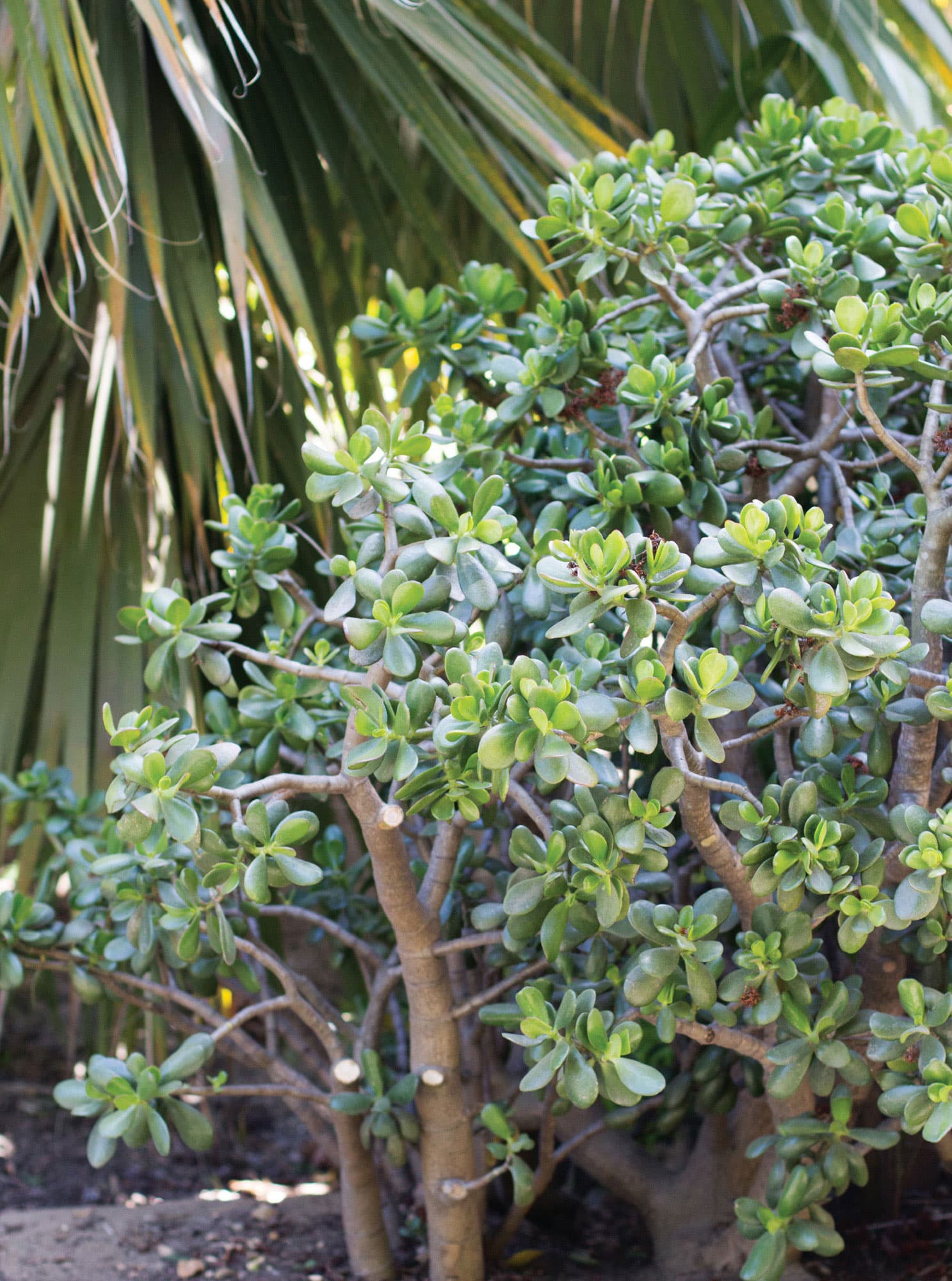
Crassula ovata
‘GOLLUM’ JADE
FAMILY: Crassulaceae
ORIGIN: South Africa, Mozambique
CULTURE: Needs porous, well-draining soil that should be allowed to dry out well before watering again. Full sun is needed for best growth and flowering; protect from hard frost.
COLD HARDINESS: 28°F (2.2°C)
PROPAGATION: By cuttings
BLOOM TIME: Winter
‘Gollum’ is one of several fun, monstrose-type sports or cultivars of the traditional jade. Care and culture are the same as for the regular Crassula ovata, the only difference being the appearance. The leaves are mutated to be basically rolled over into a cylindrical shape with a suction cup–like dimple at the end. The plant is slower growing and planted in the ground outside where conditions allow, and the overall size is significantly smaller. Other fun forms with similar but differently shaped leaves are ‘Hobbit’, ‘Ogre Ears’, and ‘E.T.’s Fingers’. Some of these can also be found in variegated versions. Along with the traditional jade plant, these varieties all lend themselves to pruning and sculpting into quite attractive succulent bonsai subjects.
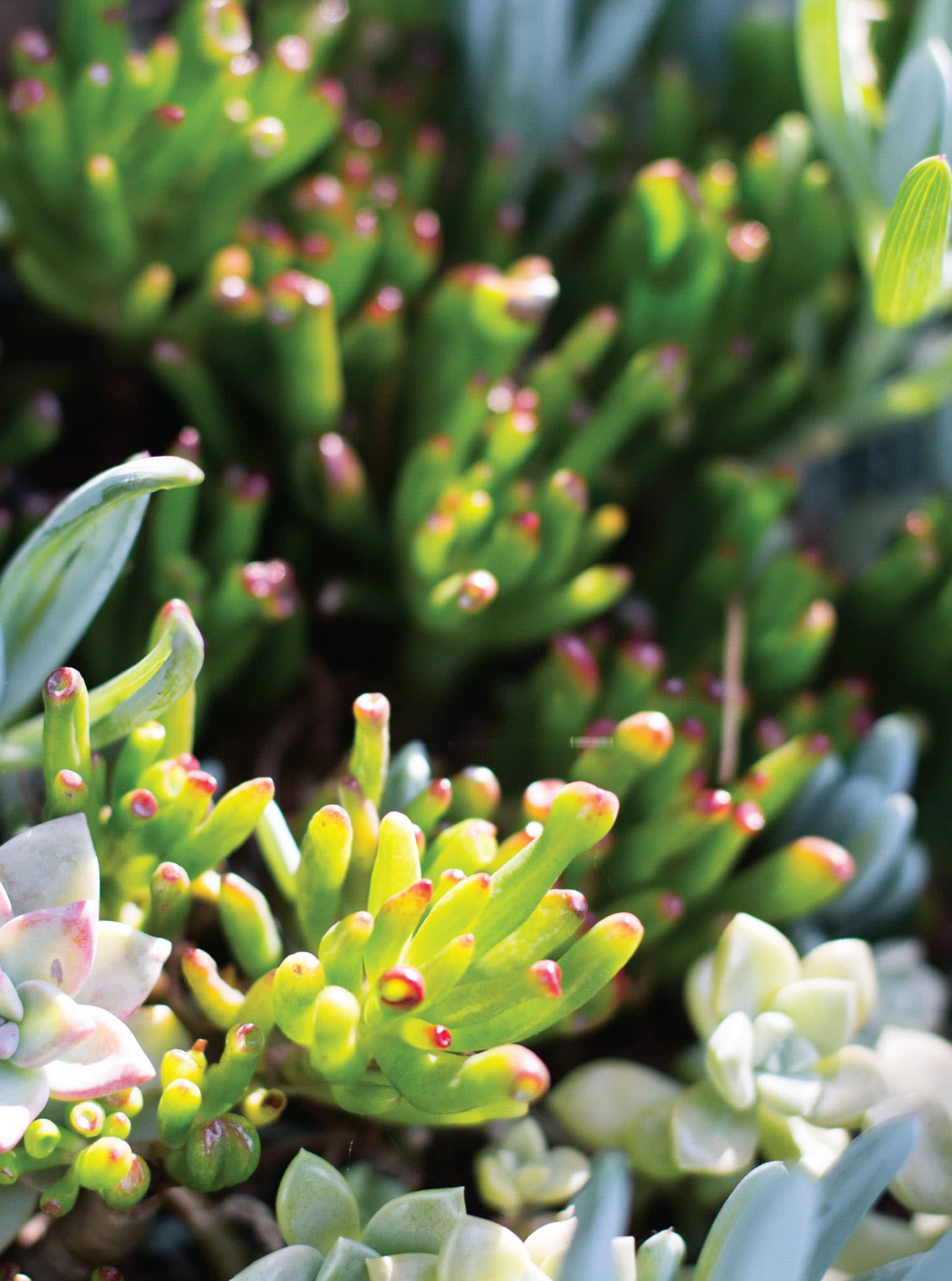
Cyphostemma juttae
WILD GRAPE, TREE GRAPE
FAMILY: Vitaceae
ORIGIN: Southern Africa
CULTURE: Needs very well-draining soil and full to part sun. Water only when in leaf, usually in late spring to summer.
COLD HARDINESS: 25° to 30°F (–3.9 to –1.1°C)
PROPAGATION: By seed
BLOOM TIME: Summer
Cyphostemma is a much-desired plant for the garden, as are other caudiciform plants. They make superb container or open garden additions, especially around swimming pools and in courtyards. This amazing caudiciform relative of the common grape is known for its large swollen base (caudex). As it leafs out in summer, clusters of tiny insignificant flowers are produced, which proceed to develop grape-like fruits that turn red when ripe. Though related to table grapes, this fruit is inedible and contains various chemical toxins. Reaching tree-like proportions in the wild, cultivated plants are usually 2' to 4' (0.6 m to 1.2 m) tall on average. Tree grapes are native to Namibia, where they are exposed to very dry and hot conditions. The large caudex becomes a backup reservoir of water to survive extended periods of drought. In winter, the plant becomes deciduous and drops all its leaves and remains so until spring or early summer.
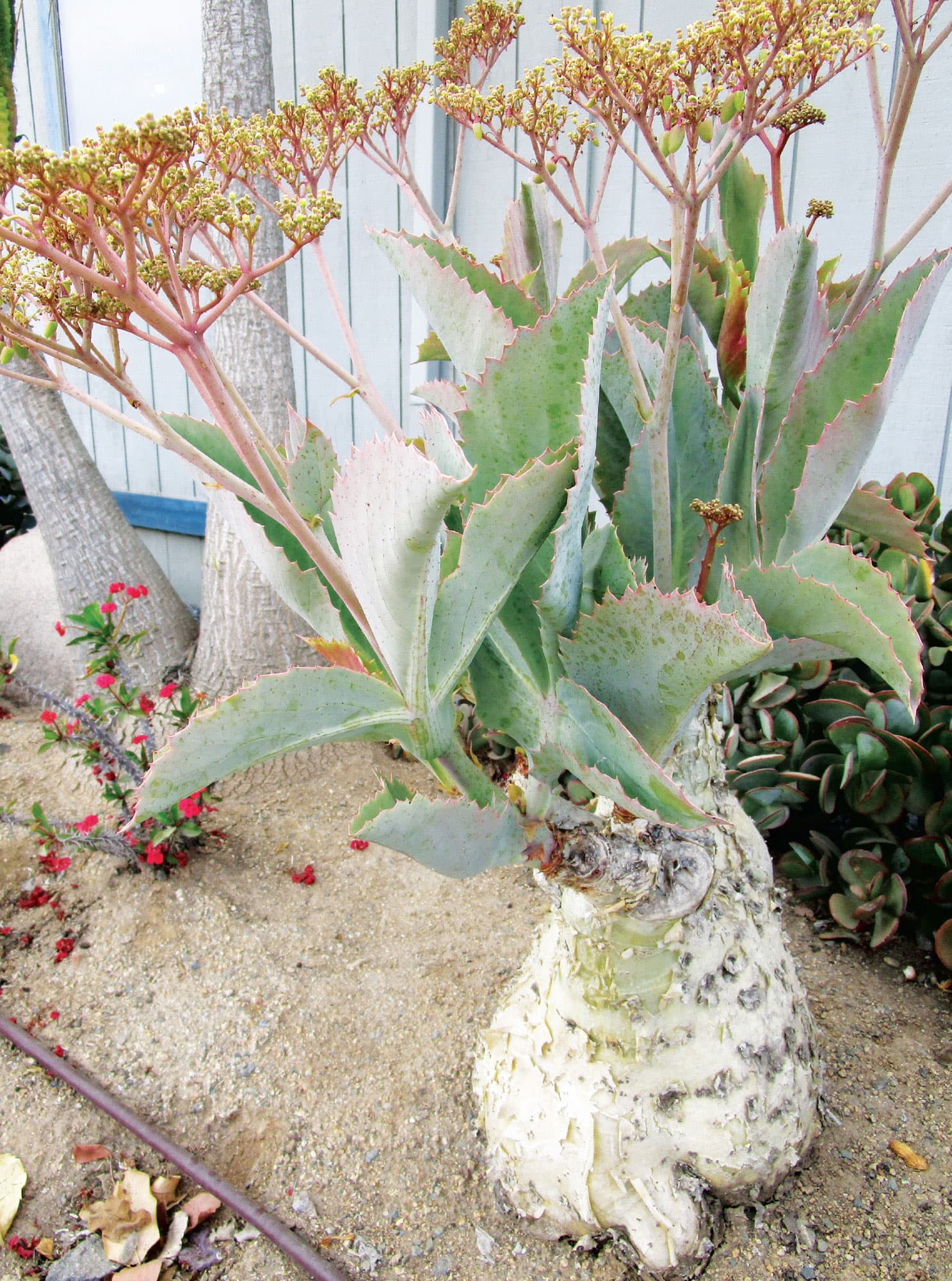
Dudleya brittonii
GIANT CHALK DUDLEYA
FAMILY: Crassulaceae
ORIGIN: Baja California, Mexico
CULTURE: Must have very porous, well-draining soil and full sun. Water from fall to spring with only the slightest irrigation in summer.
COLD HARDINESS: 15°F (–9.4°C)
PROPAGATION: By cuttings, seed
BLOOM TIME: Spring to summer
No gardener is ever ambivalent at the first sight of this brilliantly chalky-white Baja California, Mexico–native succulent. This Dudleya is known for its huge (up to 18" [46 cm] wide) chalky-white rosettes that seem to have a ghostly glow. Mostly solitary but occasionally putting out offsets, it is found growing on hillsides and out of rocky cliff crevices. Silvery-white 2’ (0.6 m)-tall flower spikes appear in spring and change color to a dark cherry red while sporting clusters of yellow flowers. Their cliffside habit makes them perfect for planting in cracks and crevices in rock walls and rock gardens. Summer watering should be just the very bare minimum, and try to avoid overhead watering at this time.
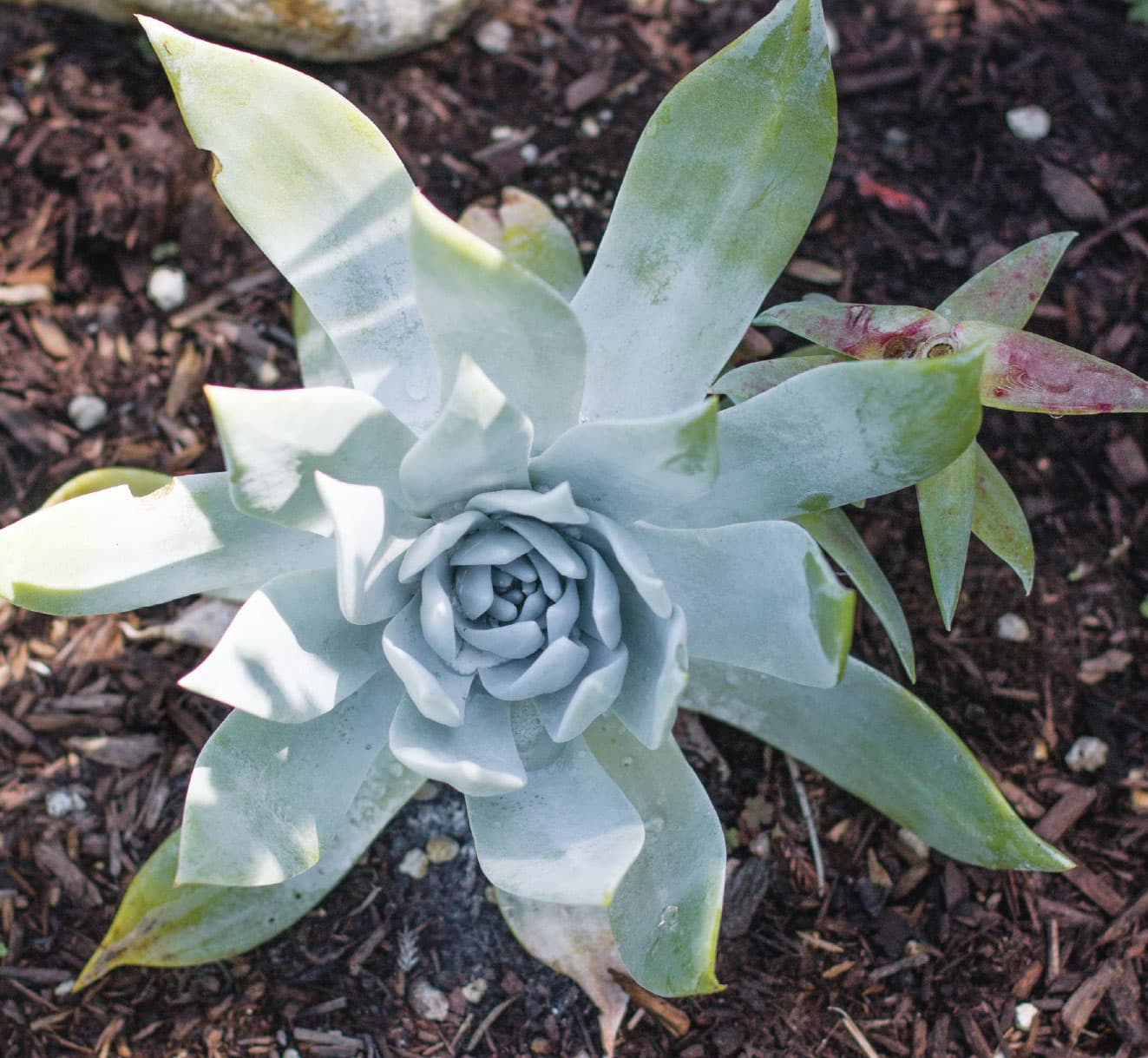
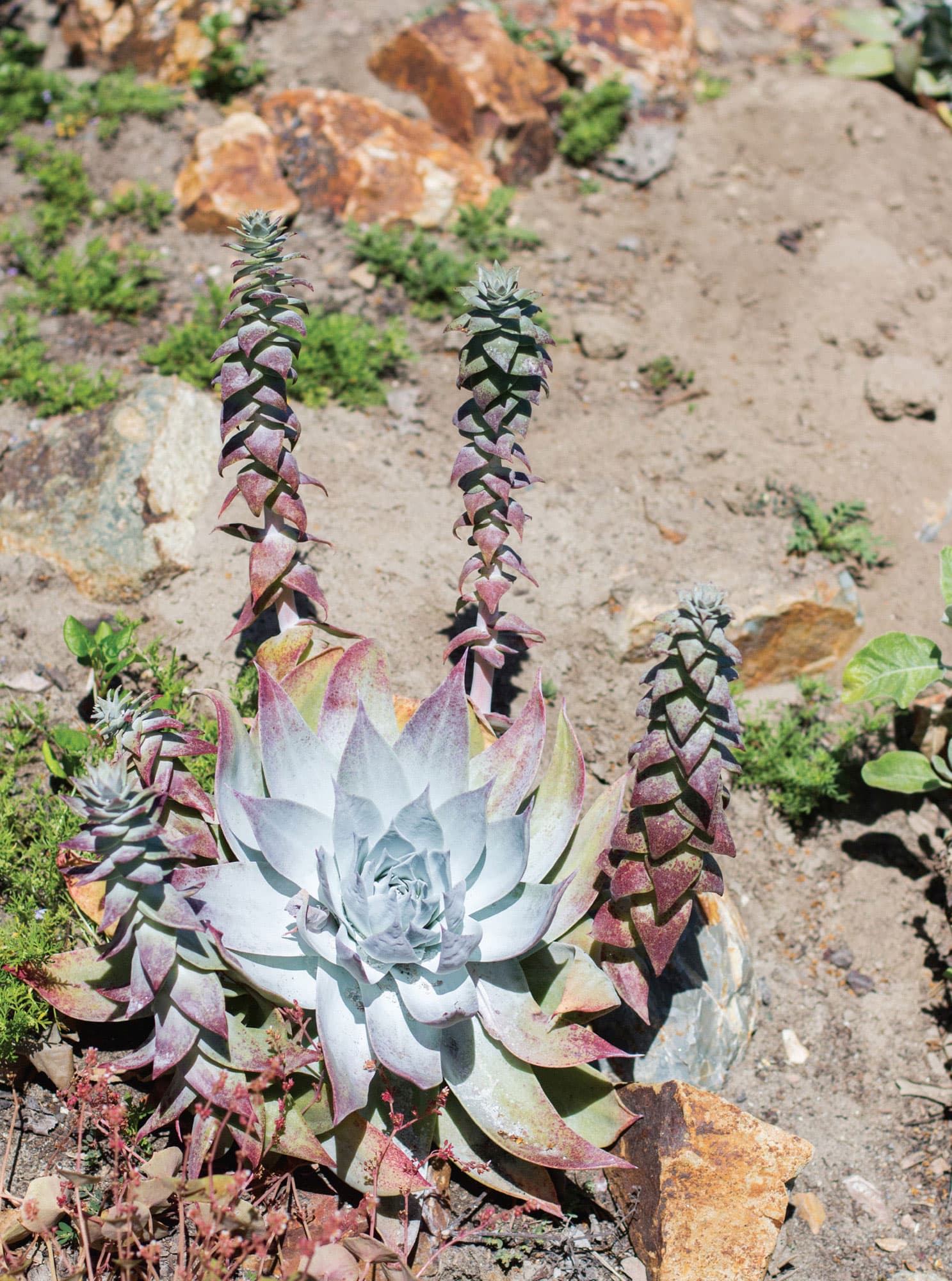
Echeveria Hybrid
‘BLACK PRINCE’
FAMILY: Crassulaceae
ORIGIN: Nursery hybrid
CULTURE: Needs porous, well-draining soil with full sun to light shade in the hottest inland locations. Water thoroughly and allow the soil to dry out some before thoroughly watering again. Reduce water in winter and protect from frost.
COLD HARDINESS: 25°F (–3.9°C)
PROPAGATION: By offsets, leaves
BLOOM TIME: Fall to winter
As the succulent craze began, ‘Black Prince’ quickly jumped to the forefront of one of the most popular. The dark-hued rosettes of this relatively frost-hardy succulent contrast beautifully with the gray and silvery tones of other Echeverias. The nearly black color of this favorite comes from Echeveria affinis, known as the “black echeveria.” The crossing of E. affinis with E. shaviana created ‘Black Prince’, thanks to hybridizer Frank Reinelt in California. It offsets easily and has a remarkable scarlet-red flower when most echeverias have yellow, orange, or pink.
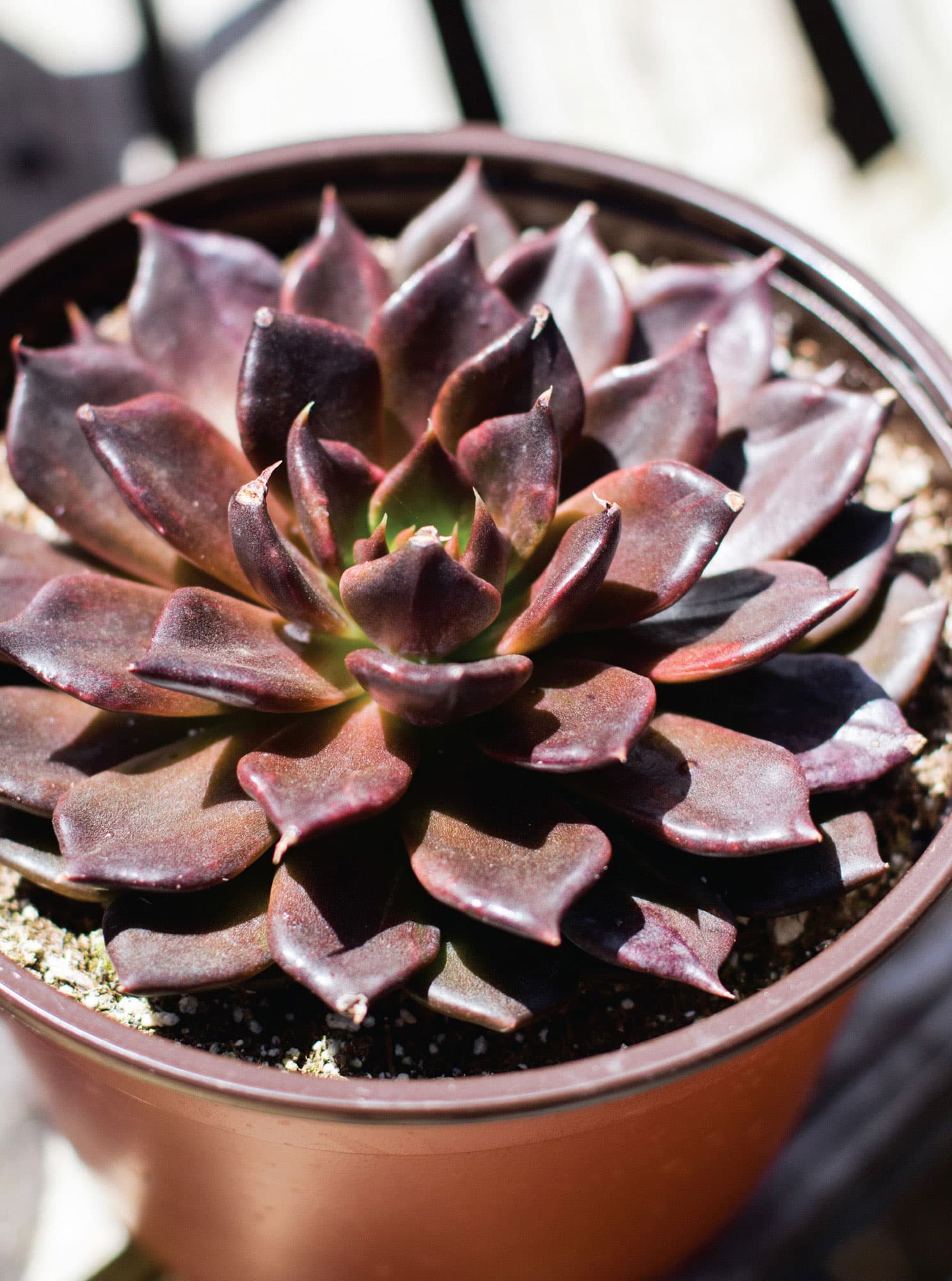
Echeveria Hybrid
‘GORGON’S GROTTO’
FAMILY: Crassulaceae
ORIGIN: Nursery hybrid
CULTURE: Needs porous, well-draining soil with full sun to light shade in the hottest inland locations. Water thoroughly and allow the soil to dry out some before thoroughly watering again. Reduce water in winter and protect from frost.
COLD HARDINESS: 28°F (–2.2°C)
PROPAGATION: By cuttings, leaves
BLOOM TIME: Unknown, likely summer
Renee O’Connell is world famous as a succulent breeder and is especially valued for her amazing echeveria hybrids. ‘Gorgon’s Gotto’ is certainly one of the more outrageous varieties she has created. Echeveria ‘Enhanced Mauna Loa’ was crossed with an unpatented proprietary. The resulting offspring is a large rosette to nearly 1' (0.3 m) across with very satisfactory gray-purple leaves. Caruncles, those unusual patches of warty lumps and bumps seen on the leaves of many echeveria hybrids, are large and pink on ‘Gorgon’s Grotto’, and are an outstanding color contrast to the gray-purple foundation.
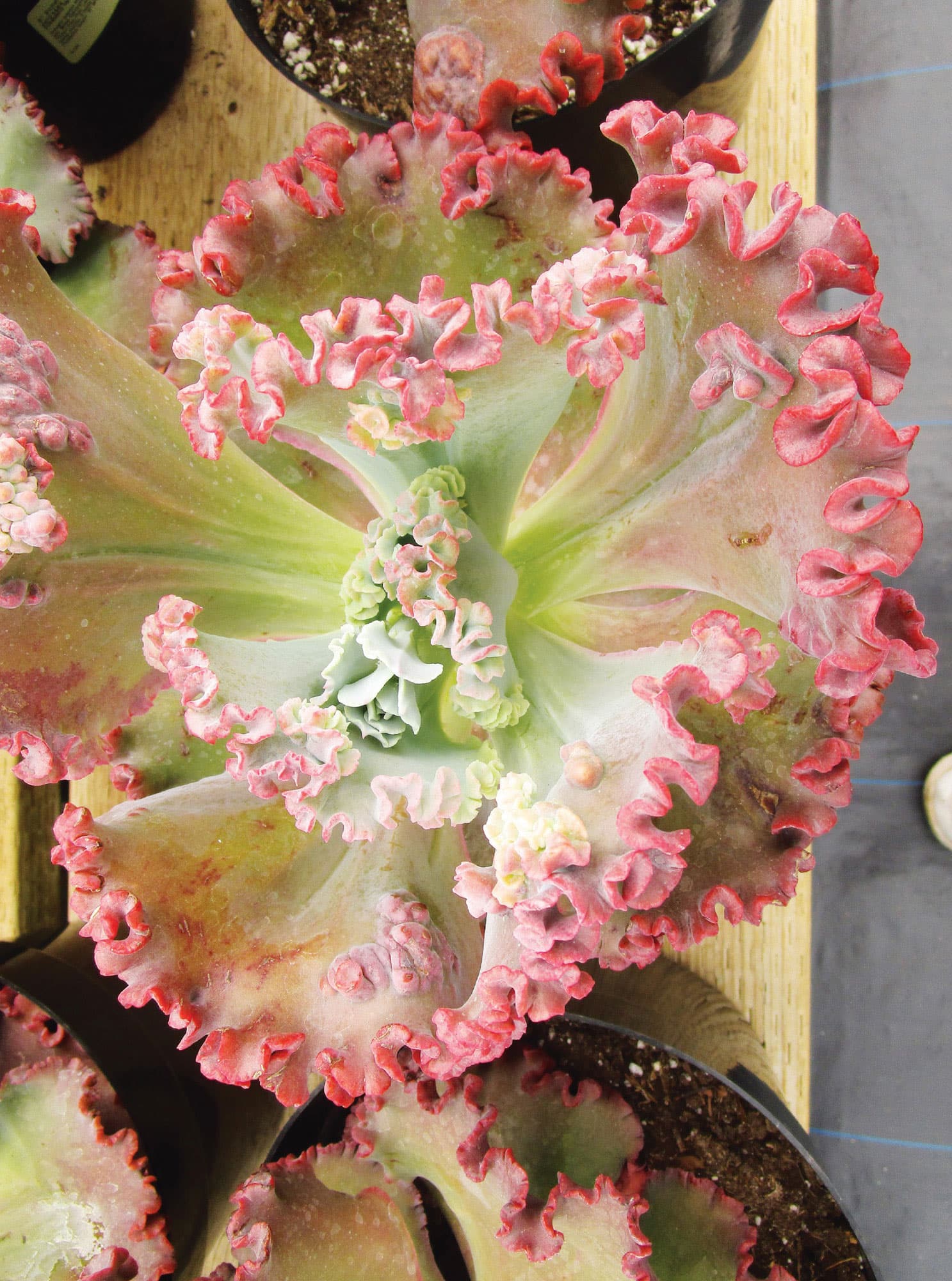
Echeveria Hybrid
‘NEON BREAKERS’
FAMILY: Crassulaceae
ORIGIN: Nursery hybrid
CULTURE: Needs porous, well-draining soil with full sun to light shade in the hottest inland locations. Water thoroughly and allow the soil to dry out some before thoroughly watering again. Reduce water in winter and protect from frost.
COLD HARDINESS: 28°F (–2.2°C)
PROPAGATION: By cuttings, leaves
BLOOM TIME: Unknown, likely summer
Yet another one of Renee O’Connell’s phenomenal hybrids, ‘Neon Breakers’ is a cross of E. shaviana ‘Pink Frills’ and another proprietary hybrid. It forms rosettes to 8" (20.3 cm) in diameter, eventually producing offsets that form clusters. The rosettes are comprised of many leaves that are a red-violet-mauve color, with neon-pink, extremely crinkly margins. These neon-pink margins seemingly radiate neon light. An outstanding feature of this hybrid is an increased disease and pest resistance, resulting in greater vigor and faster growth. Because of this, it also doesn’t go through the typical winter dormancy that echeverias have a tendency to do.
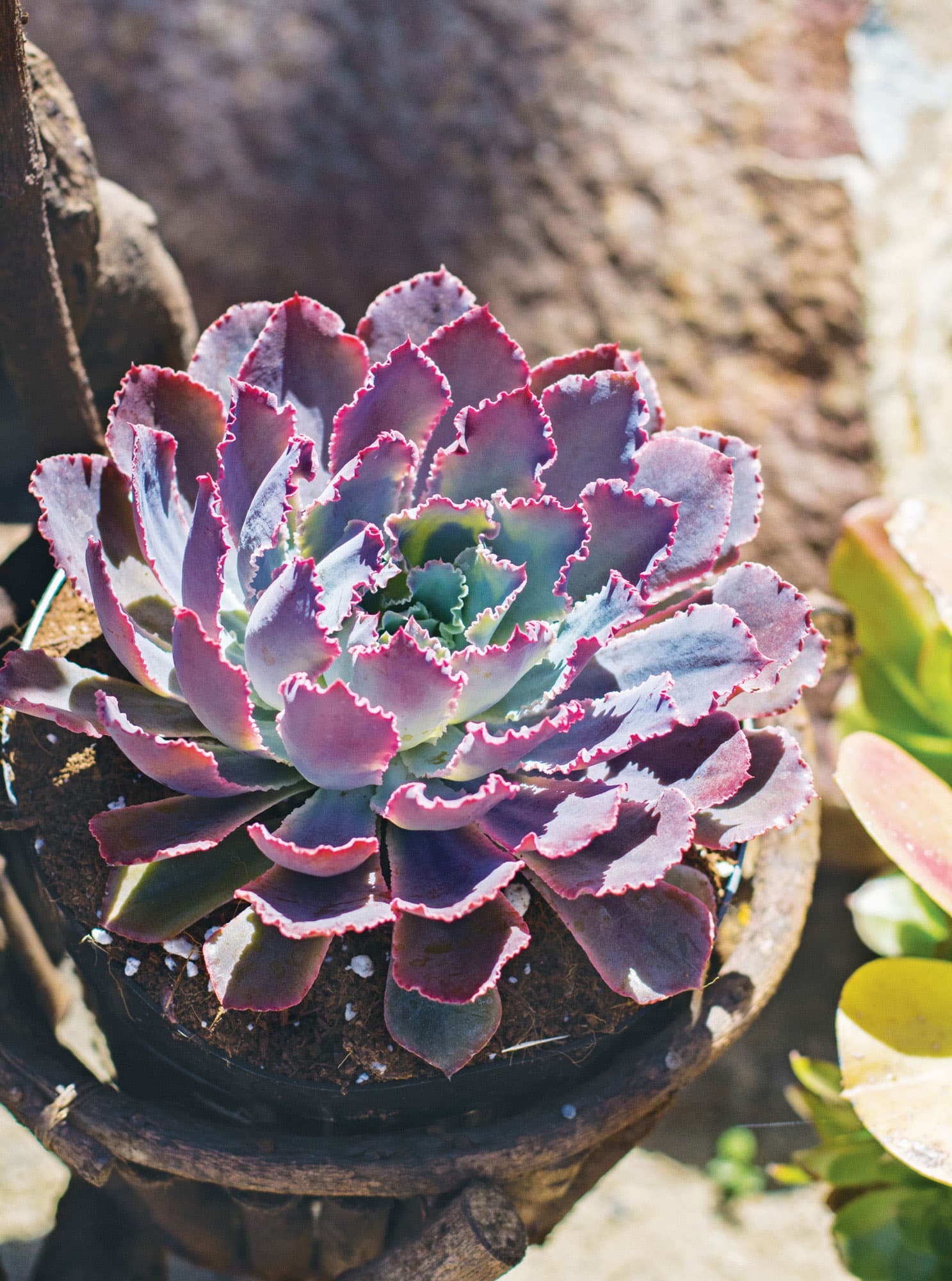
Echeveria Hybrid
‘PERLE VON NURNBERG’
FAMILY: Crassulaceae
ORIGIN: Nursery hybrid
CULTURE: Needs porous, well-draining soil with full sun to light shade in the hottest inland locations. Water thoroughly and allow the soil to dry out some before thoroughly watering again. Reduce water in winter and protect from frost.
COLD HARDINESS: 28°F (–2.2°C)
PROPAGATION: By cuttings, leaves
BLOOM TIME: Summer
This hybrid is a favorite among echeveria fans and succulent neophytes as well. It is an old hybrid between E. gibbiflora ‘Metallica’ and E. elegans, created by Richard Graessner of Perleberg, Germany, in the 1930s. Its soft, lavender-pink color with somewhat cupped, spoon-shaped leaves have made it a timeless favorite. In summer, 12" (30.5 cm)-tall reddish spikes bear cupped flowers that are coral pink on the exterior with a yellow interior. ‘Perle’ is about 6" (15.2 cm) wide at maturity, and makes a striking, solitary container specimen.
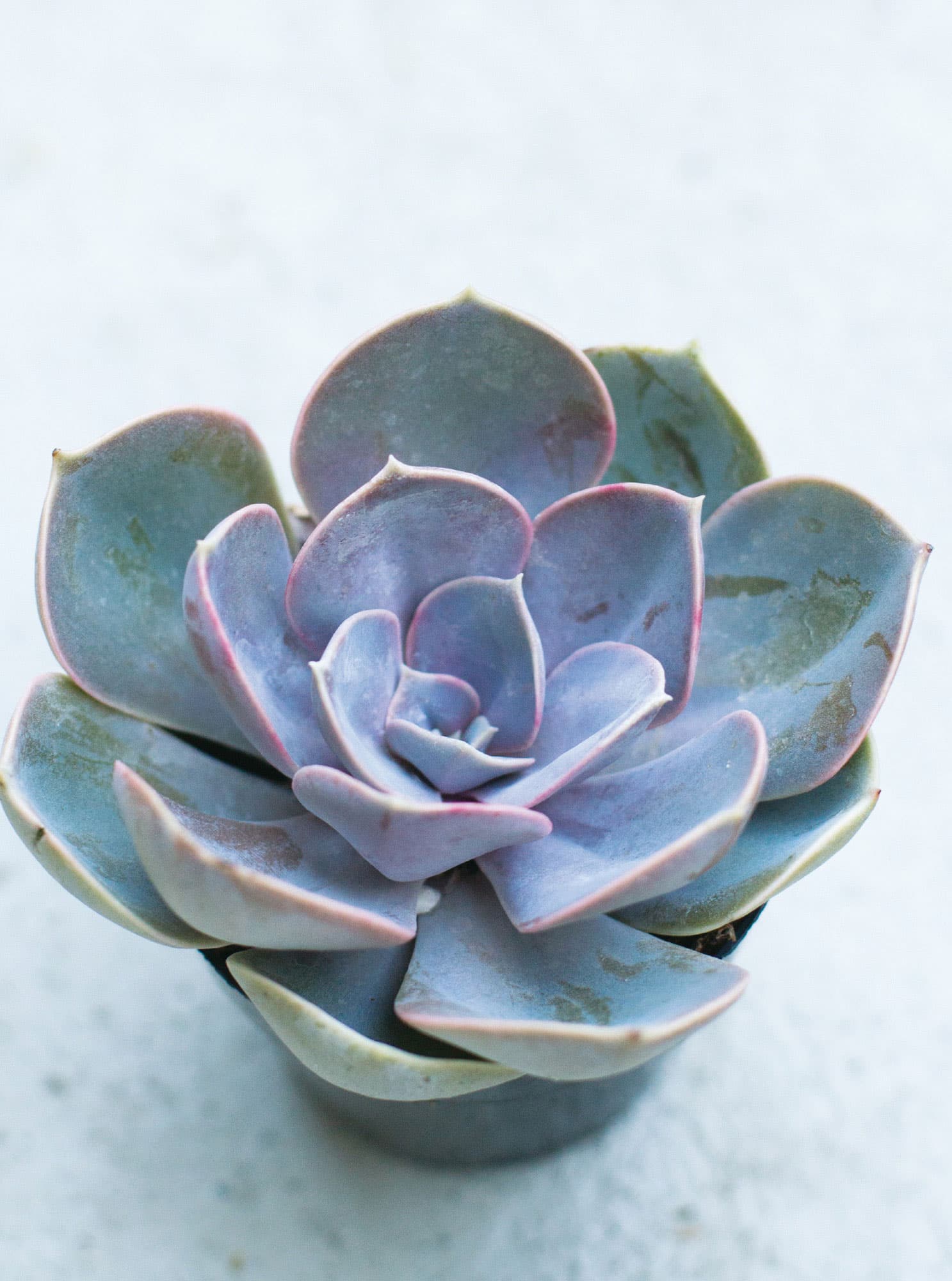
Echeveria × imbricata
HENS AND CHICKS
FAMILY: Crassulaceae
ORIGIN: Nursery hybrid
CULTURE: Needs porous, well-draining soil with full sun to light shade in the hottest inland locations. Water thoroughly and allow the soil to dry out some before thoroughly watering again. Reduce water in winter and protect from long hard frost.
COLD HARDINESS: 20° to 25°F (–6.7 to –3.9°C)
PROPAGATION: By cuttings, offsets, leaves
BLOOM TIME: Spring to summer
Without much doubt, this is the most often seen and grown of echeverias, truly a testament to a very old hybrid (1870s) with great appeal. These flat, 6"- to 8"(15.2 cm to 20.3 cm)-wide rosettes are an attractive blue-gray and very prolific. The proverbial “hens” are quickly popping out “chicks” around them, creating impressive spreading clumps or colonies. Spring and summer bring on branched, arching flower spikes with clusters of red and yellow flowers that are enjoyed by hummingbirds.
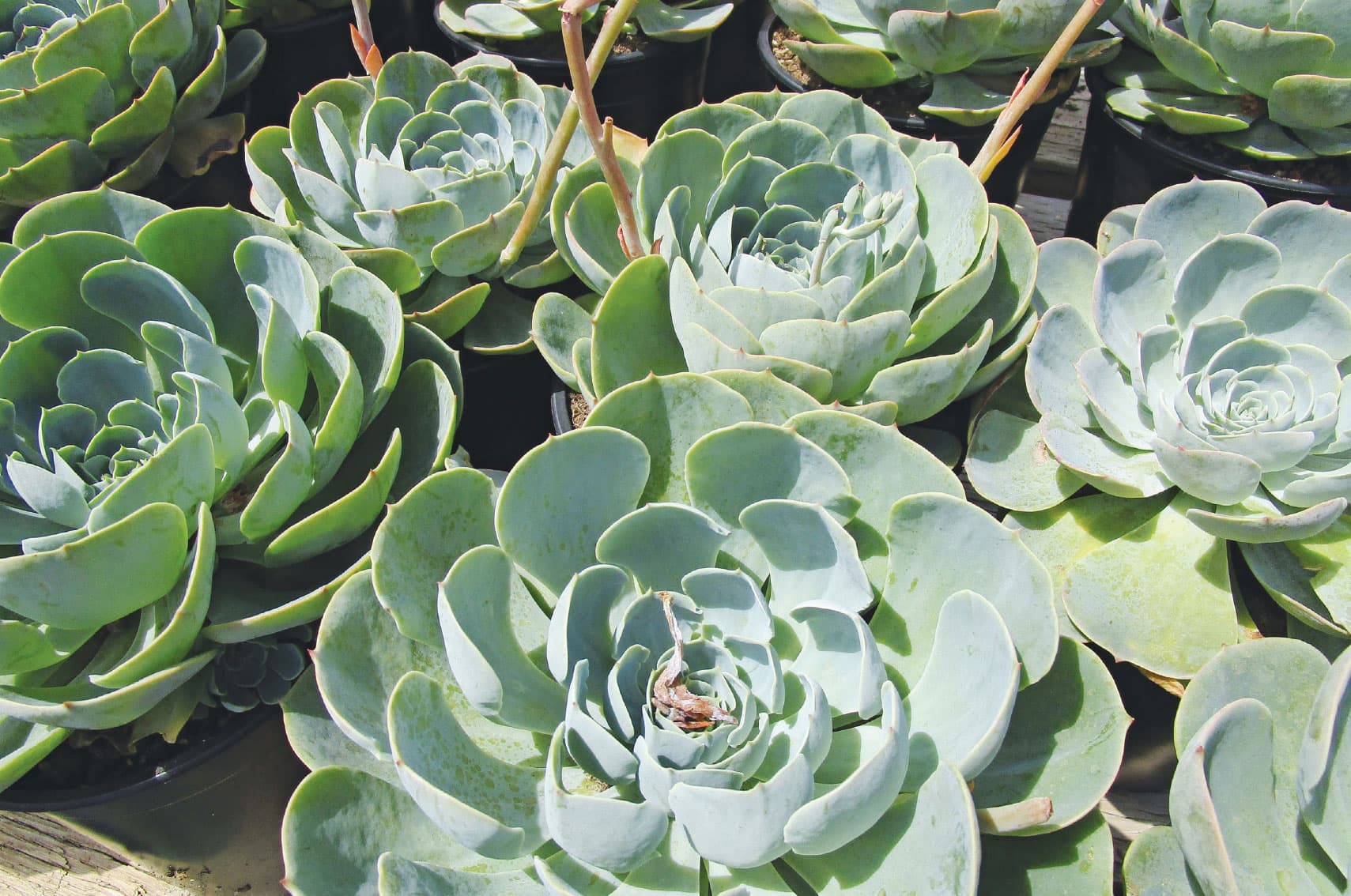
Echeveria × imbricata ‘Compton Carousel’
VARIEGATED HENS AND CHICKS
FAMILY: Crassulaceae
ORIGIN: Garden hybrid
CULTURE: Needs a porous, well-draining soil with full sun to light shade in the hottest inland locations. Water thoroughly and allow the soil to dry out some before thoroughly watering again. Reduce water in winter and protect from long, hard frost.
COLD HARDINESS: 25°F (–6.7°C)
PROPAGATION: Cuttings, offsets, leaves
BLOOM TIME: Summer
This is an astonishingly beautiful echeveria that forms tight rosettes with exceptional coloration. The short, wide, and slightly cupped blue-gray leaves sport a wide cream-colored margin with a blush of pink on older leaves, particularly during cooler temperatures in winter. Readily producing offsets, it will in time produce a dense, slightly mounding clump. Like many spontaneous garden hybrids, this gem has somewhat murky parentage with various theories that can be further researched if desired.
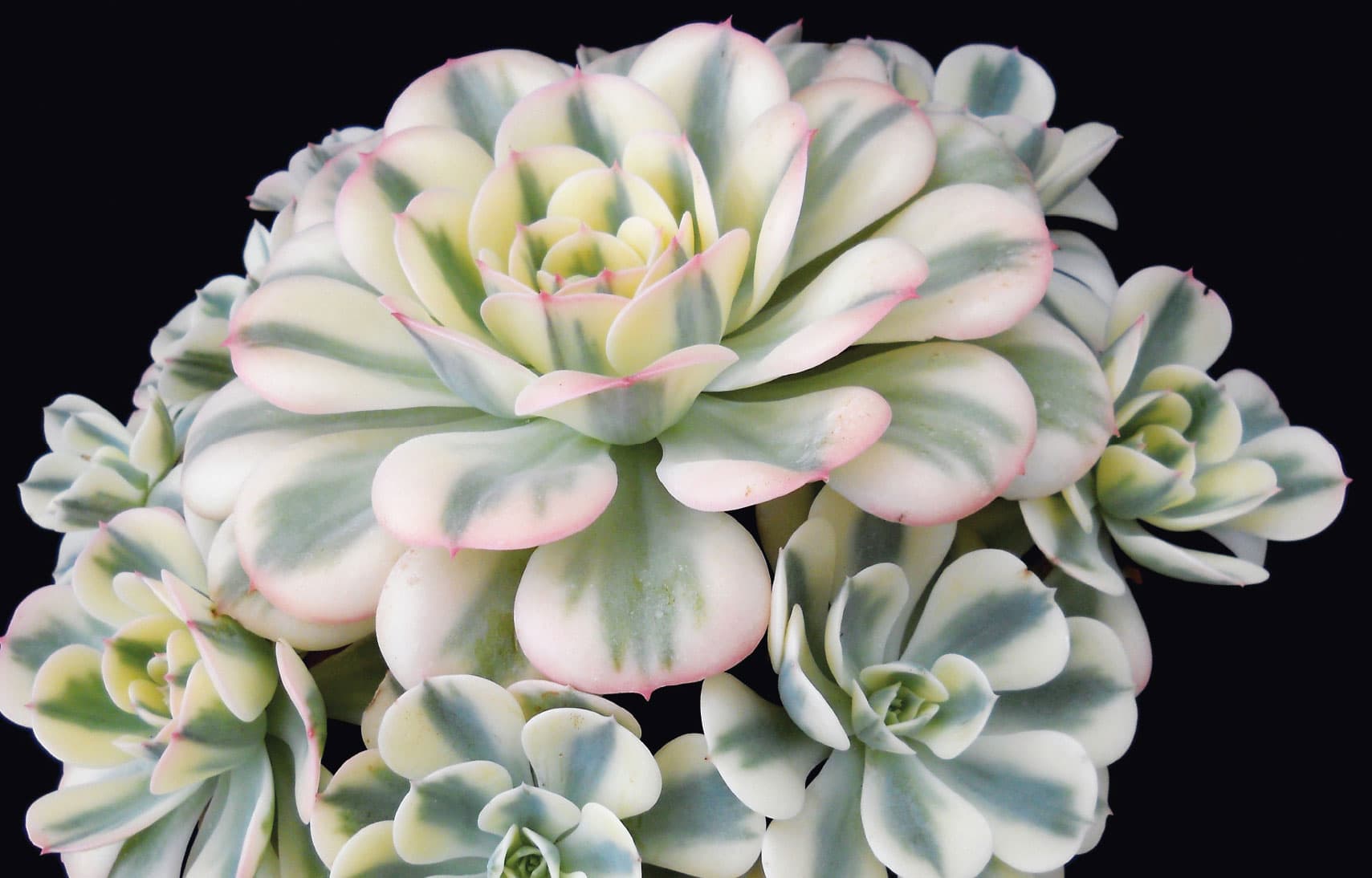
Echeveria nodulosa
PAINTED ECHEVERIA
FAMILY: Crassulaceae
ORIGIN: Mexico
CULTURE: Needs porous, well-draining soil with cool full sun to light shade in the hottest inland locations. Water thoroughly and allow the soil to dry out some before thoroughly watering again. Reduce water in winter and protect from frost.
COLD HARDINESS: 25°F (–6.7°C)
PROPAGATION: By cuttings, leaves
BLOOM TIME: Summer
This is a gem among Echeveria species. Growing more like a small sub-shrub, it has a branching habit 1' to 2' (0.3 to 0.6 m) tall and 3' to 4' (0.9 to 1.2 m) wide. The stems support 5" (38.1 cm) -wide rosettes at their ends, causing the branches to arch and lay over with time and added rosette weight. The leaves are roughly a shade of pistachio green and painted with red margins and red longitudinal patterns on the top surfaces. The cupped leaves also have a distinct keel on the underside and it is likewise painted red along its length. There is also a light speckling of red all over the leaves, top and bottom. A flower spike nearly 2' (0.6 m) tall in summer bears pale yellow flowers that are often marked with red. This species is beginning to make a mark, adding its unique patterns and color to new hybrids.
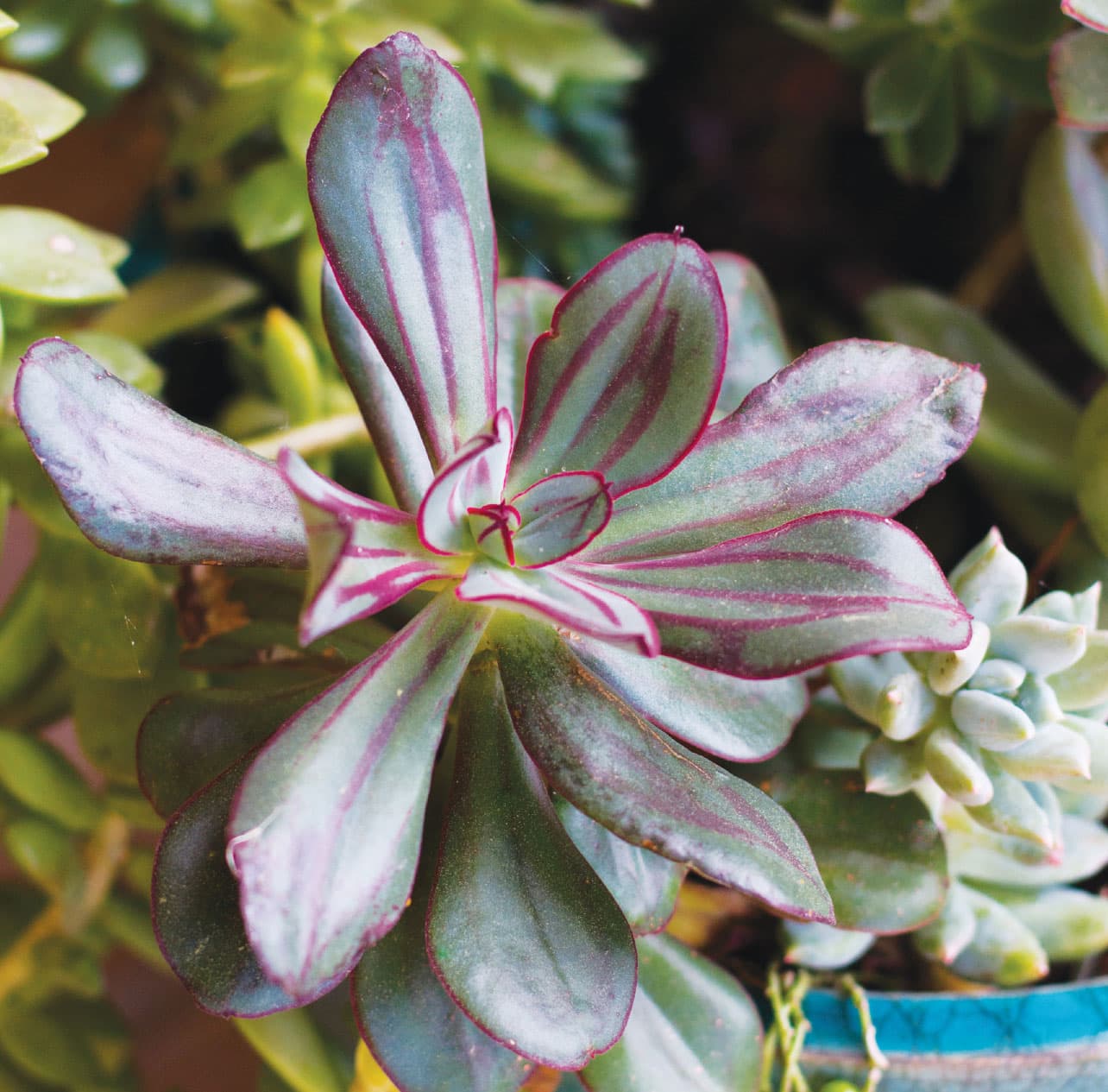
Echeveria runyonii
‘TOPSY TURVY’
FAMILY: Crassulaceae
ORIGIN: Mexico
CULTURE: Needs porous, well-draining soil with full sun to light shade in the hottest inland locations. Water thoroughly and allow the soil to dry out some before thoroughly watering again. Reduce water in winter and protect from frost.
COLD HARDINESS: 30°F (–1.1°C)
PROPAGATION: By offsets, cuttings, leaves
BLOOM TIME: Summer
This fast-growing, rosette-forming succulent has pale blue-gray leaves that curve upward and are strongly inversely keeled on the lower surface, with leaf tips pointing in toward the center of the plant. The normal form of E. runyonii is a typical flat-leafed rosette like most other echeverias. ‘Topsy Turvy’ is beautifully colored a pale blue-gray. It almost gives it a “chrysanthemum” appearance. As an added bonus, the plant produces offsets profusely and easily forms a colony.
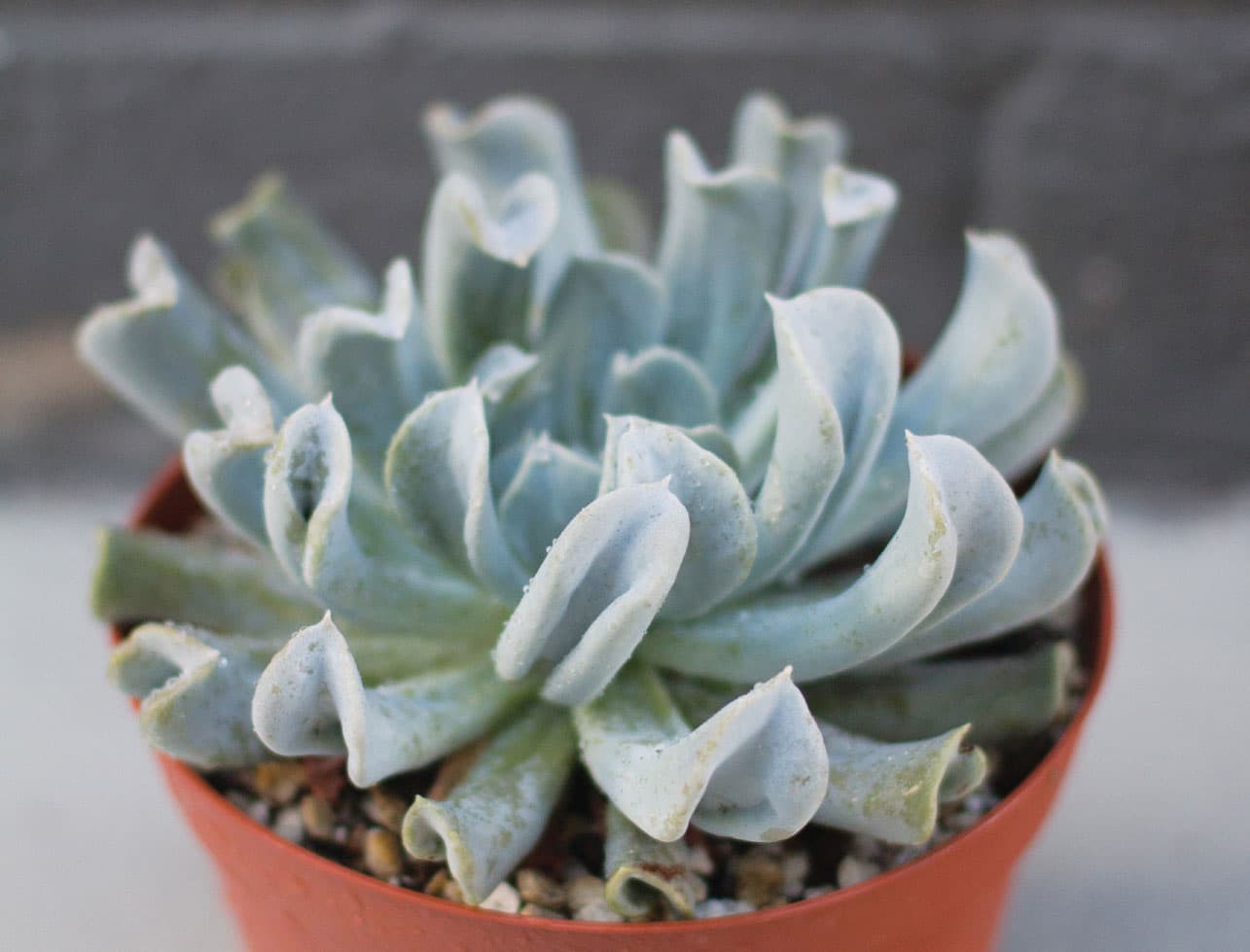
Echinocactus grusonii
GOLDEN BARREL, MOTHER-IN-LAW’S CUSHION
FAMILY: Cactaceae
ORIGIN: Mexico
CULTURE: Needs porous, well-draining soil with full sun. Water thoroughly and allow the soil to dry out before thoroughly watering again. Reduce water in winter.
COLD HARDINESS: 15° to 20°F (–9.4 to –6.7°C)
PROPAGATION: By seed, offsets
BLOOM TIME: Spring to summer
Along with the giant saguaro of the Sonoran Desert, the golden barrel is the other quintessential cactus that instantly says “desert” to most people. This amazing ball is armed with thousands of slightly curved, very stiff, and very sharp bright yellow spines. A ring or crown of bright yellow flowers encircles the top of larger mature specimens. The oldest specimens can reach about 35 years old and by that time have grown upright to approximately 3’ (0.9 m) tall and taken on a columnar appearance. The plant is cold tolerant if it is not for a very prolonged period. There are various cultivars, and Echinocactus grusonii var. albispina is particularly attractive with snow-white spines.
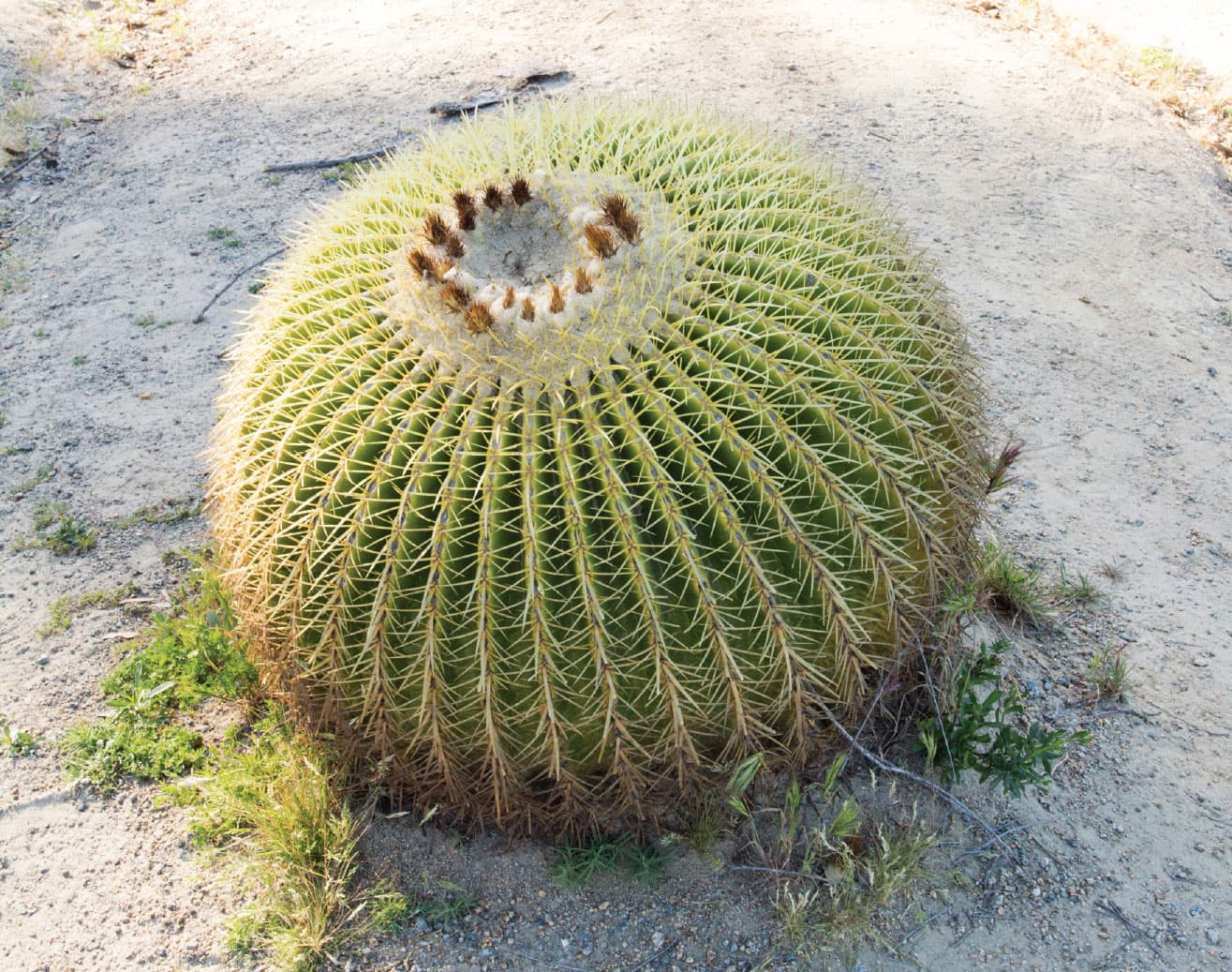
Echinopsis chamaecereus
PEANUT CACTUS
FAMILY: Cactaceae
ORIGIN: Argentina
CULTURE: Best in a pot with well-drained soil in a sunny spot. Needs a period of cool rest in winter for best flower production.
COLD HARDINESS: 20°F (–6.7°C)
PROPAGATION: By offsets
BLOOM TIME: Late spring
With the peanut cactus, plant enthusiasts have taken a nearly extinct species and made it one of the most popular and common cactuses in the world. Echinopsis chamaecereus was collected and described at the beginning of the twentieth century but has never been found in the wild again. It’s a small cactus with finger-like columns and bright scarlet flowers that are often produced in profuse quantities. As the cactus ages, the columns eventually become woody and spineless. This plant looks great in pots and hanging baskets. A pure yellow mutation also exists and is quite popular. Because it has no chlorophyll, the plant can’t make its own food and so must be grafted onto another cactus with chlorophyll in order to survive.
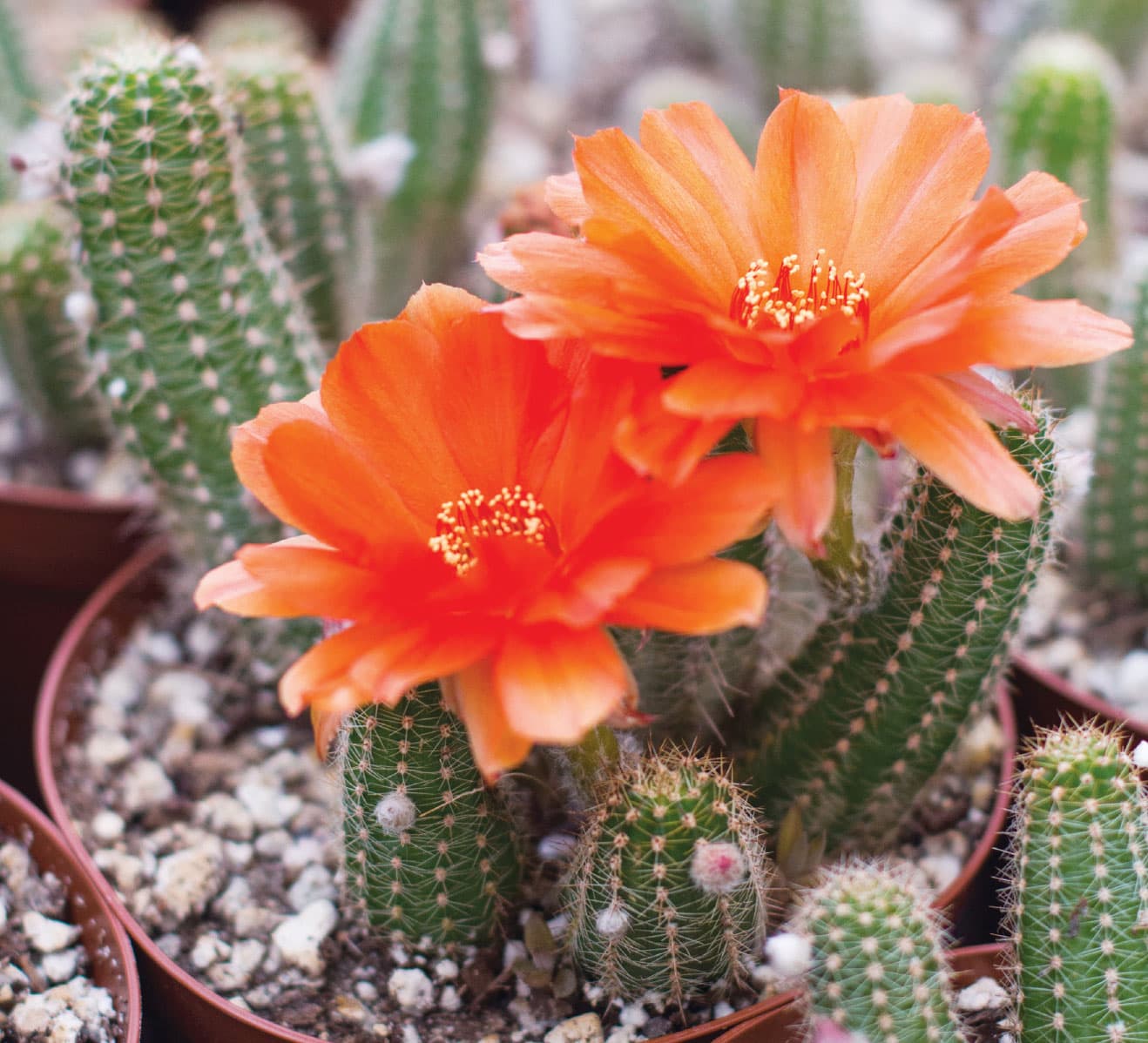
Espostoa lanata
PERUVIAN OLD MAN CACTUS, SNOW POLE CACTUS
FAMILY: Cactaceae
ORIGIN: Southern Ecuador, northern Peru
CULTURE: Water thoroughly when soil is dry to the touch, but water should be infrequent in cold winter months and soil should not remain waterlogged.
COLD HARDINESS: 25°F (–3.9°C) (for brief periods, prefers no frost)
PROPAGATION: By seed
BLOOM TIME: Late spring or early summer
Hairy cactuses are always popular with collectors, and this one is no exception. Espostoa lanata is a columnar cactus with dense white hair and golden spines. The woolly hairs from the stem have been used for pillow filling in Peru. It is native to mountainous regions at elevations of 4,000'–7,000' (1219 m to 2134 m). In time, it will form a branched, tree-like columnar to 6' (1.8 m) ded pumice or perlite for extra drainage. Espostoa requires bright light to produce dense hairs, but, as a former mountain dweller, does not care for extremely high temperatures. It is best to refrain from watering on cloudy, overcast, or very humid days as well. As the plant matures, it develops a cephalium (a dense growth of wool-like spines on one side of the column near the growing tip). White to purple flowers are borne from this hairy growth.
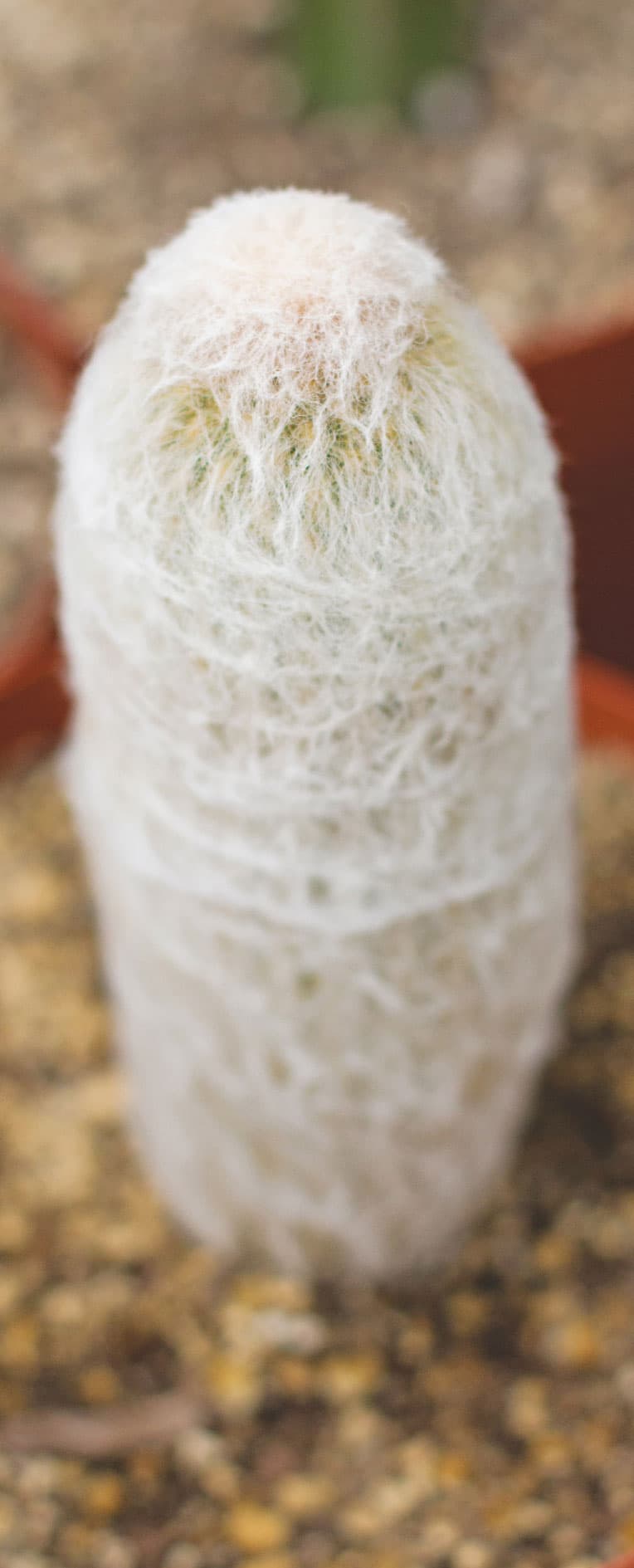
Euphorbia anoplia
ZIPPER PLANT
FAMILY: Euphorbiaceae
ORIGIN: South Africa
CULTURE: Light shade and keep dry in winter (November–March).
COLD HARDINESS: 40°F (4.5°C)
PROPAGATION: By stem cuttings, seed
BLOOM TIME: Spring to summer
Euphorbia anoplia, native to South Africa, is a short, chunky green plant forming dense clusters. The common name, zipper plant, comes from the patterns along margins of angled stems that resemble a zipper. Like many euphorbias, it responds well to warmth and its active growth period is late spring and the summer months. Plants develop into a colony of leafless ribbed columns. The columns are usually somewhat variegated to green with small dark burgundy flowers at the column tips during the growing season. Zipper plants do well in fast-draining rock gardens and containers. For best appearance, protect from frost that can scar or discolor the stems. Be cautious with irritating sap if handling.
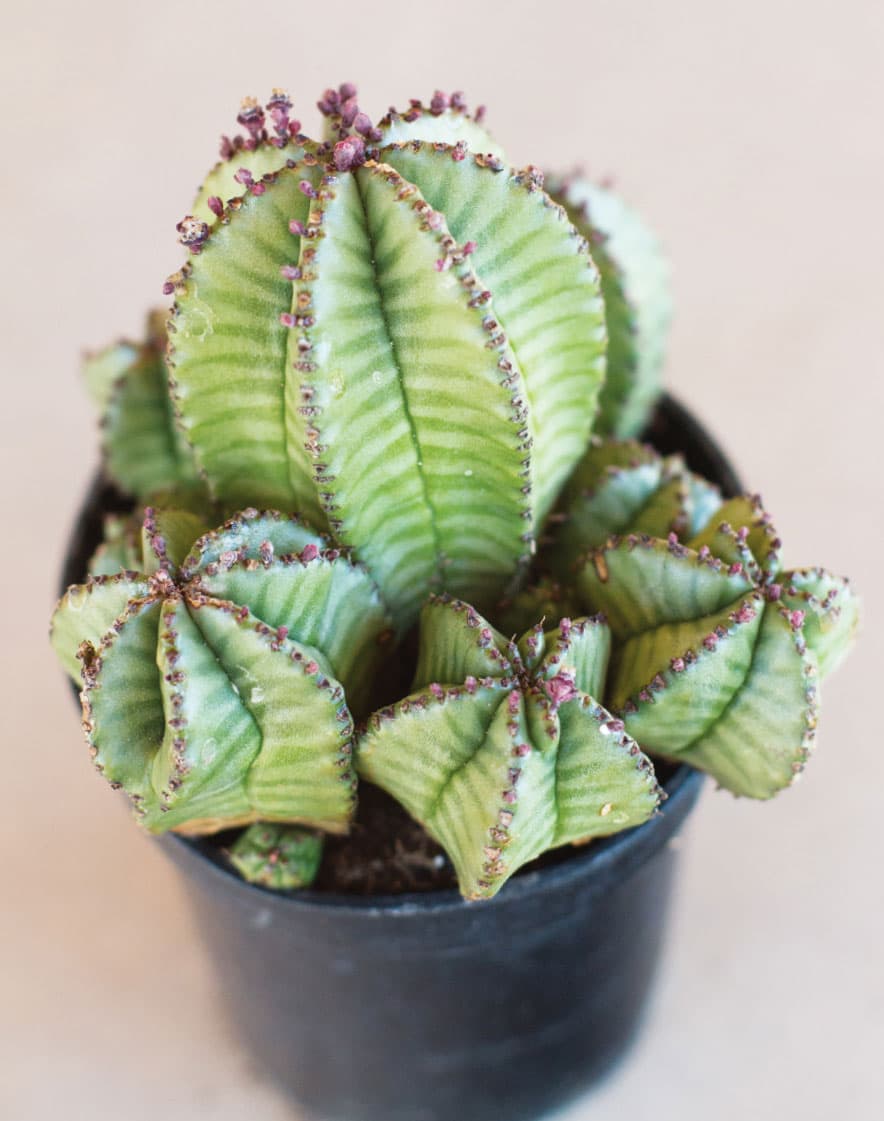
Euphorbia flanaganii
MEDUSA’S HEAD
FAMILY: Euphorbiaceae
ORIGIN: Eastern Cape of South Africa
CULTURE: Can tolerate light shade. Water sparingly during the summer and keep mostly dry in winter. Good drainage is essential.
COLD HARDINESS: 32°F (0°C)
PROPAGATION: By seed, cuttings
BLOOM TIME: Sporadically everblooming
Euphorbia flanaganii is one member of an intriguing group of succulents known as the “medusoid euphorbias” because of their form, which consists of a central head sprouting numerous snakelike arms resembling locks of hairs. The central stem merges into roots and forms a tuberous body with branches radiating from it. Gazing down upon a large specimen presents the viewer with a sunflower-like display. This is another instance of nature’s living patterns as a Fibonacci spiral. A specimen plant is a delight to see. When in full bloom, each snaky finger is covered with fragrant yellow flowers and the cluster is ethereal. It adapts well to being planted in containers, window boxes, and hanging baskets.

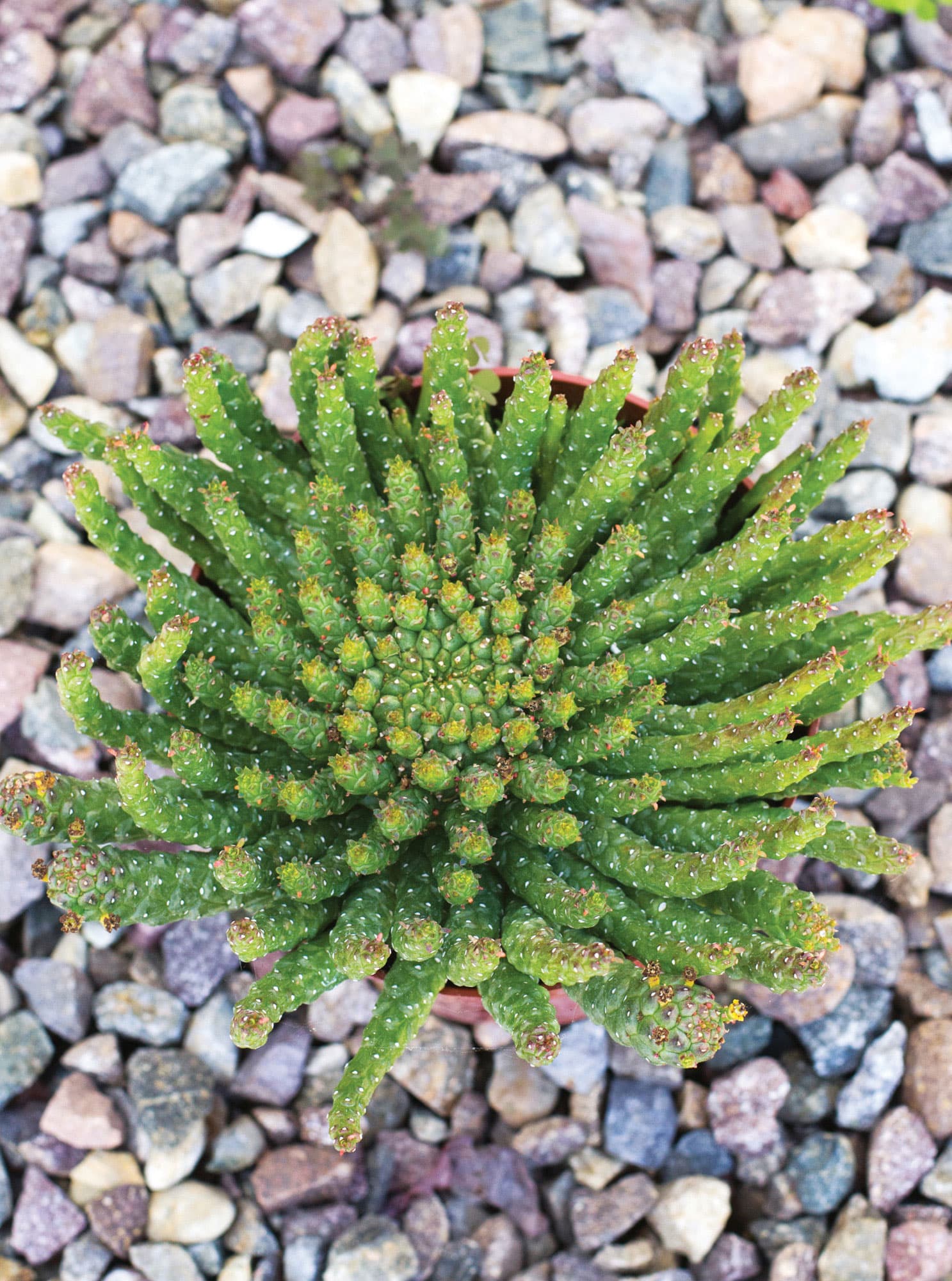
Euphorbia flanaganii cristata
GREEN CORAL
FAMILY: Euphorbiaceae
ORIGIN: Nursery-produced cultivar
CULTURE: Needs good drainage. Water sparingly during the summer months and keep on the dry side in winter.
COLD HARDINESS: 35°F (1.7°C)
PROPAGATION: By cuttings
BLOOM TIME: Does not bloom
Here is a phenomenal, nursery-found cristation. Unlike monstrose varieties of plants, where the differentiation from normal growth is due to a genetic mutation, crested growth can occur on normal plants. Causes for the aberrant growth are not specifically known, but may result from variances in light intensity or mechanical damage. Crested plants may have some areas that exhibit normal growth, and a cresting plant that looks like a brain may revert back for no apparent reason. Normal growth should be pruned out and only the crested part of the plant should remain or the normal growth may overcome the crest. Green coral is a fantastic crested form of euphorbia that forms a tight mound 4" to 5" (10.2 cm to 12.7 cm) high by up to 12" (30.5 cm) wide. The stems fold back and forth in a ribbon pattern to give the plant a bizarre coral or brain-like form. As the plant ages, it will also form a very nice caudiciform base. The tight, compact form of this euphorbia provides a conversation piece for the mixed potted succulent garden or as a beautiful solitary specimen. It also works well in the ground in mild areas, assuming the soil is fast draining. If grown in high light, the plant will develop a handsome maroon ribbon along the top of the crest.
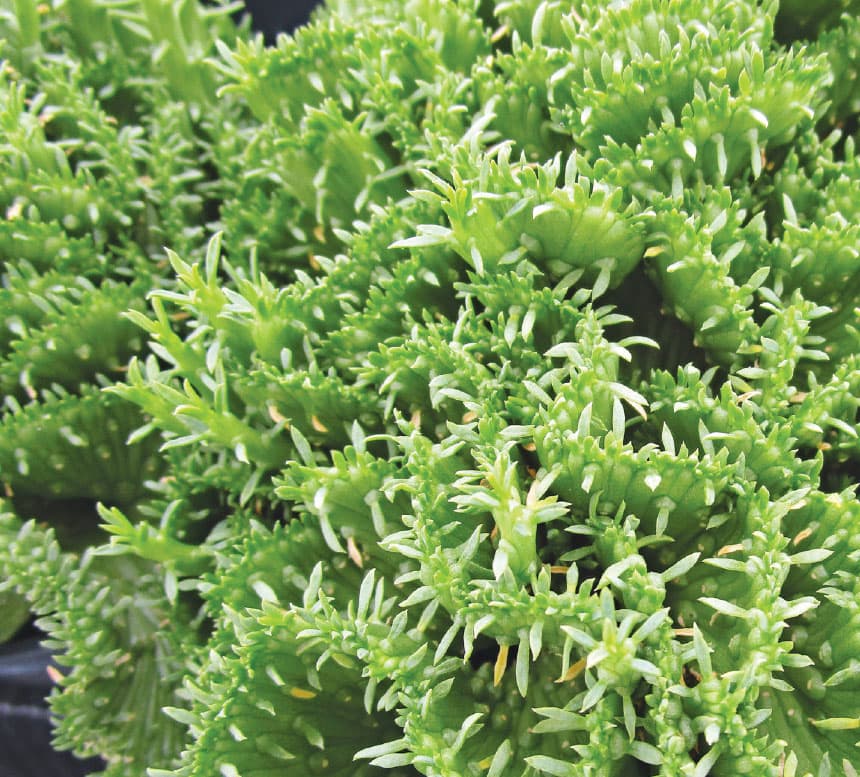
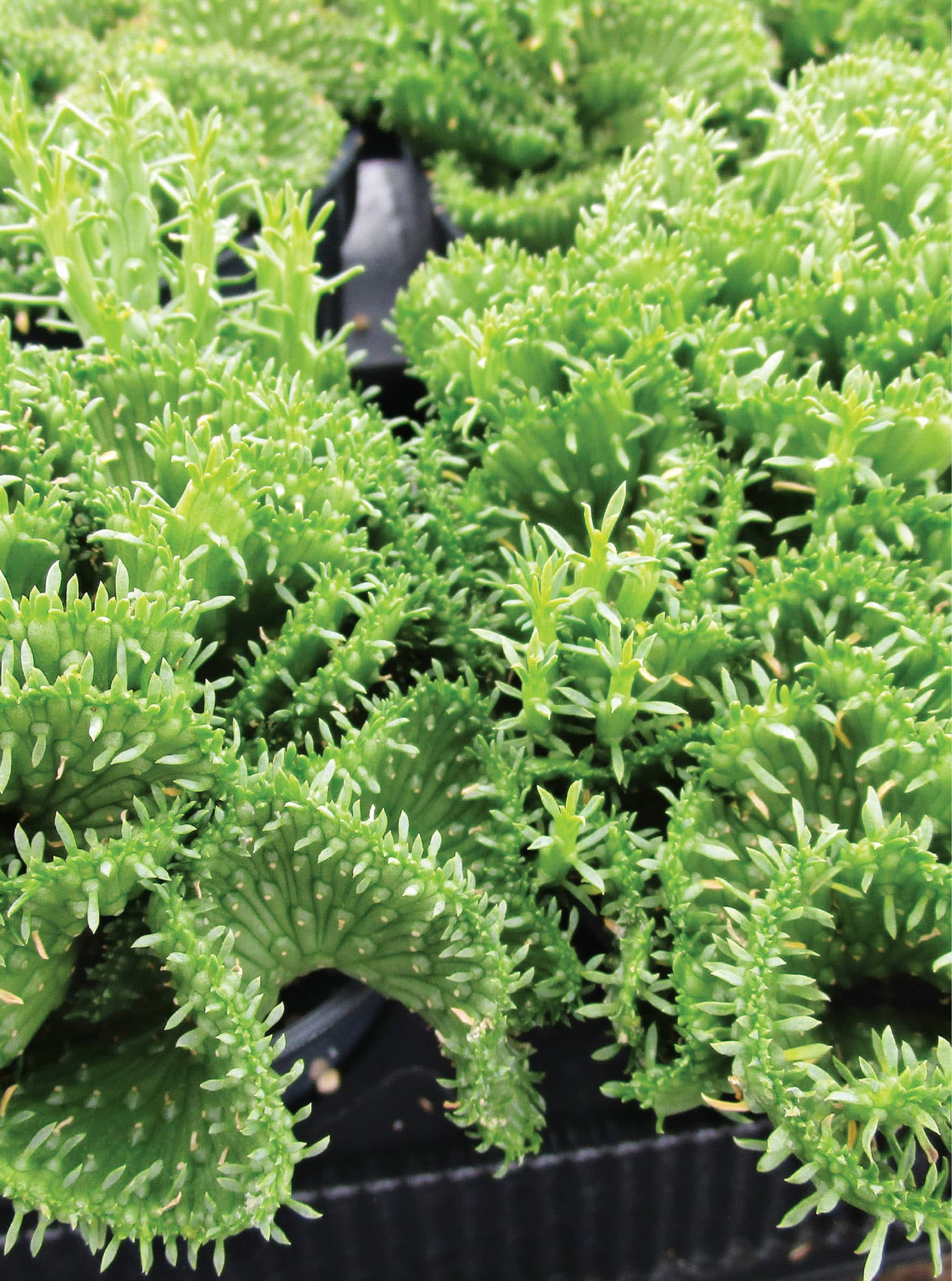
Euphorbia mammillaris variegata
CORN COB EUPHORBIA
FAMILY: Euphorbiaceae
ORIGIN: Tropical and southern Africa
CULTURE: Easy to grow in well-drained soil in half or full sun.
COLD HARDINESS: 45°F (7.2°C)
PROPAGATION: By seed, cuttings
BLOOM TIME: Late winter to early summer
Euphorbia mammillaris is a plant species endemic to the Cape Province of South Africa. The common name reflects the growth habit of forming stems in rows that look like corn cobs. They are a light green with dark green hints and tips that turn pink in the sun. Active growth occurs in the late spring and summer months. Water thoroughly when the soil is dry to the touch during this period. Bright light is mandatory to keep this succulent looking its best. It needs to rest in winter and should be given less water during this period. As with all euphorbias, handle with care.

Euphorbia milii
CROWN OF THORNS
FAMILY: Euphorbiaceae
ORIGIN: Madagascar
CULTURE: Grow in full sun to light shade. Needs porous, well-draining soil, and water occasionally, allowing the soil to dry slightly before watering again. One of the easiest euphorbias to grow.
COLD HARDINESS: 25°F (–3.9°C) for brief periods
PROPAGATION: By seed, cuttings
BLOOM TIME: Year-round
The common name refers to the belief by some that the crown of thorns worn by Jesus Christ at the crucifixion may have been made from the stems of this plant. Indeed, historical evidence suggests that the plant may have been introduced to the Middle East prior to the birth of Christ. Euphorbia milii is a woody, succulent shrub that has bright green leaves and thick, sharp, black thorns that cover its water-storing branches and stems. In Madagascar, this shrub typically grows in a sprawling form to 5' to 6' (1.5 m to 1.8 m). While these features alone still make for an interesting succulent, the flowers raise the interest to fascination. Similar to poinsettias, the colorful part of the crown of thorns “flower” is not petals in the usual sense, but leaf-like bracts of poinsettia-red color. The plant has been beloved by gardeners for ages, but the new hybrids from Thailand have made the plant trendy. The Thai hybrids include plants with larger flower clusters approaching hydrangeas in showiness and come in a wide range of color combinations. They have more of an upright form that does not become a twisted mass like the species. The leaves tend to be larger and brighter. These hybrids tend to be a little more frost tender than the species.
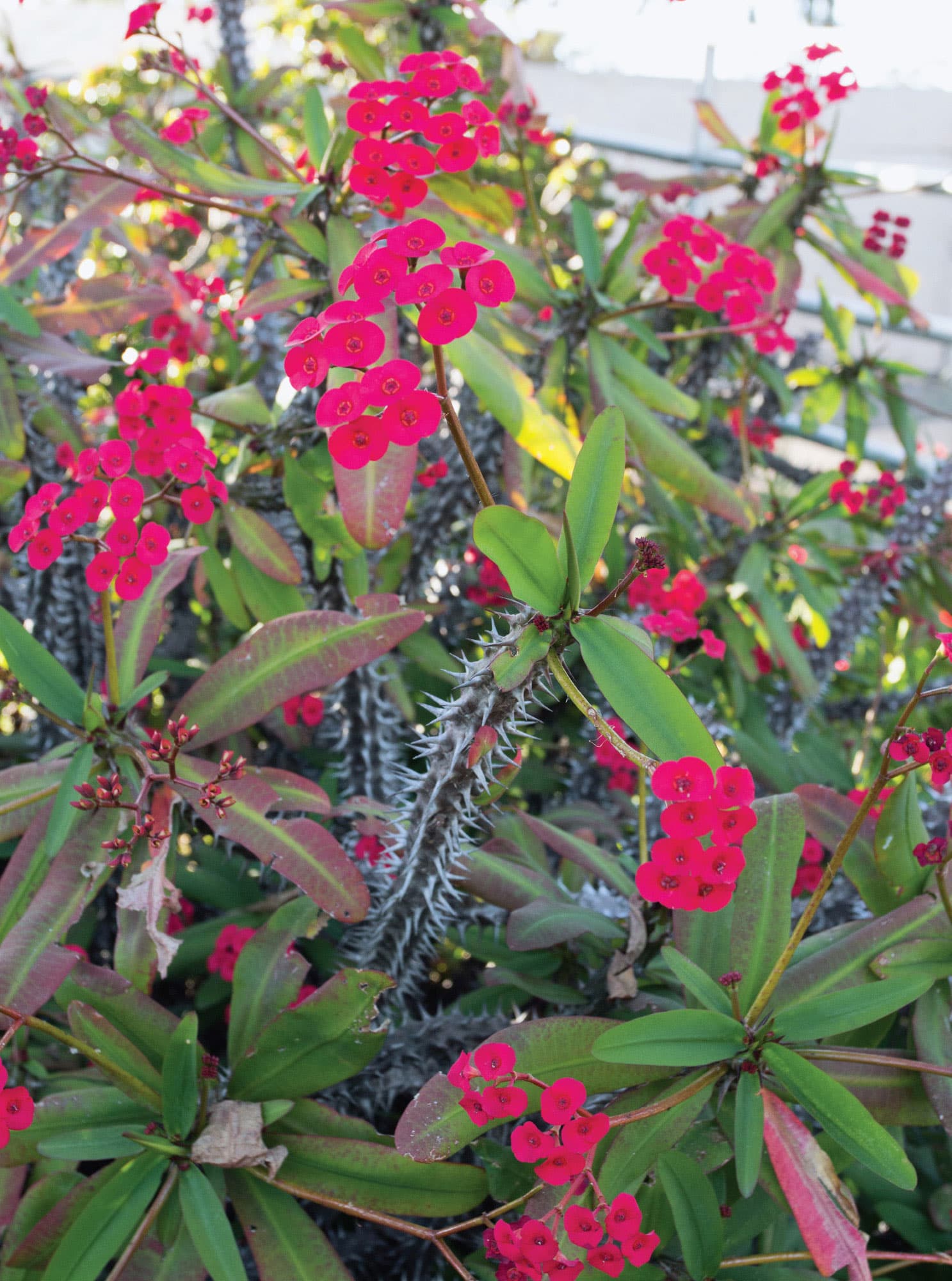
Euphorbia obesa Hybrid
BASEBALL PLANT, SEA URCHIN
FAMILY: Euphorbiaceae
ORIGIN: Northern Cape region of South Africa
CULTURE: Prefers sun, but can tolerate moderate shade. Good drainage is essential. Water sparingly during the summer and keep dry in winter.
COLD HARDINESS: 25°F (–3.9°C) if roots are kept dry
PROPAGATION: By seed, cuttings if available
BLOOM TIME: Summer
Plants that mimic objects or other creatures are often decimated in the wild as collectors remove them from their habitat. Fortunately, wild harvesting of this plant was stopped early in the twentieth century and it survives quite nicely. Euphorbia obesa is a captivating plant with a spherical grayish green body with transverse bands of different shades of green. Often, especially in bright light, these bands can be an attractive contrasting purplish bronze. The peculiar, almost ball-shaped dwarf succulent makes a great conversation piece. It can grow to 8" (20.3 cm) in height with a diameter of 3.5" (9 cm). It is a single-stemmed, unbranched, firm-bodied plant. In younger plants, the stem is usually eight-angled, grooved, and a rounded sea urchin–like shape. As the plant ages, it elongates and becomes more cylindrical. The baseball plant also has a tapering taproot, so grow in deeper rather than more shallow containers. This hybrid variety grows slightly more pointed with deeper rib sections and is prolific at creating offsets. The current thought is that Euphorbia heptagona is involved in this cross.
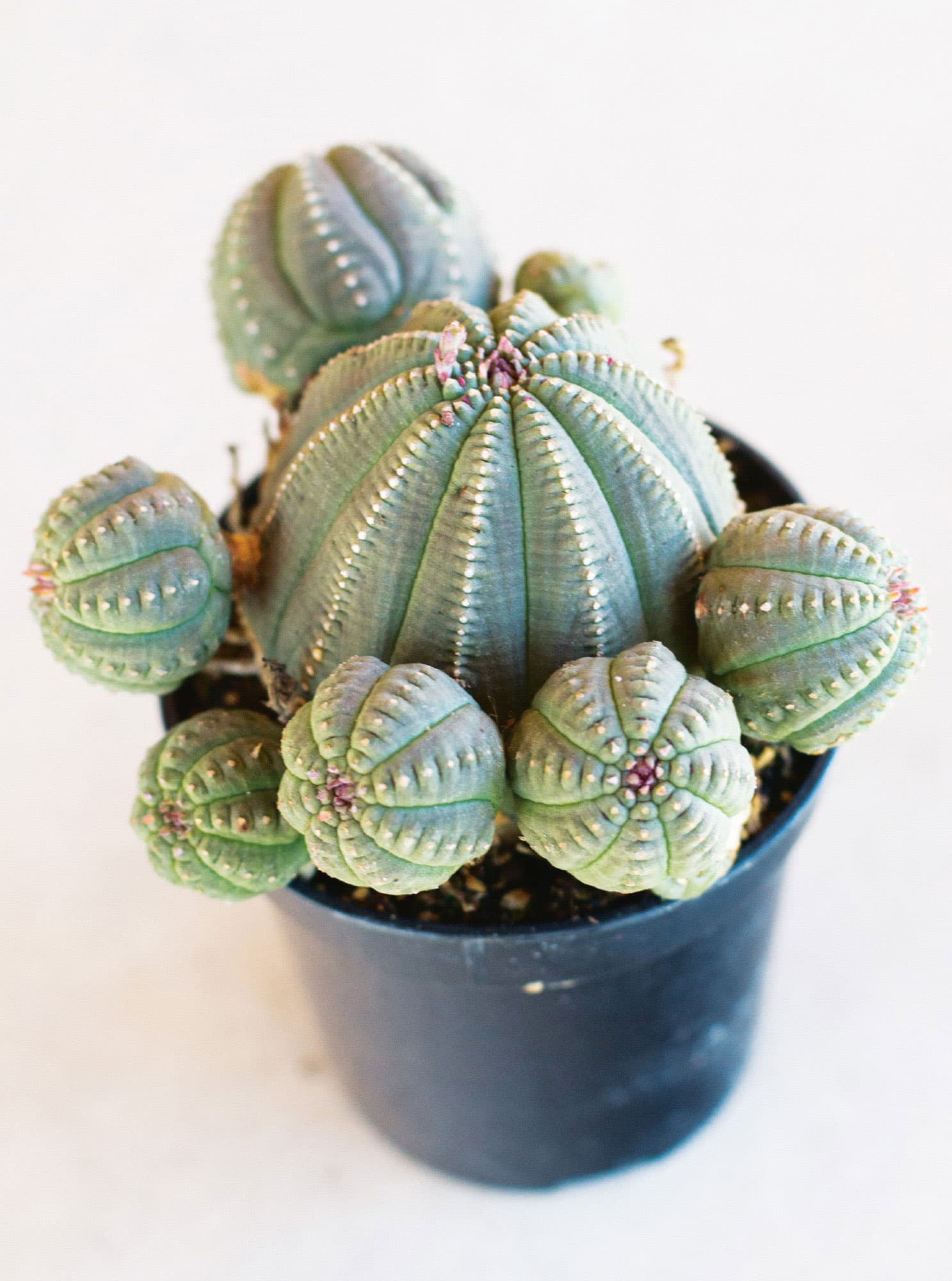
Euphorbia polygona ‘Snowflake’
AFRICAN MILK BARREL, SNOWFLAKE EUPHORBIA
FAMILY: Euphorbiaceae
ORIGIN: South Africa
CULTURE: Porous soil with adequate drainage.
COLD HARDINESS: 25°F (–3.9°C)
PROPAGATION: By cuttings, offsets
BLOOM TIME: Year-round
‘Snowflake’ is a selected cultivar of the species E. polygona. Rather than the dull-green stems of the species, this cultivar boasts a chalky-white body and has fewer spiny protuberances, if any. Reports are that only a single ‘Snowflake’ was ever found in the Eastern Cape province of South Africa. All plants now marketed are descendants of that one specimen. Many new hybrids have been created using ‘Snowflake’, as it tends to pass on excellent genetics for attractive plants. It responds well to warmth, with its active growth period in the late spring and summer months. The plant requires bright light for best appearance, and should be given a winter resting period, during which less water should be given. Protect from frost.
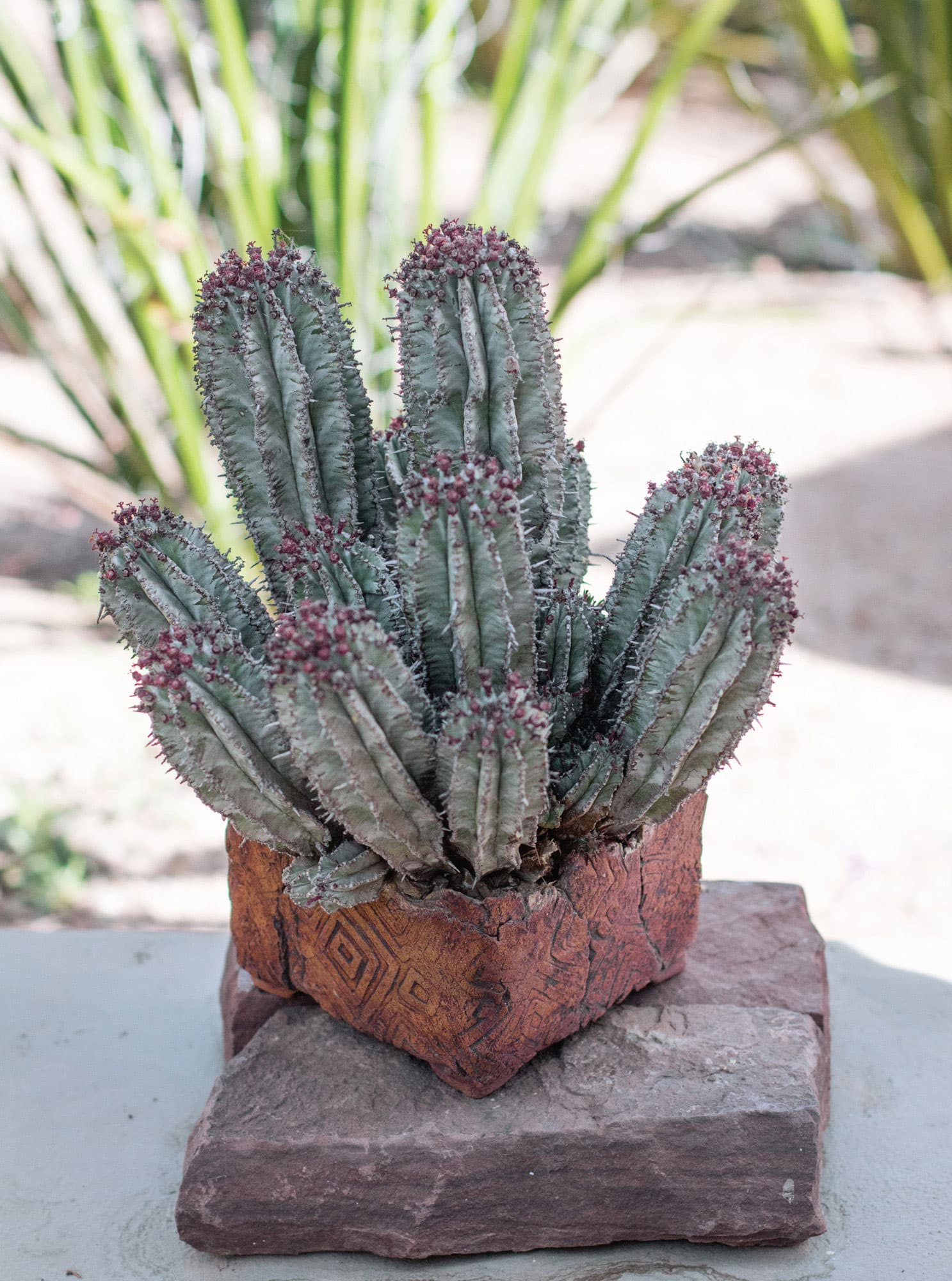
Euphorbia tirucalli ‘Firesticks’
FIRE STICKS, STICKS OF FIRE, RED PENCIL TREE
FAMILY: Euphorbiaceae
ORIGIN: South Africa
CULTURE: Full sun to partial shade; well-draining, porous soil; and thorough watering, allowing the soil to dry before repeating. Reduce water in winter.
COLD HARDINESS: 30°F (–1.1°C)
PROPAGATION: By cuttings
BLOOM TIME: Insignificant spring flowers
A native of arid South Africa, this striking succulent is an ideal specimen plant for containers or for use as a landscape feature in frost-free climates. Multiple fire-red stems, resembling small pencils or sticks, grow from the base of the plant. The red stems often show shades of pink, orange, or yellow, and the color is more vivid during the cooler months of late fall though winter. The colors revert with the coming of summer heat and it becomes an attractive green succulent. ‘Firesticks’ is extremely heat tolerant, drought tolerant, and virtually pest free. The plant is a form of Euphorbia tirucalli, which can grow to 25' tall by 8' to 10' wide (7.6 m tall by 2.4 to 3 m wide), but ‘Firesticks’ lacks the chlorophyll of the species and will probably stay under 8' (2.4 m) in height. Remember that the milky sap is toxic. Be careful not to touch your eyes when handling this plant, as intense burning can occur.
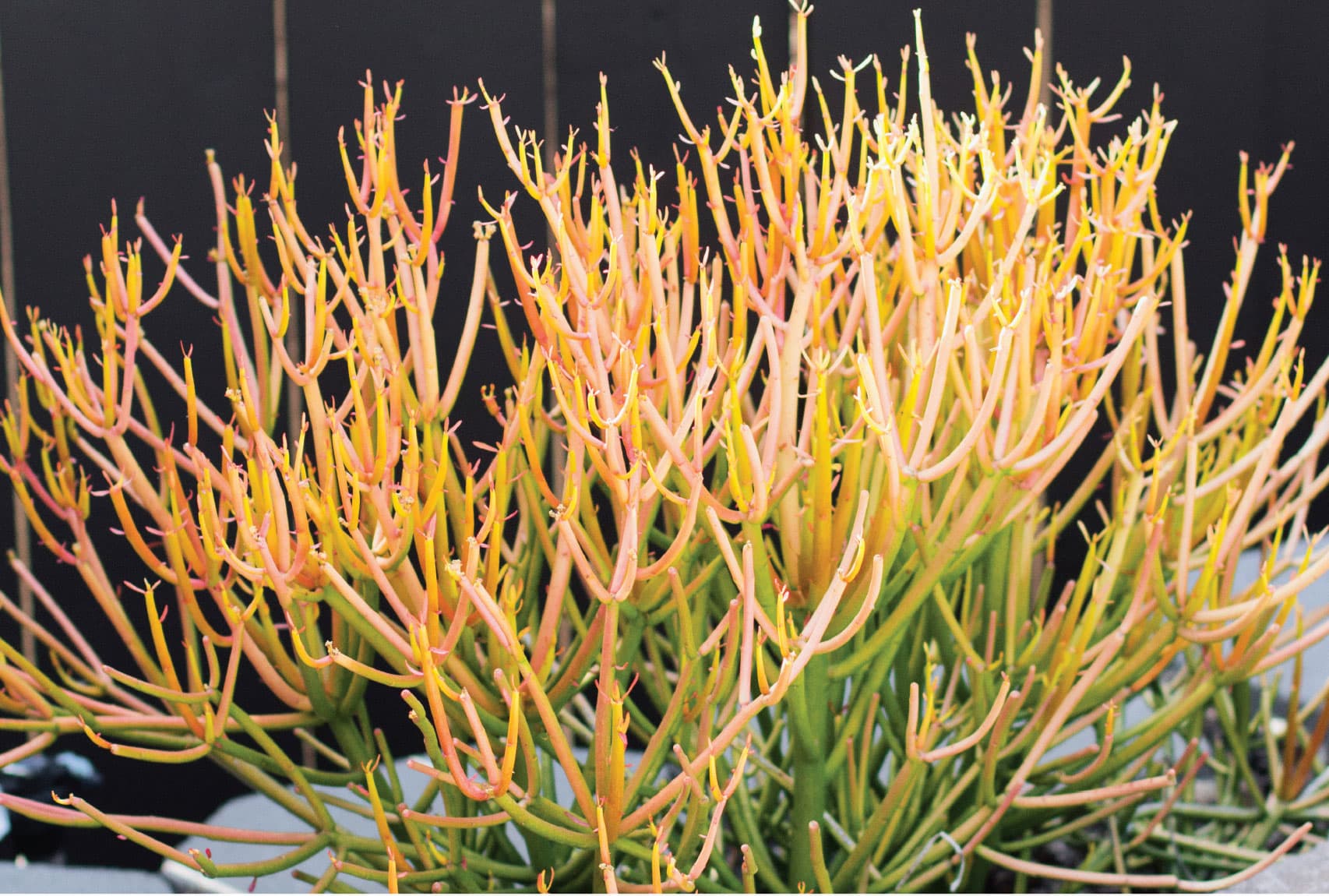
Euphorbia trigona ‘Royal Red’
ROYAL RED MILK TREE
FAMILY: Euphorbiaceae
ORIGIN: Western Africa
CULTURE: Porous soil with adequate drainage. Water thoroughly when soil is dry to the touch during the active growing season.
COLD HARDINESS: 40°F (4.4°C)
PROPAGATION: By cuttings
BLOOM TIME: Never been known to flower
Euphorbia trigona is a frost-tender, evergreen succulent. The stems have three winglike angles and carry short, sharp spines as well as leaves. Eventually, the plant grows into a dense, compact branched shrub 4' to 6' (1.2 m to 1.8 m) in height. ‘Royal Red’ is a cultivar of the species with stems and leaves that are flushed purplish red. The leaves are usually darker red and the stems can be flecked with red shading to magenta. Excellent in bright areas of the home or office, or as a patio plant in more temperate regions. Responds well to warmth, with its active growth period in the late spring and summer months. Plants may survive brief freezing, but often permanent scarring will occur.
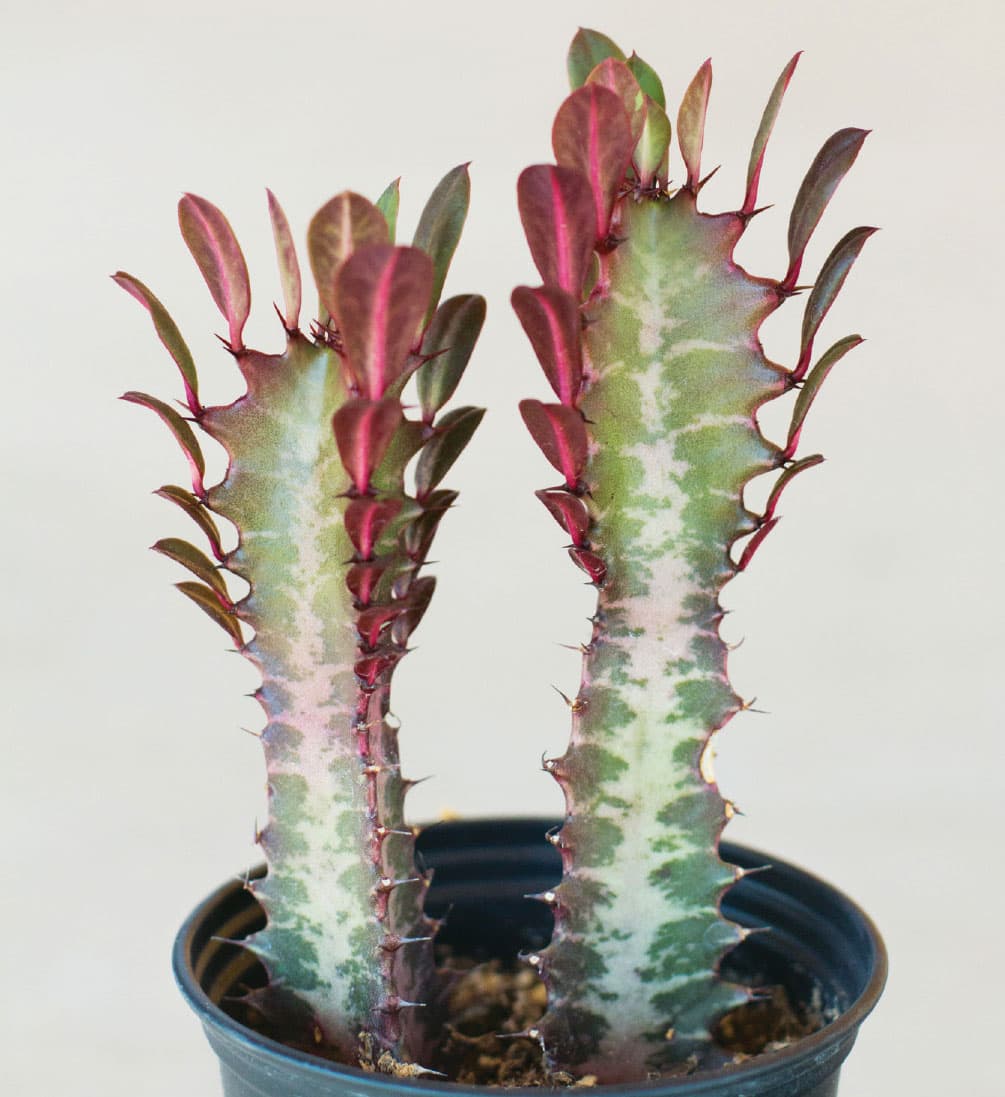
Faucaria tigrina
TIGER JAWS, SHARK JAWS
FAMILY: Aizoa ceae
ORIGIN: Eastern Cape Province, South Africa
CULTURE: Water moderately from the middle of summer to the end of winter. Keep partially shaded from hot summer sun and provide maximum light the rest of the year.
COLD HARDINESS: 30°F (–1.1°C)
PROPAGATION: Seeds or rhizome division
BLOOM TIME: Autumn to early winter
The tiger jaws plant is undoubtedly one of the world’s most popular succulents. It is an intriguing succulent with soft white teeth along the edges of its fat leaves, and it is a plant that attracts most children. With a little imagination, the leaves are reminiscent of miniature alligator jaws, but it reminds some of an obese Venus flytrap. The long, white, threadlike teeth structures are actually special adaptations that help collect water vapor from the surrounding air and direct it down toward the roots of the plant. Fog blowing in from the coast provides moisture to help plants survive the hot, arid climate of the Eastern Cape. In the garden, tiger jaws slowly sucker and spread in a circular pattern, forming rosettes of thick, fleshy, three-angled grayish green leaves. Large, silky, yellow, daisy-like flowers that open in the afternoon are a surprising bonus in the fall. The genus Faucaria is part of the family Aizoaceae, which includes the various forms of plants known as “mimicry plants.” Faucaria tigrina prefers a soil with less organic material; extra pumice or perlite provides excellent drainage essential for growing these types of plants.
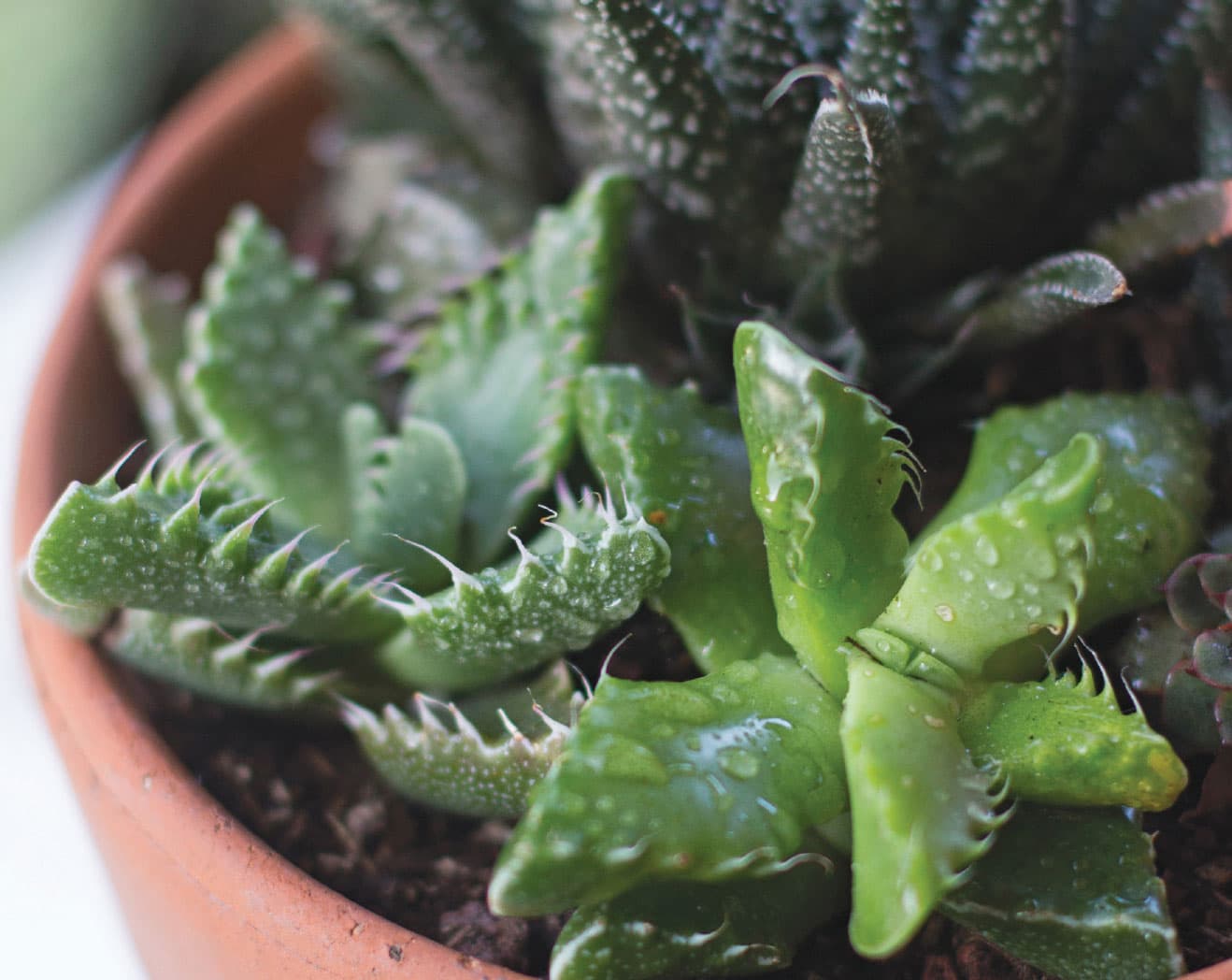
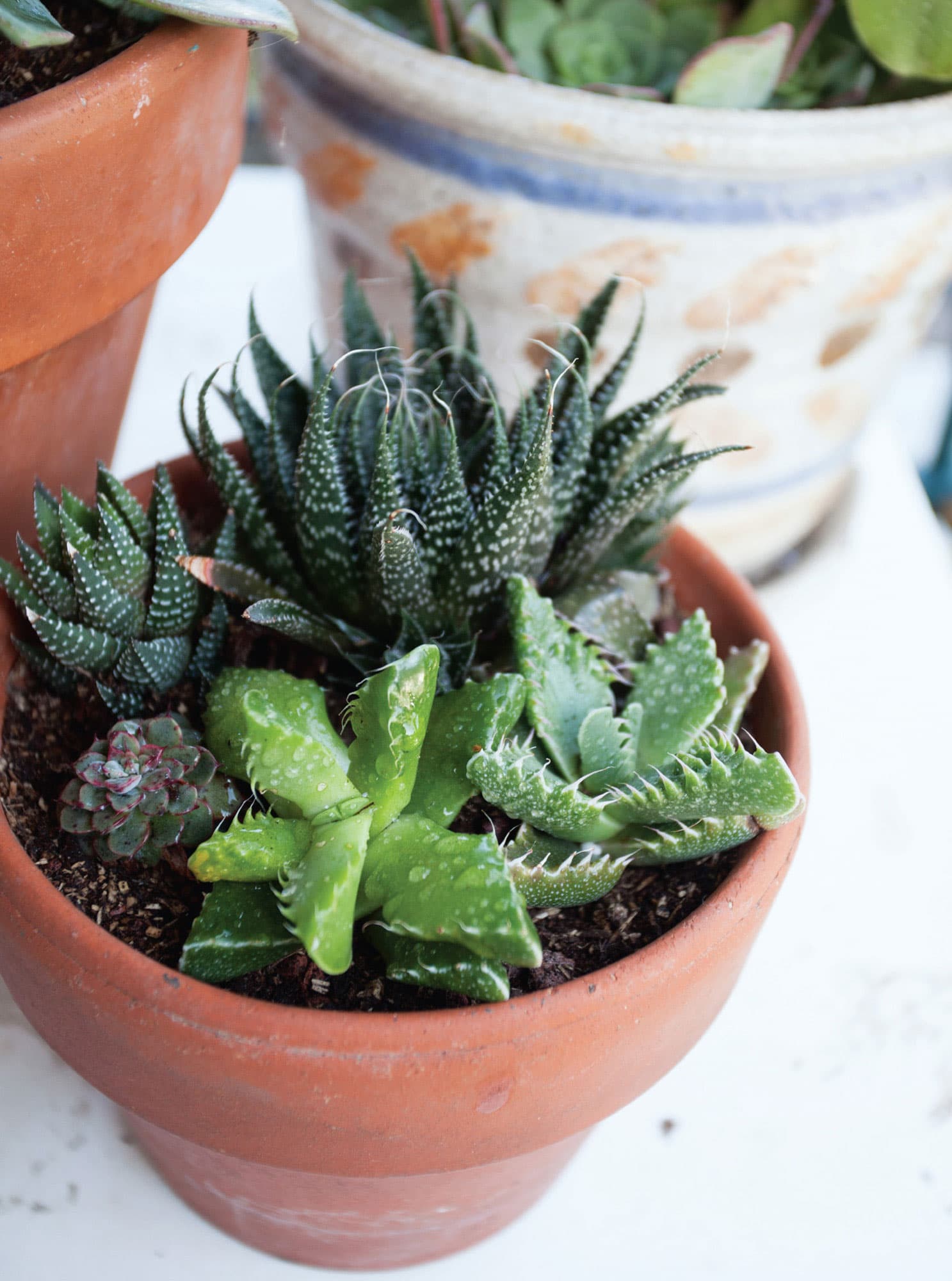
Fenestraria aurantiaca
BABY TOES, WINDOW PLANT
FAMILY: Aizoaceae
ORIGIN: South Africa
CULTURE: Full to part sun. Prefers sandy soil; water sparingly at all times to avoid root rot and split leaves. Keep on the dry side in the summer.
COLD HARDINESS: 25°F (–3.9°C)
PROPAGATION: Division or seed
BLOOM TIME: Midwinter to early spring
Fenestraria or Baby Toes are very unusual plants from the deserts of South Africa. These plants belong to a large family of Aizoaceae, which includes plants known for their ability to camouflage with their environment. Baby Toes have fingerlike leaves in upright clusters. Each “finger” has a translucent “window” at the tip. It is through this window that the harsh African sunlight is filtered to enable photosynthesis without burning the plant. Often, in habitat, only these windows are visible above the quartz sand. Prefers a soil with less organic material; extra pumice or perlite provides the excellent drainage that is essential to these types of plants. Baby Toes requires bright light to prevent the leaves from “stretching.” Water thoroughly when soil is dry to the touch, because it will not tolerate waterlogged soils. These plants are somewhat frost tolerant, but protection is advisable to prevent scarring.
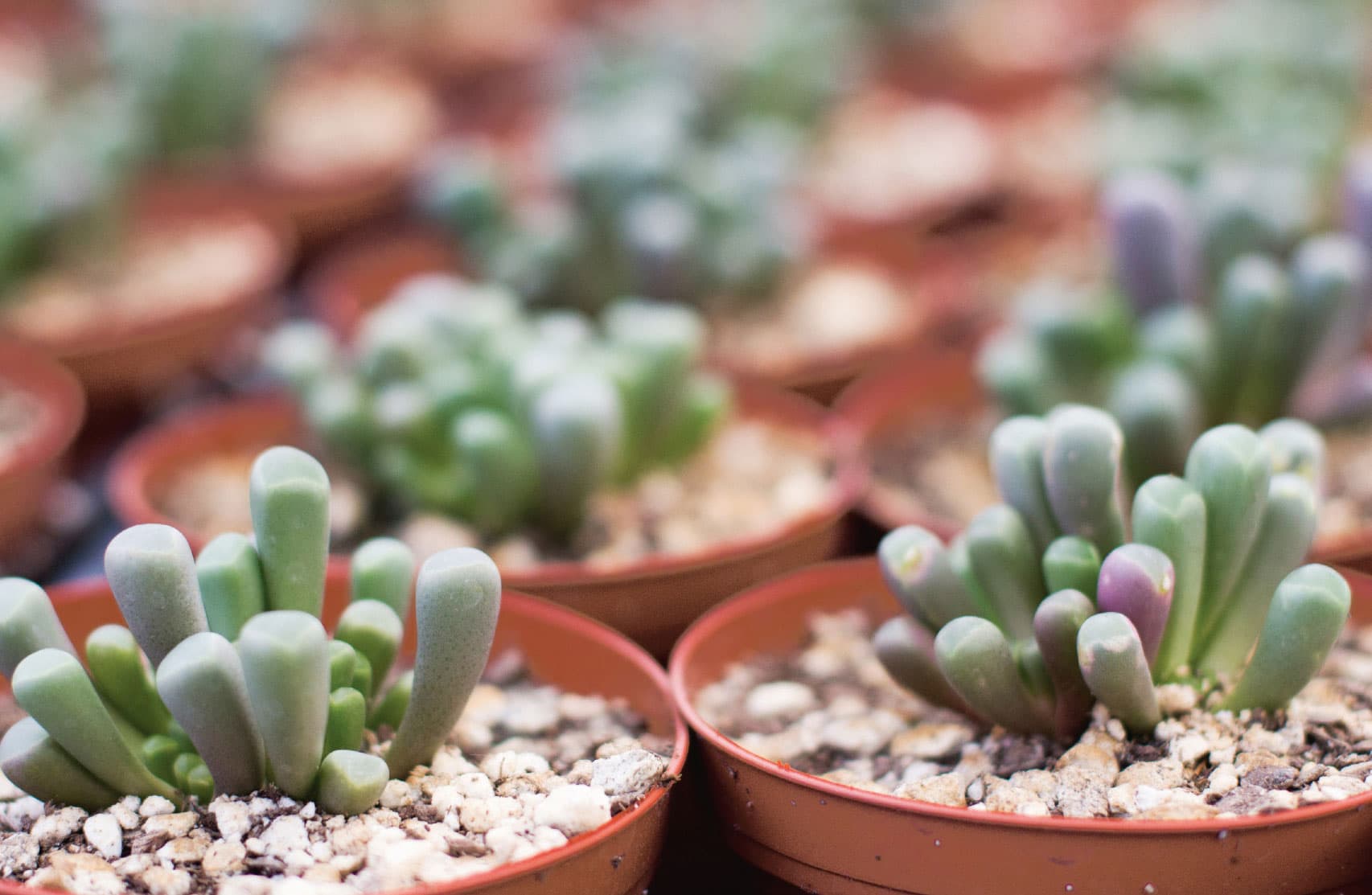
Ferocactus latispinus
DEVIL’S TONGUE BARREL CACTUS, CANDY CACTUS
FAMILY: Cactaceae
ORIGIN: Central and Southern Mexico
CULTURE: Needs full sun and well-draining, porous soil. Provide thorough watering, allowing the soil to dry during the summer growing period.
COLD HARDINESS: 30°F (–1.1°C)
PROPAGATION: Seeds
BLOOM TIME: Late summer to early autumn
The common name of Candy Cactus comes from the fact that the plant is used to make sweets. The middle is cored out and soaked in sugar, then chopped up and eaten. This beautiful cactus is put to much better use in the garden. The bold spines create a striking appearance contrasted to the brilliant green of the plant’s main body. While it is slow with growing to start, Ferocactus latispinus does well under cultivation, eventually forming a globular shape that is about 10" to 16" (25.4 to 40.6 cm) in diameter. Well-maintained plants can flower as small as 4" (10.2 cm) in diameter with pinkish purple or yellow flowers.
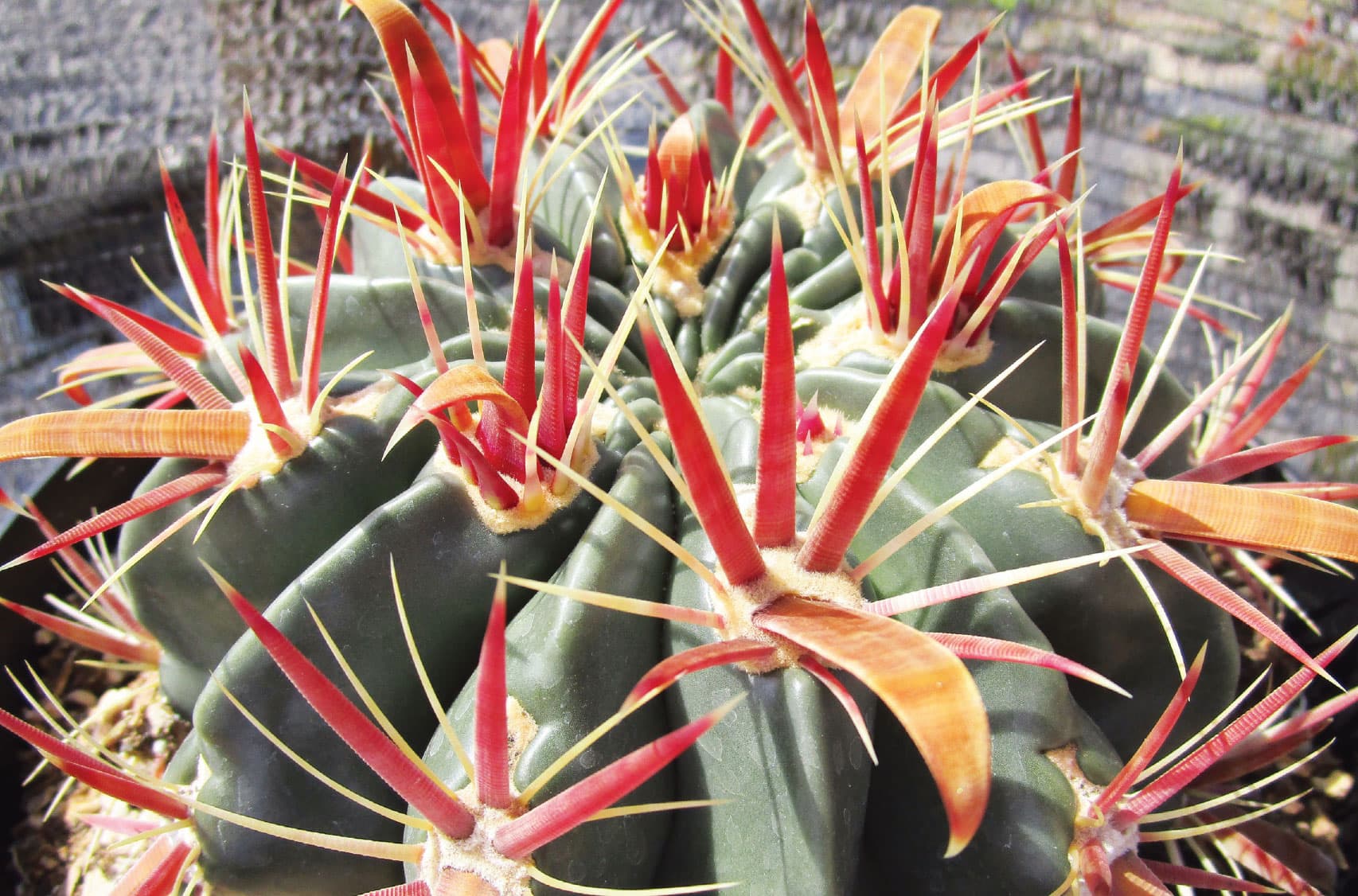
Furcraea macdougallii
MACDOUGALL’S HEMP
FAMILY: Asparagaceae
ORIGIN: Oaxaca, Mexico
CULTURE: Prefers full sun and is extremely drought tolerant.
COLD HARDINESS: 25°F (–3.9°C)
PROPAGATION: From bulbils and seeds
BLOOM TIME: Late spring to early summer
Here is definitely one of the most spectacular and dramatic plants in the Agave family. This tree, furcraea, becomes an impressive landscape plant that is prized by both designers and collectors. At about 15' (4.6 m) in height, it is certainly the tallest member of the family. The trunk is upright with blue-green leaves that are toothed, long, thin, and tapering to a soft point. The backs of the leaves have a soft, sandpapery feel. Unlike most plants in the Agave family, this plant does not sucker, but grows in a solitary, upright fashion to eventually develop a woody trunk up to 15' (4.6 m) in height. From afar, it resembles a small palm tree. Like most Agaves, it is monocarpic (dies after flowering). The flower spike is one of the wonders of the plant kingdom. Hundreds of greenish, white-edged blossoms are borne on a spike that can reach to 20' (6.1 m) above the plant! Small bulbils are produced all along the flowering stalk and fall to the ground, where they can easily be rooted.
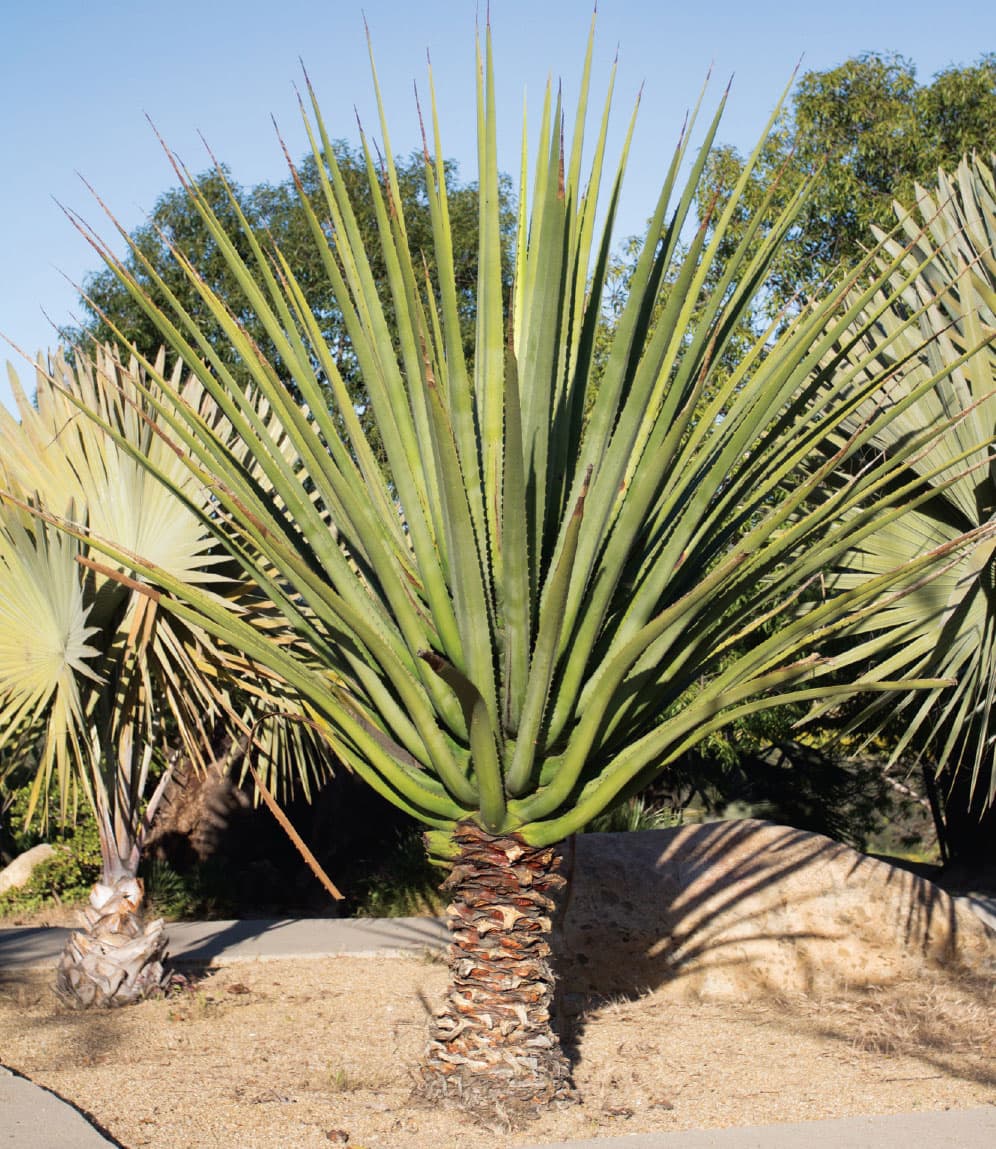
Gasteraloe ‘Green Ice’
GREEN ICE GASTERALOE, PEARL ALOE, LIZARD TAIL
FAMILY: Asphodelaceae
ORIGIN: Nursery hybrid between Aloe variegata and Gasteria ‘Little Warty’
CULTURE: Requires light shade to shade. They prefer a very porous potting mix to increase drainage. During the hot summer months, the soil should be kept moist but not overly wet.
COLD HARDINESS: 32°F (0°C)
PROPAGATION: Offshoots or leaf cuttings
BLOOM TIME: Continually, but heaviest in midwinter
Gasteraloe ‘Green Ice’ is a fat-leafed hybrid succulent raised from the cross noted above, so it has a plant body intermediate in form between an Aloe and a Gasteria. With gray-green leaves striped with deeper green and spotted with white, it becomes an instant attraction. The leaf margins are wide and unmarked. The first offsets from the center of the plant arise with a leaf arrangement in a flat plane, but as the offset grows, it begins to produce leaves that approach a whorl. Its almost everblooming greenish pink flower spikes and its ease of care are reasons for the popularity of the plant. Because it is a bigeneric cross, it is a “mule” that doesn’t produce viable seed, but is easily multiplied by separating the offshoots.
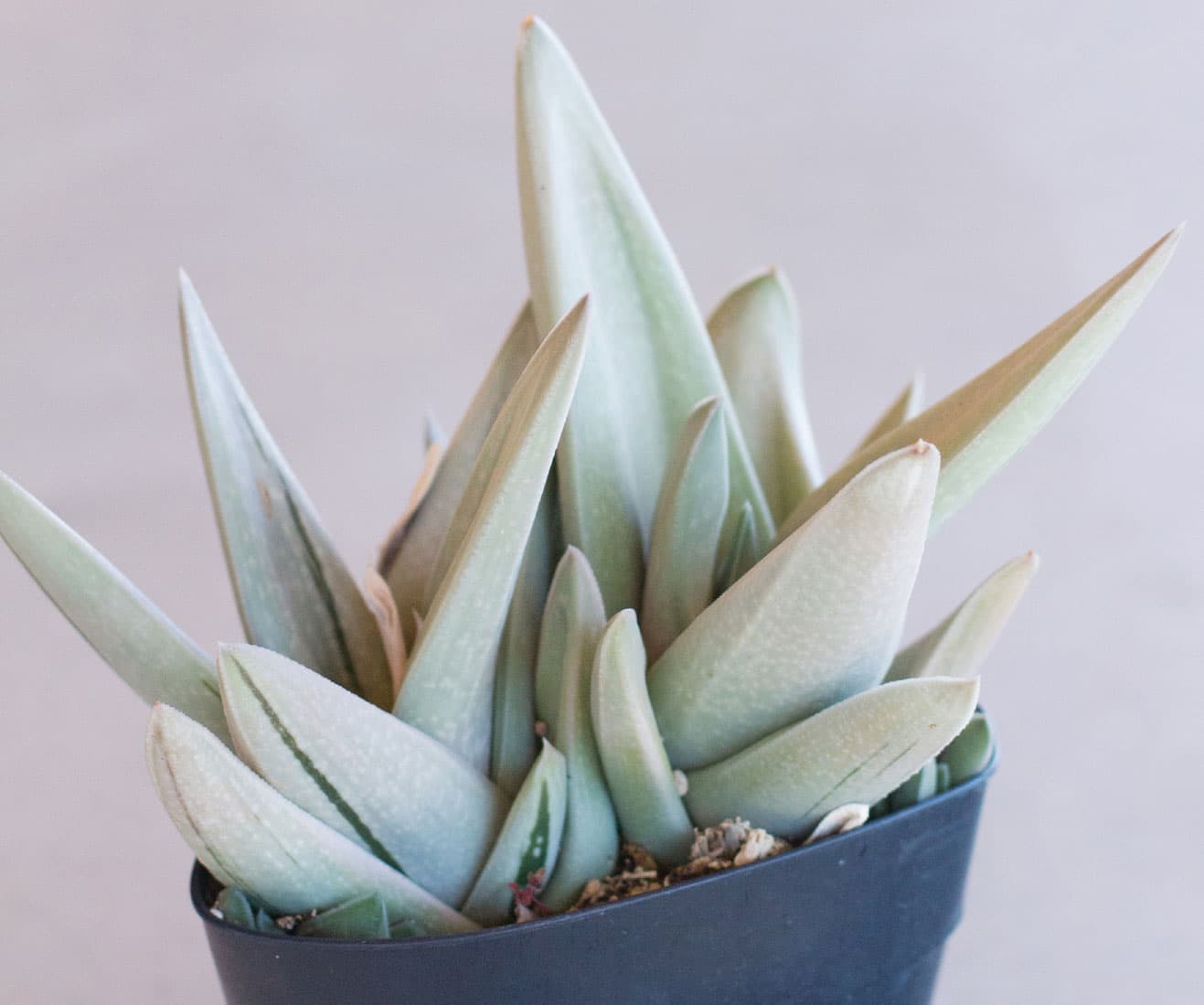
Gymnocalycium mihanovichii ‘Hibotan’
MOON CACTUS, RUBY BALL
FAMILY: Cactaceae
ORIGIN: Paraguay
CULTURE: Needs a porous, well-draining soil. Water occasionally, allowing the soil to dry slightly before watering again. Keep mostly dry in winter.
COLD HARDINESS: 40°F (4.4°C)
PROPAGATION: By grafting
BLOOM TIME: Mid-spring to midsummer
Moon cactuses undeniably have an out-of-this-world appearance. They don’t look natural because they are not. These neon-colored cactuses first made their way into Western markets in the 1960s and began to appear in mass-market outlets in the 1980s as thousands of plants were produced in Asia for export. The brightly colored cactuses are the outcome of genetic mutations. The resulting variations lack chlorophyll and the body color manifests as dazzling pink, orange, yellow, or red rather than the typical green. No chlorophyll means that the plants are incapable of producing the necessary chemical changes that are involved in photosynthesis and therefore cannot continue to grow and thrive in nature. However, if the plants are grafted onto fast-growing plants such as hylocereus, the “base” plant can provide the necessary chlorophyll for the “upper” plant to thrive. Moon cactus is an excellent subject for windowsill culture. It requires porous cactus soil with adequate drainage and prefers filtered light or shade with ample airflow. Water thoroughly when the soil is dry to the touch. Protect from frost, because the base of the plant is a tropical species of cactus.
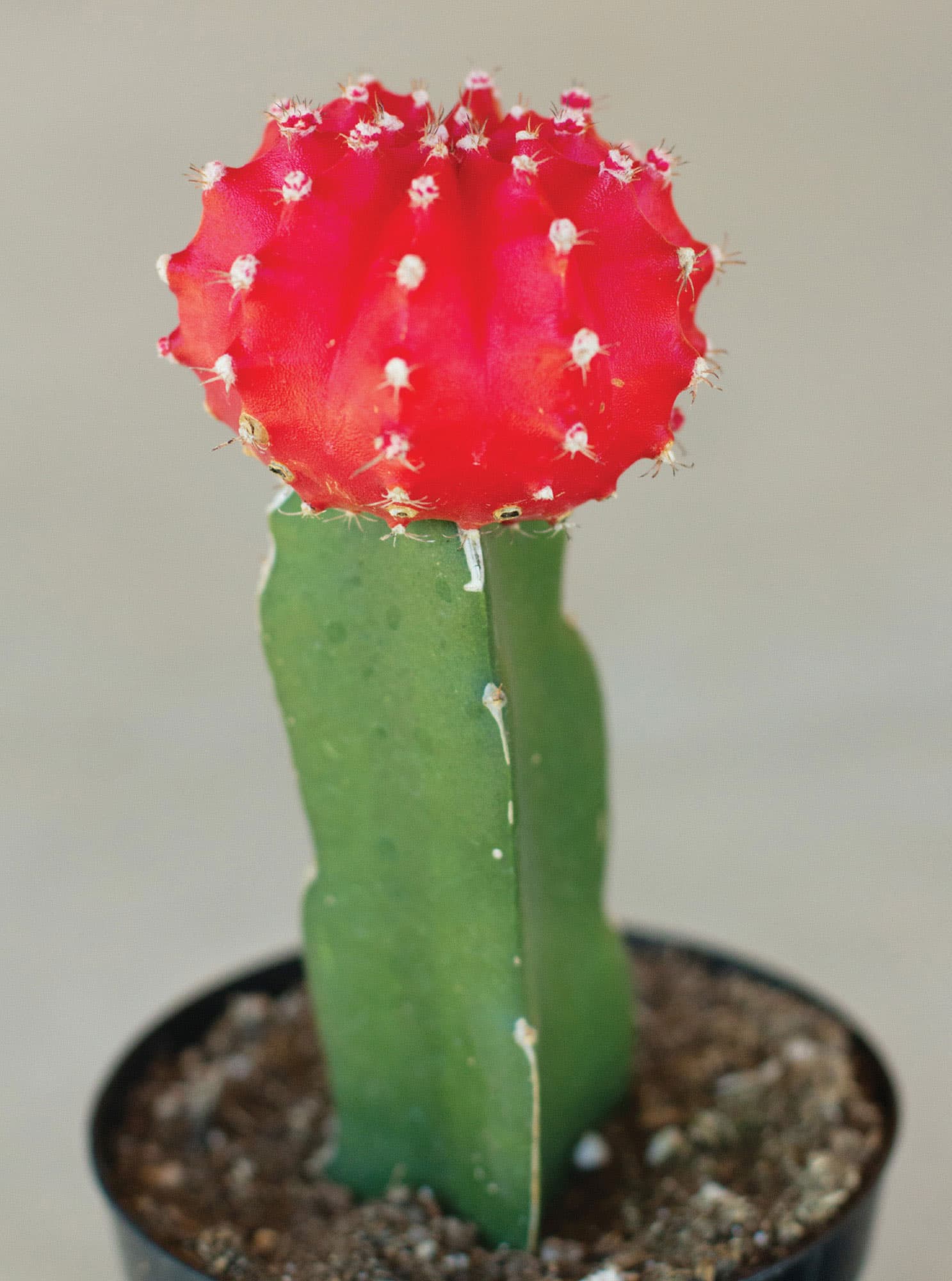
Hatiora salicornioides
DRUNKARD’S DREAM, BOTTLE CACTUS, MISTLETOE CACTUS
FAMILY: Cactaceae
ORIGIN: Brazil
CULTURE: Partial shade; appreciates more organic matter in soil medium than most terrestrial cactuses.
COLD HARDINESS: 40°F (4.4°C)
PROPAGATION: By stem cuttings
BLOOM TIME: Late winter to early spring
Hatiora salicornioides is most often called drunkard’s dream, but is sometimes called mistletoe cactus because of the white berries that follow the golden-yellow flowers. After flowering, the plant goes through a period of rest until the end of spring. The bottle-shaped leaf segments are produced on stems that are compact enough to create a full and appealing specimen. It doesn’t take long to make an excellent windowsill pot plant or an impressive hanging basket. The plant is epiphytic and grows in the crotches of trees in the rainforest or occasionally on rocks, so it thrives best in fast-draining soils. While it naturally grows in the cooler shade of trees, bottle cactus also tolerates the extreme heat of the desert, provided that it is not exposed to direct sun.
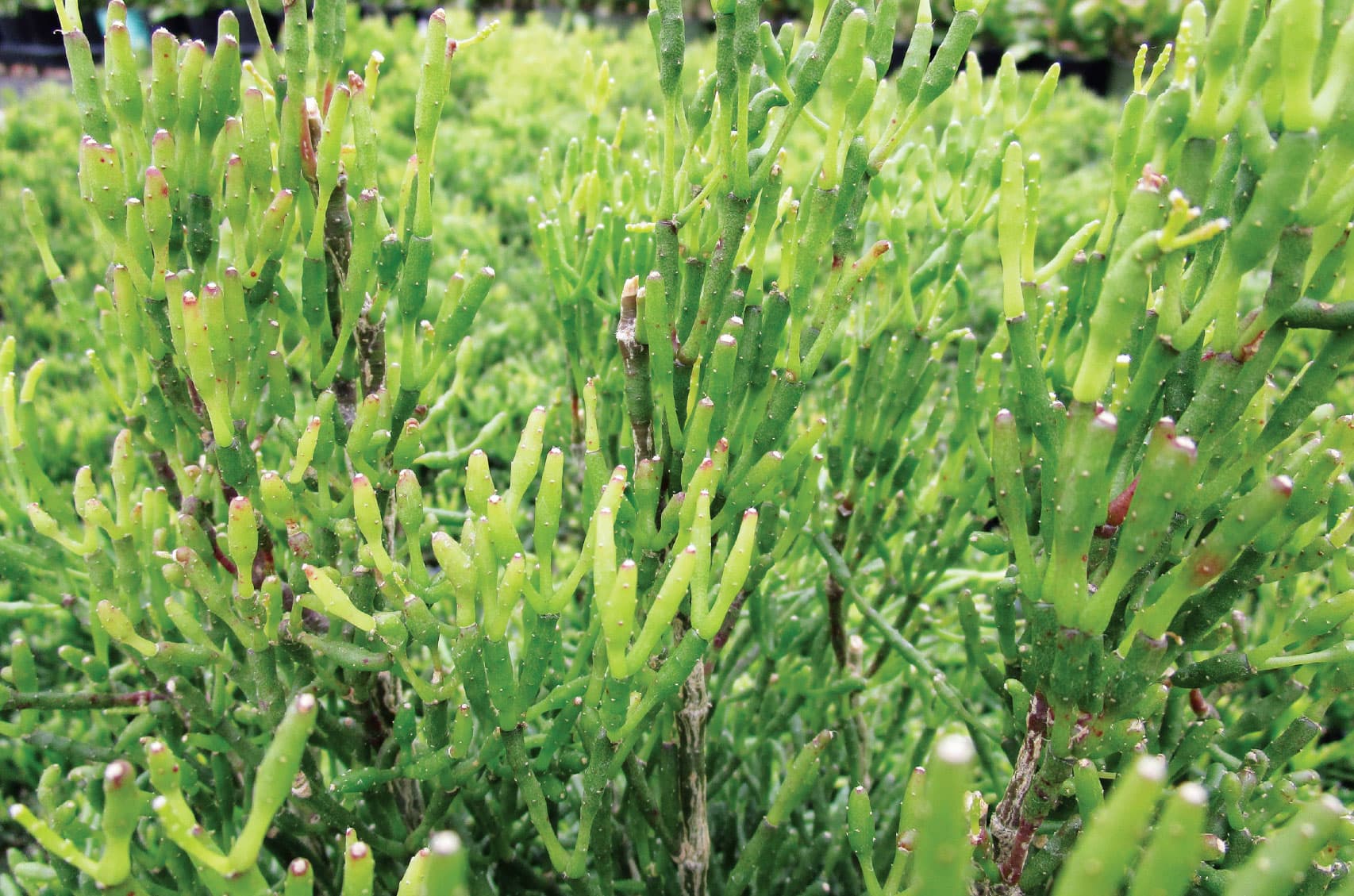
Haworthia fasciata
ZEBRA CACTUS
FAMILY: Aloaceae
ORIGIN: South Africa
CULTURE: Prefers filtered, bright light. Needs very porous soil with excellent drainage.
COLD HARDINESS: 30°F (–1.1°C)
PROPAGATION: By offsets, seed
BLOOM TIME: Mid-spring
Haworthias are easy to grow and are little jewels of various shapes and colors. Haworthia fasciata, native to South Africa, is an upright, slender rosette with tapering incurved dark green leaves covered with silvery white raised “pearls” that connect to form bands that give the impression of zebra stripes. Because of their relatively small size, they make great plants for indoor gardens. The flowers occur on a spike of 10" to 15" (25.4 to 38.1 cm) in length. Blooms are a whitish color with light reddish brown bands, and are open on two lips. Haworthias do have rather high nutrient requirements compared to other succulents. Add a water-soluble fertilizer at half strength once a month in spring and summer months to keep the plants looking their best.
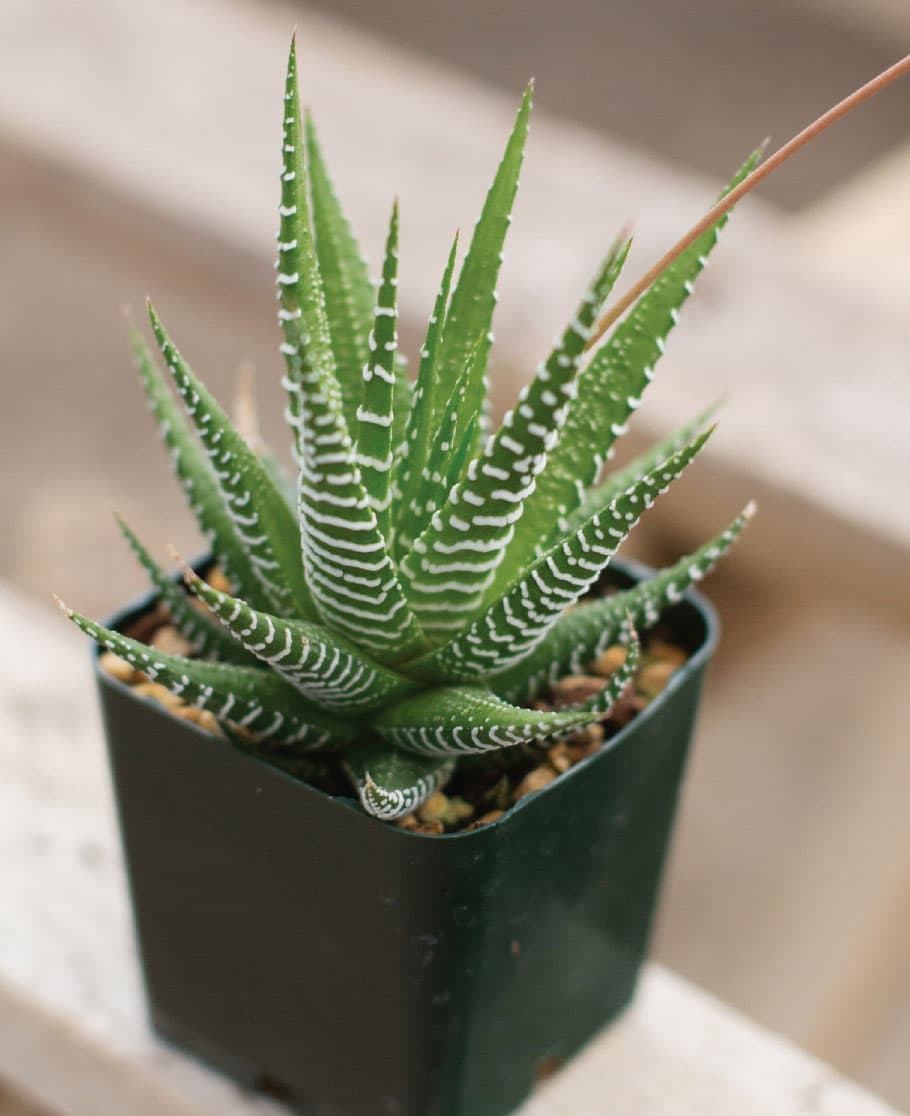
Haworthia retusa
STAR CACTUS
FAMILY: Asphodelaceae
ORIGIN: Cape Province, South Africa
CULTURE: Adapts to moderate sun or shade; needs well-draining porous soil and thorough watering, allowing the soil to dry before repeating. Reduce water in winter.
COLD HARDINESS: 25°F (–3.9°C)
PROPAGATION: By division, o ffsets, seed, or leaf cuttings
BLOOM TIME: Late spring to summer
Haworthia retusa is a popular succulent that forms shiny, green, star-shaped rosettes, and was introduced into cultivation at the beginning of the eighteenth century. The top surface of its smooth leaves house nearly translucent windows that illuminate the interior photosynthetic areas of the leaves—a particular curiosity for botanists. These are called “window leaves” and represent an acclimation to desert conditions. In its native habitat, the star cactus is often buried deep in the ground with only the window leaves visible. Haworthias make easy-care house plants and they can be interesting contributions to dry rock gardens as well.
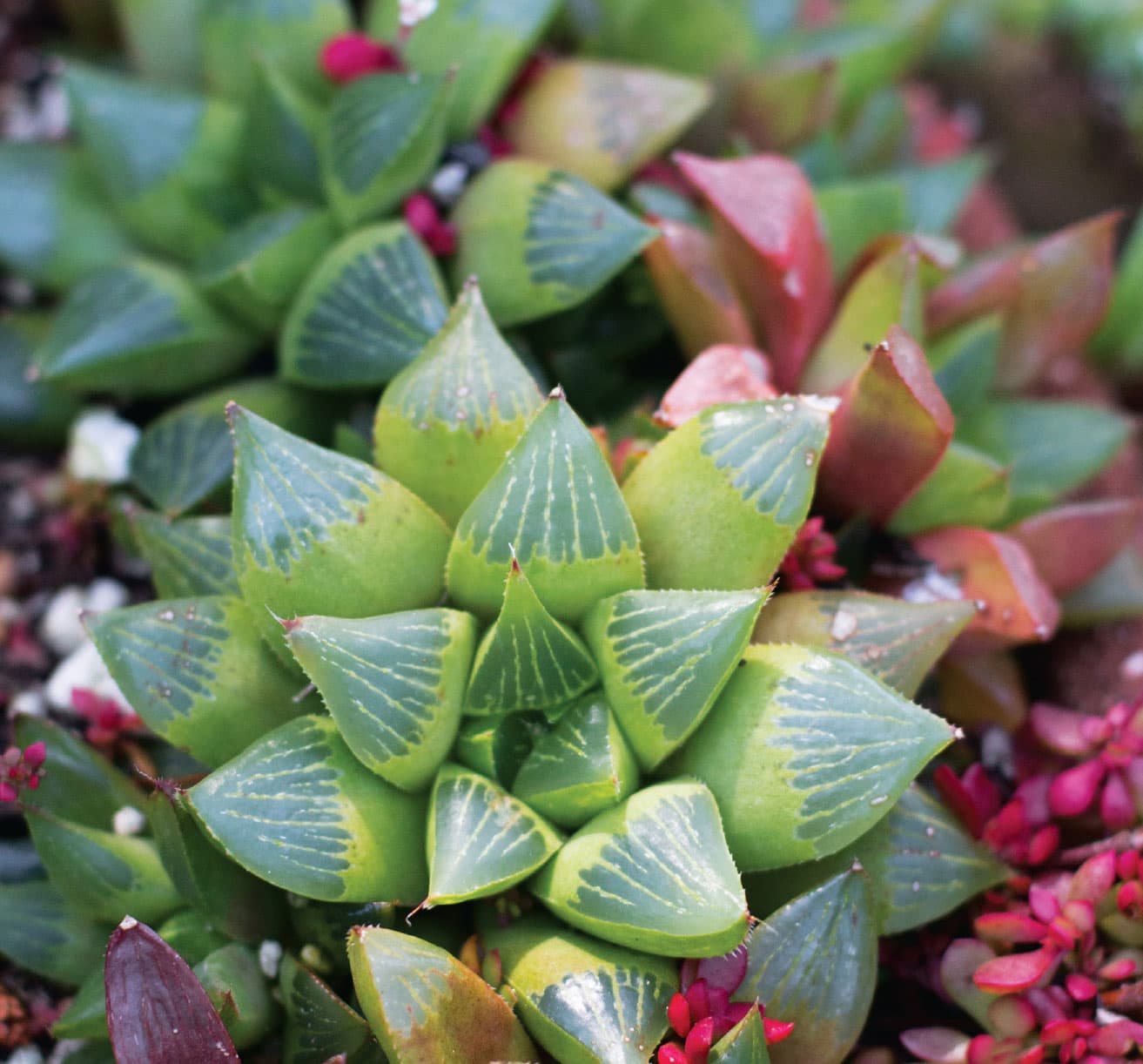
Haworthia truncata
HORSE’S TEETH
FAMILY: Asphodelaceae
ORIGIN: South Africa
CULTURE: Grows best in sandy/gritty soil and requires good drainage, as it is prone to root rot. Partial sun to shady conditions.
COLD HARDINESS: 32°F (0°C)
PROPAGATION: By division, offsets, seed, or leaf cuttings
BLOOM TIME: Fall to winter
As with many haworthias, horse’s teeth is one of the strange and wonderful oddities of the botanical world. It, too, has the phenomenon of “window leaves,” which allow a leaf buried in the soil to still receive the sunlight necessary for photosynthesis, transmitting it from the window through the clear, juicy inner tissue of the leaf to the green outer layer. Being hunkered down in the soil also offers the plant protection from desiccation and from browsing by animals. Under cultivation, this succulent tends to grow above soil, albeit quite slowly. This better displays the unusual leaf form that earns the plant the Afrikaans name of perderande, or horse’s teeth. Japanese breeders who often become obsessed with certain groups of plants have focused on developing a number of fascinating cultivars of H. truncate. This succulent is certainly one of the best for indoor culture.
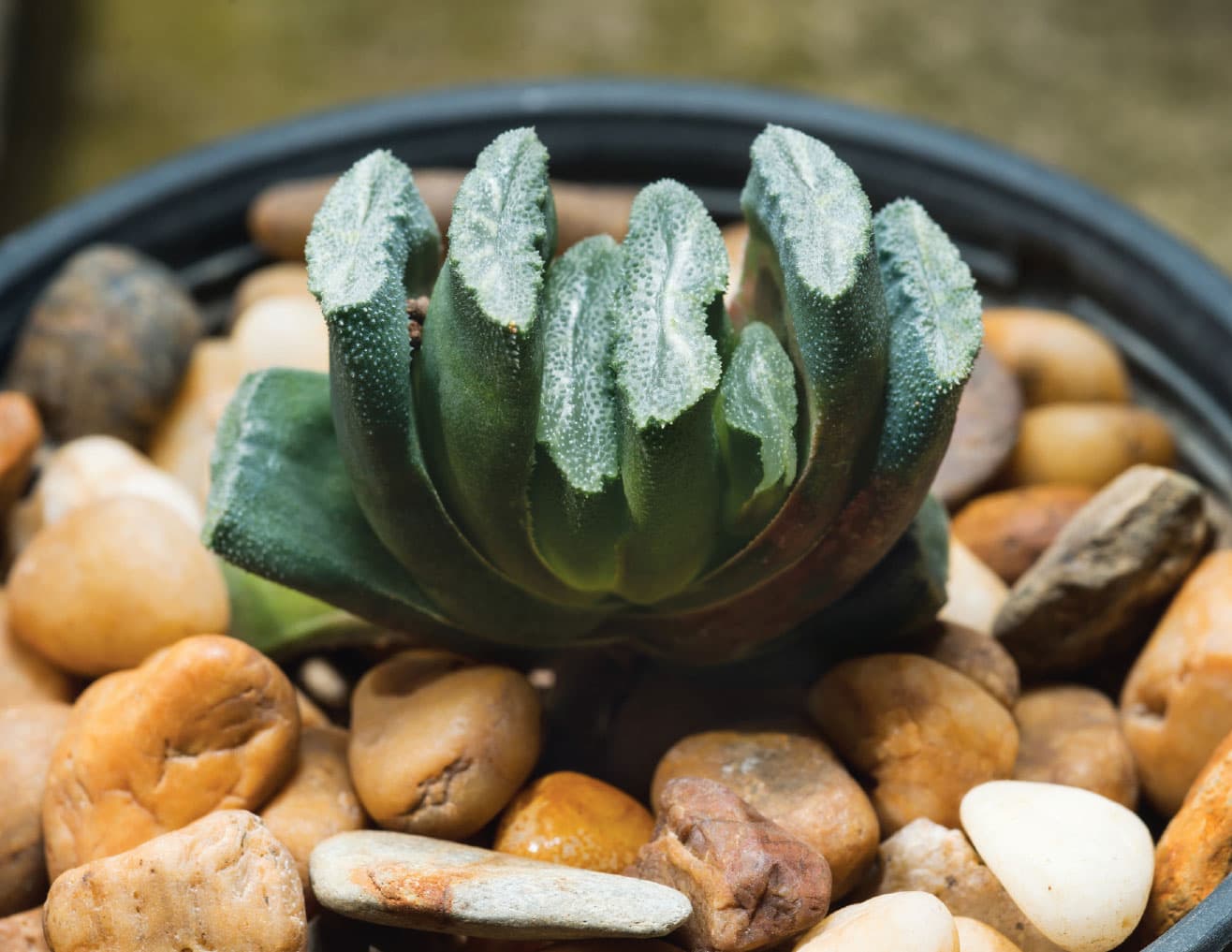
Hylocereus undatus
PITAYA, DRAGON FRUIT, NIGHT-BLOOMING CEREUS
FAMILY: Cactaceae
ORIGIN: Central America
CULTURE: Well-drained soil in full coastal sun, but protect in hot inland areas.
COLD HARDINESS: 32°F (0°C)
PROPAGATION: By seed or stem cuttings
BLOOM TIME: Late summer–early fall
Hylocereus undatus is one of the most rampant species in the cactus family. Its fleshy, three-angled, jointed stems sprawl up to 30' (9.1 m) over other plants and produce fibrous, aerial roots that cling to any available surface. In their natural habitat, support is provided by trees, shrubs, and rocks. The plant actually grows more like a tropical vine. From late spring into fall, the fragrant, large, white, bell-shaped flowers appear at dusk and last only for one night. In cold climates, all-night parties (for plant nerds, of course) are often held to behold the unfurling of the fragrantly exotic flowers. After the flowers are pollinated, they are followed with the large oval-shaped fruit that can weigh as much as 2 pounds (0.9 kg). Dragon fruit production is becoming popular worldwide in accommodating climates. Plant in a well-draining soil. Irrigate only a small amount (shallowly) but regularly in summer, including areas where aerial roots may be attached. This plant requires a near frost-free climate to produce fruits.
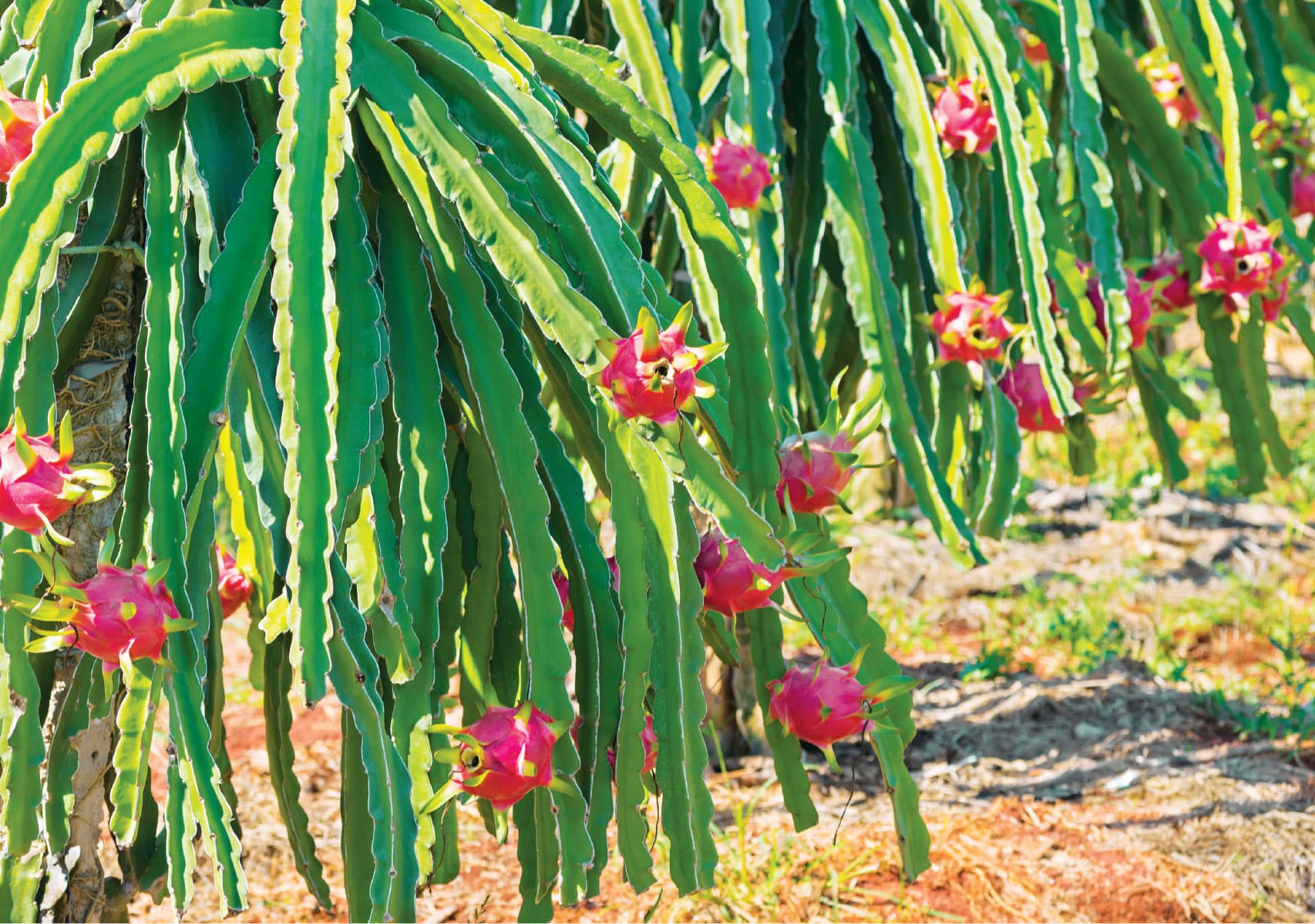
Kalanchoe ‘Houghton’s Hybrid’, ‘Pink Butterflies’
PINK BUTTERFLIES, PINK SPARKLER
FAMILY: Crassulaceae
ORIGIN: Madagascar
CULTURE: Bright, sunny locations, especially in the summer growing season. Indoors, during the winter, consider a south-facing window.
COLD HARDINESS: 35°F (1.7°C)
PROPAGATION: By leaf or stem cuttings
BLOOM TIME: Fall
“Incredibly beautiful” is not an exaggeration when describing this plant. Both parents of the original hybrid are viviparous, meaning they produce hundreds (seems like millions) of tiny plantlets on their leaves that readily fall and root with little to no effort. While this is an easy way to propagate, these plants can quickly become invasive and take over the garden. Kalanchoe ‘Pink Butterflies’ is an astonishingly colorful variegated sport of a cross known as ‘Houghton’s Hybrid’, a combination of K. daigremontiana × K. delagoensis. This was a fortuitous mutation for succulent lovers. Not only is ‘Pink Butterflies’ incredibly beautiful, but it is also not one bit invasive. It still produces abundant quantities of tiny pink butterfly-like plantlets on its leaves, but because they lack chlorophyll, they have lost their ability to grow from plantlets. The colors of the plantlets become more intense as the amount of sun they receive increases. Provide a porous soil with adequate drainage, water thoroughly when the soil is dry to the touch, and protect from frost.
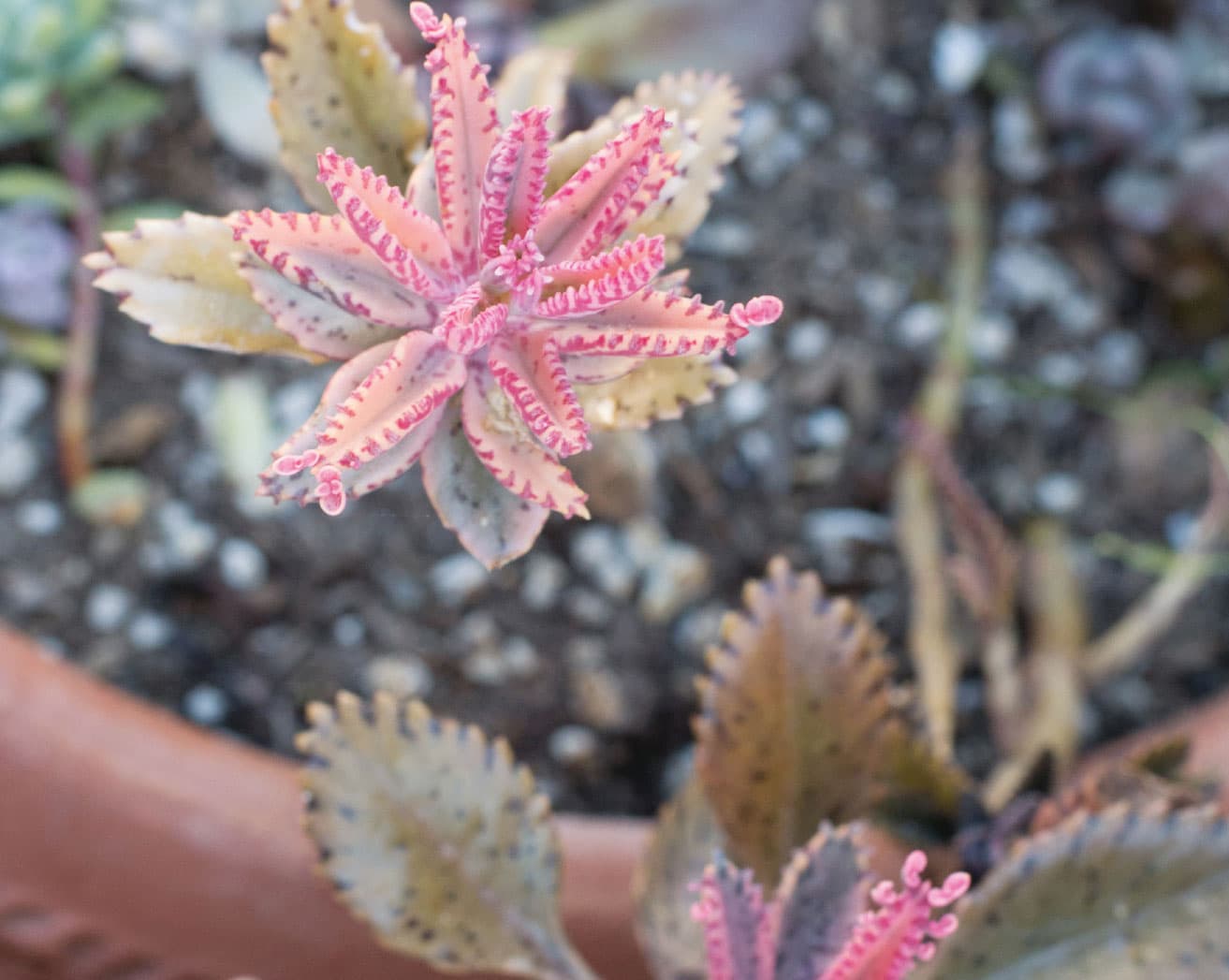
Kalanchoe Hybrid
‘BORDEAUX’
FAMILY: Crassulaceae
ORIGIN: Nursery-grown hybrid
CULTURE: Needs a porous, well-draining soil with full sun to light shade in the hottest inland locations. Water thoroughly and allow the soil to dry out somewhat before thoroughly watering again. Protect from frost.
COLD HARDINESS: 30° to 35°F (–1.1° to –1.7°C)
PROPAGATION: Cuttings
BLOOM TIME: Spring
‘Bordeaux’ has an easily branching, upright, compact habit that grows to about 1' (0.3 m) tall and wide. Relatively fast growing, it sports leaves with a distinctive toothed margin toward the leaf tip. These leaves are a rich green that is drenched in a deep burgundy-violet. In cooler temperatures, this coloring is noticeably intensified, creating an even more eye-catching display. Clusters of small bell-shaped flowers appear in spring. Unusually, the outer surface of the petals is often divided longitudinally into lobes of two colors, a shade of pink and a shade of apricot. This hybrid cultivar is another creation from Renee O’Connell of San Diego, California.
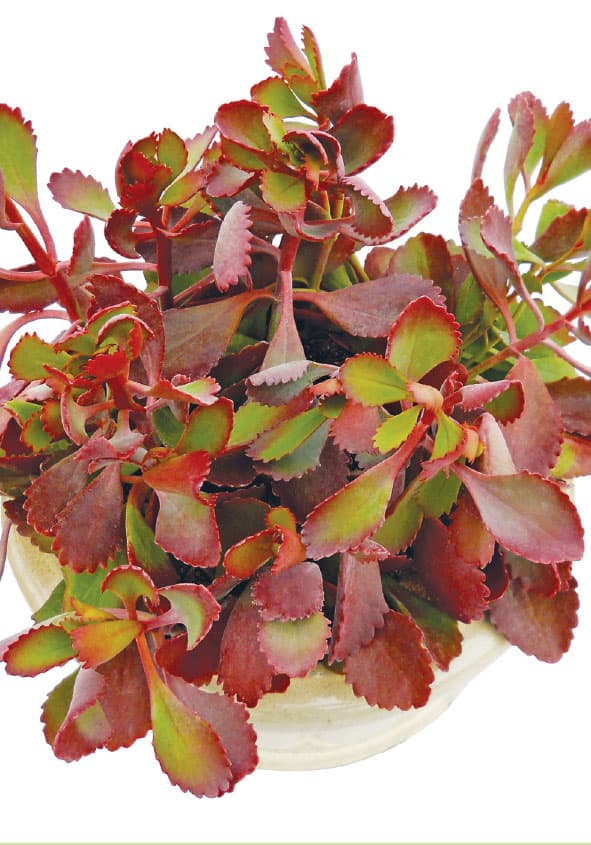
Kalanchoe luciae
FLAPJACKS, PADDLE PLANT
FAMILY: Crassulaceae
ORIGIN: South Africa
CULTURE: Plant in full sun to light shade.
COLD HARDINESS: 29°F (–1.7°C)
PROPAGATION: From leaf cuttings or cuttings of plantlets that form on the flowering stem
BLOOM TIME: Late winter to early spring
Whether or not this succulent evokes flapjacks or paddles, it is a desirable addition to any collection. The leaves are covered in a dusky gray, and the leaf margin takes on a reddish hue during cooler winter months. The red tones only appear if the plant is grown in bright light; otherwise, the leaves remain uniformly green. At blossom time (which occurs after three or four seasons), a single long stem, from 2' to 3' (0.6 m to 0.9 m), bearing clusters of pale yellow tubular flowers appears, after which the plant dies. The plant produces numerous offsets throughout its life, however, ensuring that there are always replacements. Be sure to protect them from snail and slug damage, which will cause permanent disfigurement.
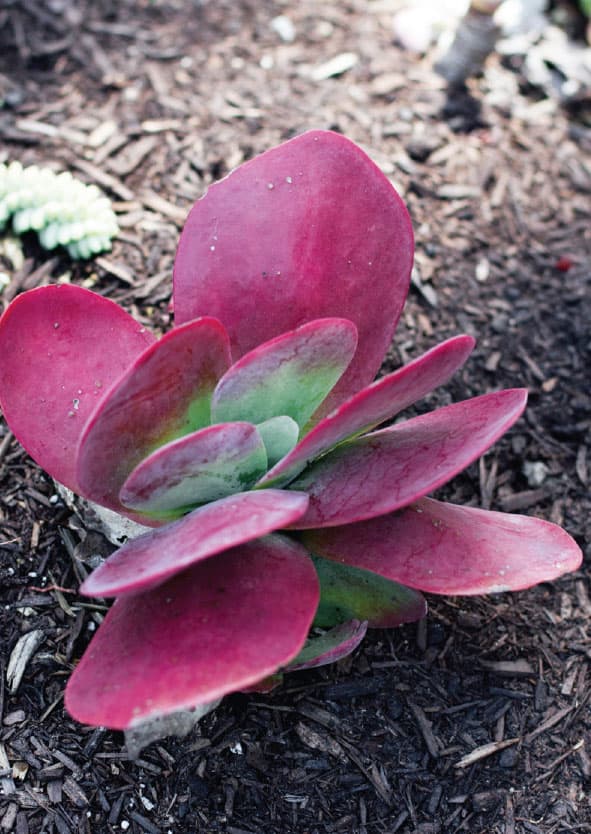
Kalanchoe tomentosa
PANDA PLANT, TEDDY BEAR PLANT
FAMILY: Crassulaceae
ORIGIN: Madagascar
CULTURE: Prefers a porous soil with adequate drainage. Water thoroughly when soil is dry to the touch. Protect from frost.
COLD HARDINESS: 29°F (–1.7°C)
PROPAGATION: Stem cuttings, leaf cuttings
BLOOM TIME: Spring
Panda plant is as adorable as its namesake. Its captivating, furry blue-gray leaves are covered in tiny white hairs with brown spots on the leaves’ edges. It’s a perfect plant to interest children in gardening—touching the leaves can be as irresistible as popping bubble wrap. The fuzziness of the leaves has a practical use in this plant’s natural habitat too. Because of its native arid environment, K. tomentosa must conserve what little water it can absorb from the soil. The dense mat of hairs growing from the leaves retards the movement of air directly across the leaf surface, which reduces water transpiration. In addition, the light silvery leaves reflect light, reducing the chances of the leaves overheating. ‘Chocolate Soldier’ is a common cultivar with leaves that are more red-brown around the edges and thinner and longer than the standard species. It also grows somewhat faster and has something of a clumping habit.
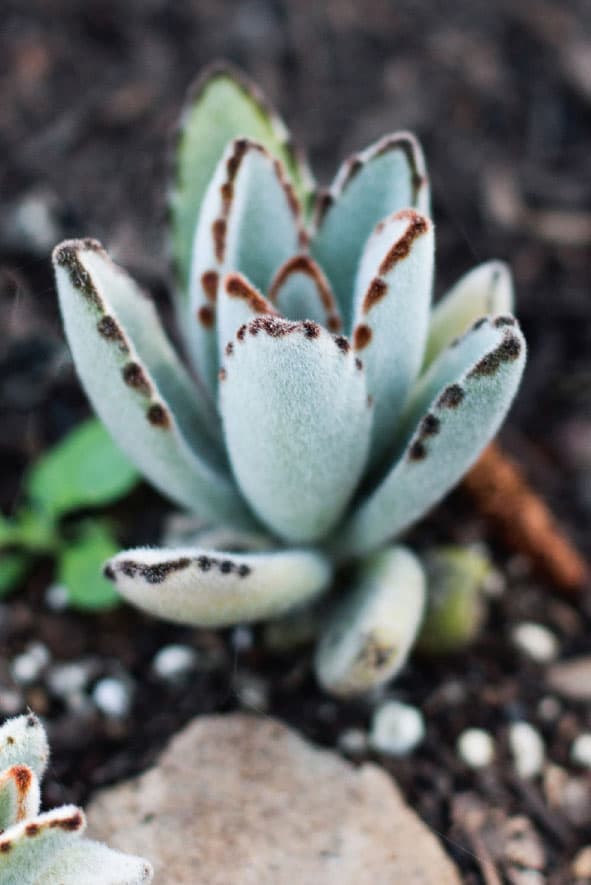
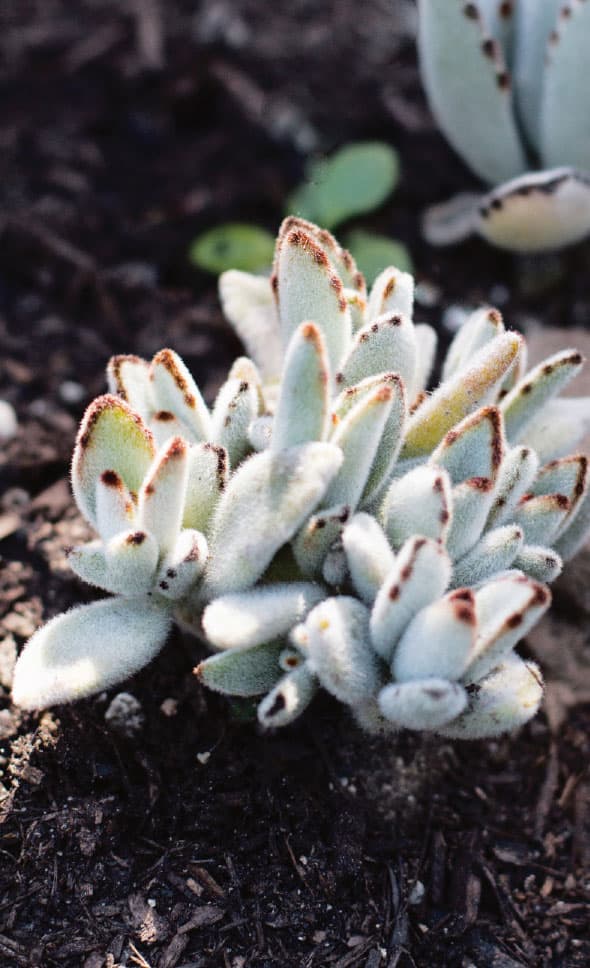
Leuchtenbergia principis
PRISM CACTUS, AGAVE CACTUS
FAMILY: Cactaceae
ORIGIN: North-Central Mexico
CULTURE: Has a strong taproot; grow in a deep pot. Lack of water will make the tips of the leaves yellow, but too much water will make it rot.
COLD HARDINESS: 30°F (–1.1°C)
PROPAGATION: Seeds
BLOOM TIME: Intermittent from spring to fall
A true cactus that bears an uncanny resemblance to an agave or aloe, this strange-looking plant is the only member of its genus. With long and sharply angled tubercles (swellings that look like the leaves) tipped with harmless papery spines, it is amazing that this is actually a cactus. Prism cactus is relatively slow growing, but can eventually grow up to 2' (0.6 m) tall, with a cylindrical stem that becomes bare and corky at the base as the plant ages. While bizarreness is the main attraction, the plant also has significant flowers. Large, funnel-shaped, fragrant yellow blooms are produced from the areole at the tip of the new tubercles on mature plants (at least four to five years old). Overall, the agave cactus is a reasonably easy plant to care for under the general regime for most other succulents. Sunlight, however, is extremely important to this plant’s healthy appearance—if it is grown exclusively indoors, it may never thrive. In cold climates, plants will benefit from positioning outside during the warmer months of spring through early fall.
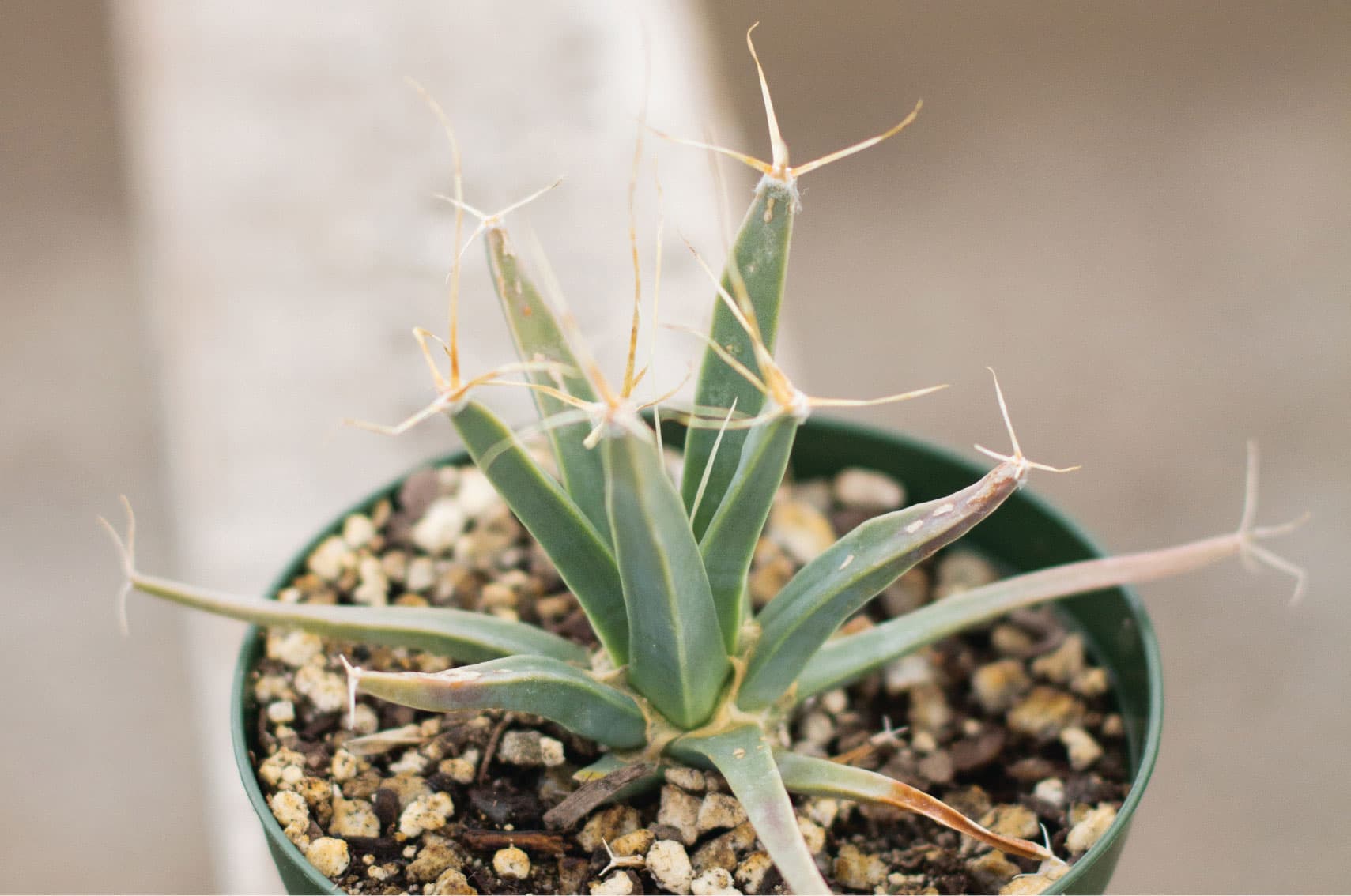
Lithops spp.
LIVING STONES
FAMILY: Aizoaceae
ORIGIN: South Africa
CULTURE: Coarse, well-drained substrate is a necessity. Water only in fall; the rest of the year, water only to keep plant from shriveling.
COLD HARDINESS: 40°F (4.4°C)
PROPAGATION: By seed
BLOOM TIME: Fall to winter
Widely known as living stones, lithops are some of the world’s most remarkable plants. The genus name derives from two Greek words that literally translate as “stone face,” and they avoid being eaten by animals with their ability to blend in with surrounding rocks. They even eluded Western discovery until 1811, when naturalist William John Burchell wrote of them, “On picking up from the stony ground what was supposed a curiously shaped pebble, it proved to be a plant.” Ever since, lithops have been avidly sought by collectors. With subtle colors of gray, brown, rust, green, and pink, and intricately designed markings, these plants become some of the most seductive members of the succulent family. Because the plants are so small, it’s easy to grow a collection on a sunny windowsill, a patio table, or even under grow lights. Flowers that dwarf the plants are produced in the fall; they should be allowed to go drier in winter, as these new growths draw water from the old leaves. Only provide sufficient moisture to keep the root hairs alive, or else they will die and the plant will be unable to absorb any water. When the new plant bodies are forming, the old leaves become soft and flimsy and begin to shrivel. Eventually, the old leaves dry up, leaving the plant with a perfect set of new ones.
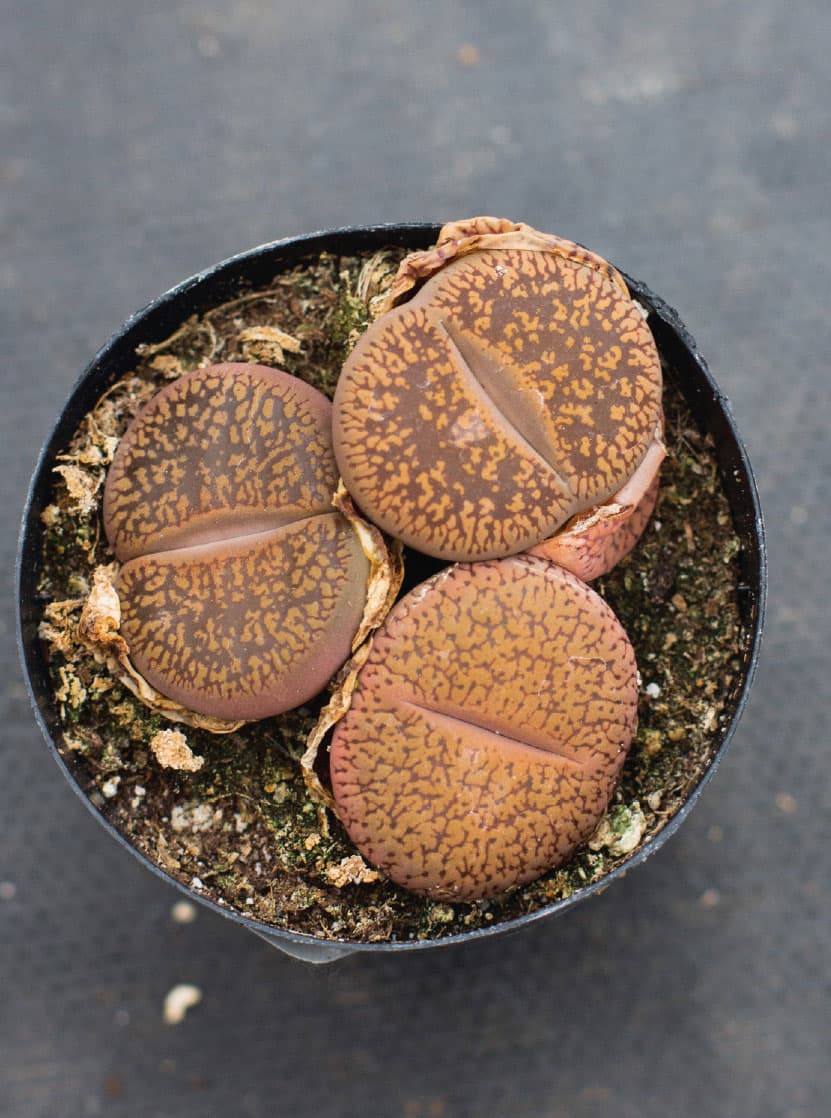
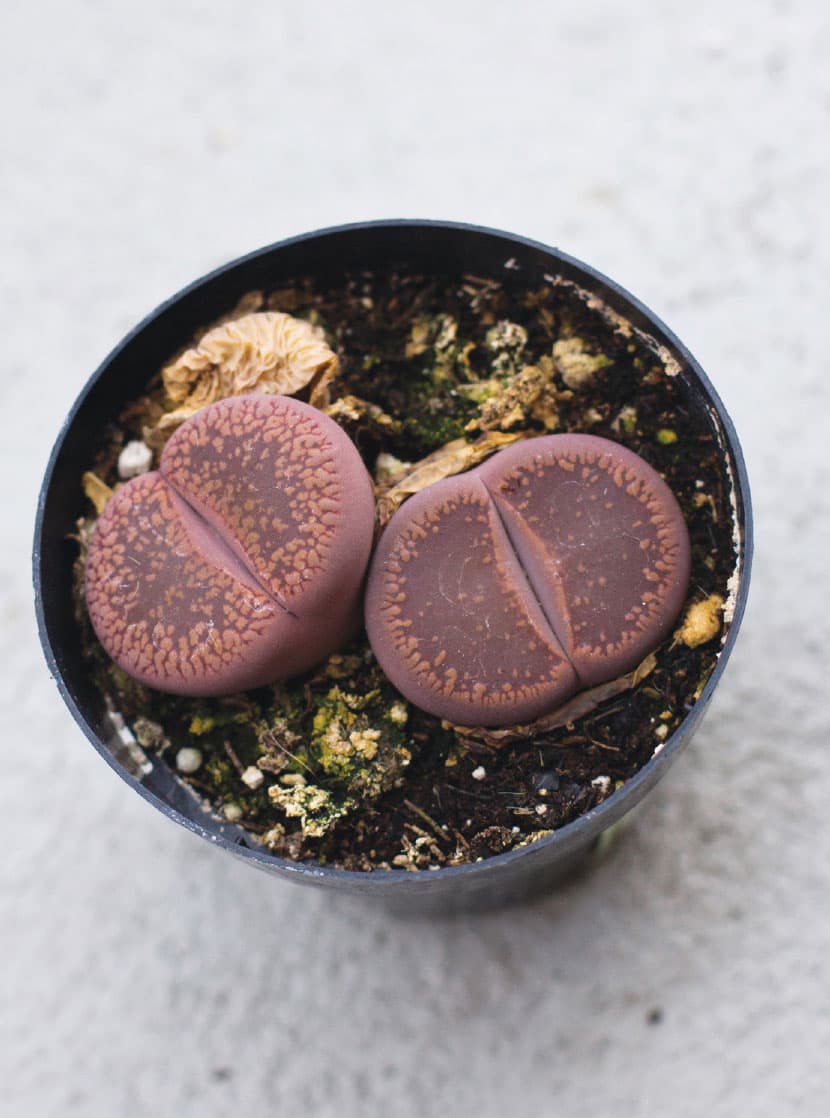
Mammillaria bocasana
SNOWBALL CACTUS, POWDERPUFF PINCUSHION CACTUS
FAMILY: Cactaceae
ORIGIN: North-Central Mexico around San Luis Potosí
CULTURE: Water regularly in summer if soil is fast-draining. In a container, use a pot with good drainage and a very porous potting medium. Keep dry in winter.
COLD HARDINESS: 15°F (–9.4°C)
PROPAGATION: By seed or offsets
BLOOM TIME: Spring to summer
Powderpuff pincushion cactus is a rather fast-growing and clumping plant that will quickly form large mounds. Its cotton ball–like appearance, coated with silky white hairs, inspired its common name. But don’t be fooled! The sharp spines are used to make fishhooks in Mexico. It is quite variable, with many different varieties and forms available in cultivation. This is often one of the first plants to enter the collection of a cactus lover because of its easy cultivation and free-flowering habit. It will survive temperatures well below freezing as long as the soil drains well.
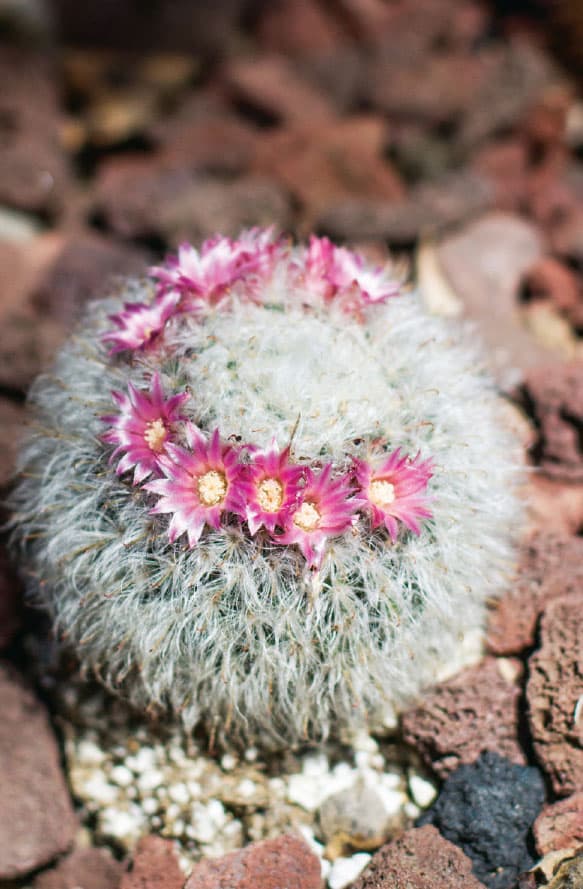
Mammillaria hahniana
OLD LADY CACTUS, BIRTHDAY CAKE CACTUS
FAMILY: Cactaceae
ORIGIN: Central Mexico
CULTURE: Easy to grow in porous cactus soil with adequate drainage. Bright light with ample airflow. Water thoroughly when the soil is dry to the touch.
COLD HARDINESS: 25°F (–3.9°C)
PROPAGATION: By seed or offsets
BLOOM TIME: Late spring to early summer
Most of the pincushion group of cactuses flower freely, and the birthday cake cactus is no exception. Cerise flowers are followed by upright red seedpods that stand in a ring around the crown of the cactus, producing the birthday experience. M. hahniana is native to Mexico and forms globular stems to 6" (15.2 cm) or more in diameter. The stems are densely covered with white hair and short white spines. The concentric rings of dark pink flowers create a dramatic contrast as they appear amid the white hairs. Although easily found in most garden shops, this species is on the IUCN Red List of near-endangered plants because of the deforestation threat to its habitat in Mexico.
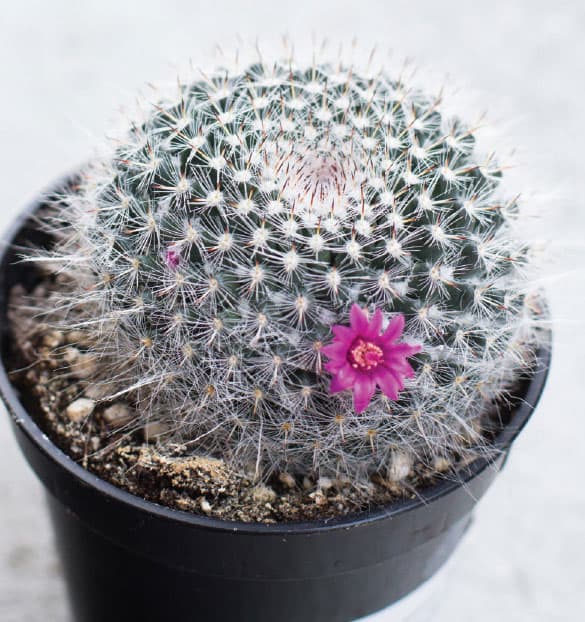
Mammillaria matudae cristata
CRESTED THUMB CACTUS
FAMILY: Cactaceae
ORIGIN: Mexico
CULTURE: Needs porous, well-drained soil with full to part sun. Water thoroughly, allowing the soil to dry out before watering again. Reduce watering through winter.
COLD HARDINESS: 25°F (–3.9°C)
PROPAGATION: By cuttings
BLOOM TIME: Spring
Cresting of a plant happens when the single, central growing point multiplies either through a natural mutation or because of mechanical damage, such as being eaten by an insect. When these points grow and multiply through natural cell division, they push against one another, forcing the plant’s tissues to back up and fanfold in an undulating pattern. This often results in the plant mimicking an appearance similar to the folds of a brain. The crested Mammillaria matudae forms thick, fanned folds with characteristic recurved spines that make it surprisingly “touchable” without injury. The spine color is quite variable, from near white to cinnamon, depending on the seedling. Crested forms can be reluctant to bloom, but they might have a spring flush of the typical species’ small magenta flowers.
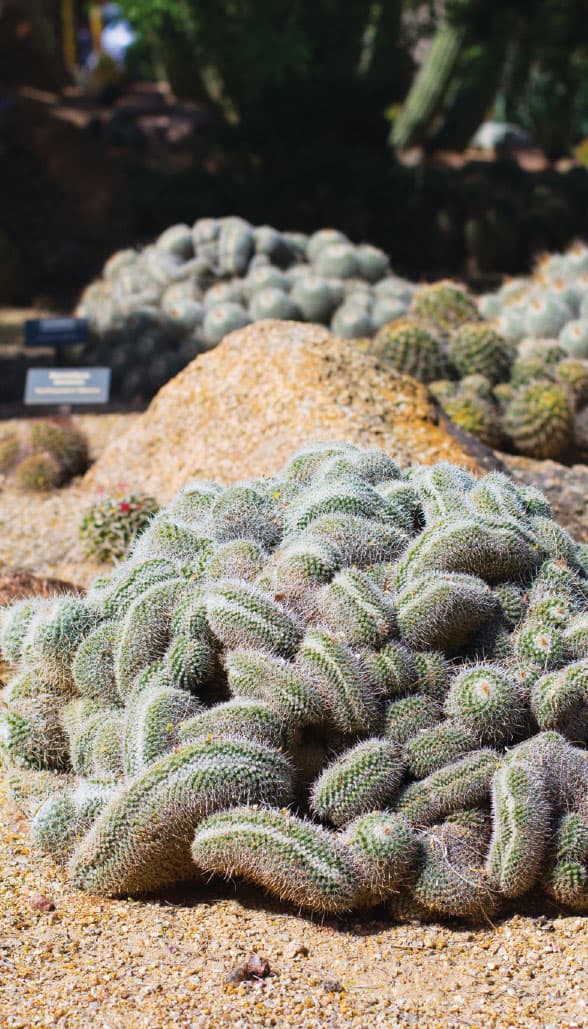
Opuntia cylindrica cristata
AUSTROCYLINDROPUNTIA CYLINDRICA CRISTATA, EMERALD IDOL
FAMILY: Cactaceae
ORIGIN: Ecuador, Peru
CULTURE: Needs porous, well-drained soil with full sun. Water thoroughly, allowing the soil to dry out before watering again. Reduce watering through winter.
COLD HARDINESS: 28°F (–2.2°C)
PROPAGATION: By cuttings
BLOOM TIME: Unlikely
Similar to other cactus oddities, the cresting of a plant happens when the single, central growing point of a plant multiplies either through a natural mutation or because of mechanical damage. When these points grow and multiply through natural cell division, they push against one another, forcing the plant’s tissues to back up and fanfold in an undulating habit. While the normal form is arborescent (tree-like) and up to 12' (3.7 m) tall, the crested form makes an interesting small potted specimen with emerald-green, deep folds and fans. It looks very much like a sea coral, is relatively spineless, and may produce small, succulent, vestigial leaves that are short lived.
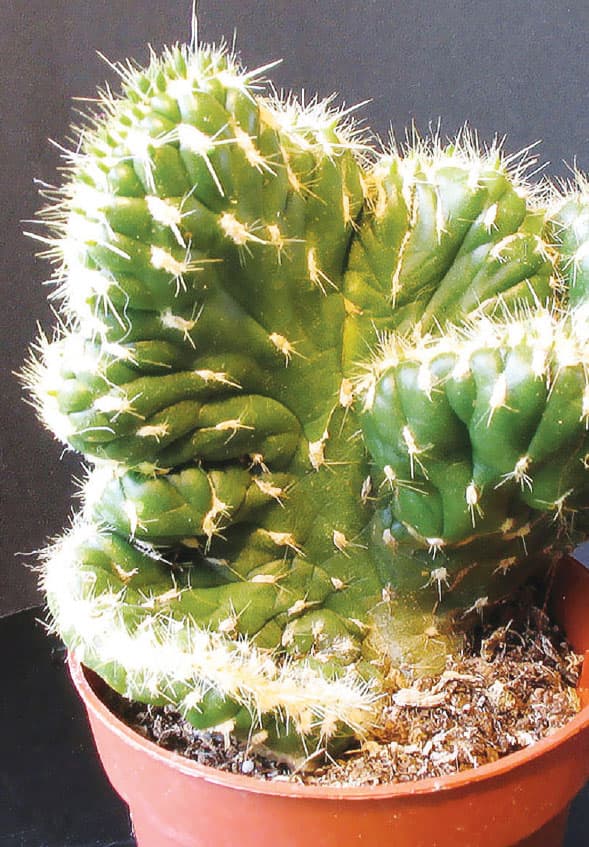
Opuntia microdasys
BUNNY EAR CACTUS, POLKA DOT CACTUS
FAMILY: Cactaceae
ORIGIN: Mexico
CULTURE: Needs porous, well-drained soil with full sun to very light shade. Water thoroughly, allowing the soil to dry out before watering again. Reduce watering through winter and protect from frost.
COLD HARDINESS: 30°F (–1.1°C)
PROPAGATION: By cuttings
BLOOM TIME: Summer
This is a very attractive beavertail or prickly pear–type of cactus that can be up to 2' (0.6 m) tall and spreads outward 3' to 4' (0.9 to 1.2 m) wide. Pale yellow flowers are followed by oval fruits that can be red to purple in color when ripe, but “buyer beware!” This cactus is not as harmless as its common name would suggest. Although it appears to be spineless and soft to the touch like a dotted swiss fabric, the golden dots on the pads are dense collections of glochids (tiny, highly irritating, loose spines) that easily stick into flesh like fiberglass and are also easily dislodged, becoming airborne and getting into eyes, nasal passages, and the mouth. They don’t hurt like a big stiff spine, but become a very irritating, lingering, and dangerous weapon. They can take a long time to be rid of if contracted. Sticky tape is often helpful in dislodging the microspines.
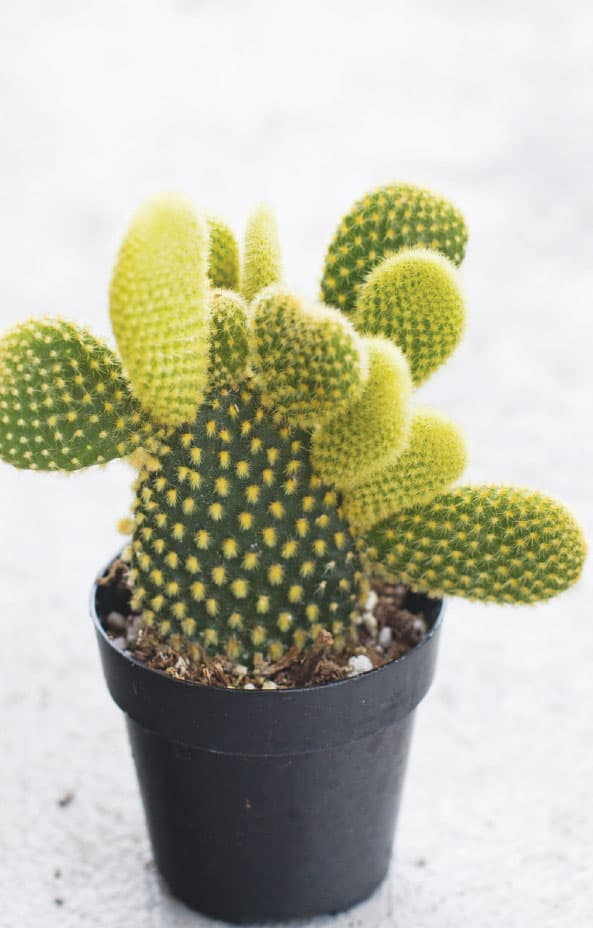
Opuntia quitensis
RED BUTTONS OPUNTIA
FAMILY: Cactaceae
ORIGIN: Ecuador, Peru
CULTURE: Needs porous, well-drained soil with full sun to very light shade. Water thoroughly, allowing the soil to dry out before watering again. Reduce watering through winter and protect from frost.
COLD HARDINESS: 30°F (–1.1°C)
PROPAGATION: By cuttings
BLOOM TIME: Summer
This is a charming, different kind of opuntia. Although it has the ability to grow tall, it is usually found as a squat, 12 to 18"(0.3 to 45.7 cm) sprawling plant growing several feet wide. The small pads, rather than being flat, are quite fat, almost inflated in appearance. Small red to orange-red flowers are produced singly at the tip of the uppermost pads. The spines are long but relatively sparse and scattered with no particular pattern.
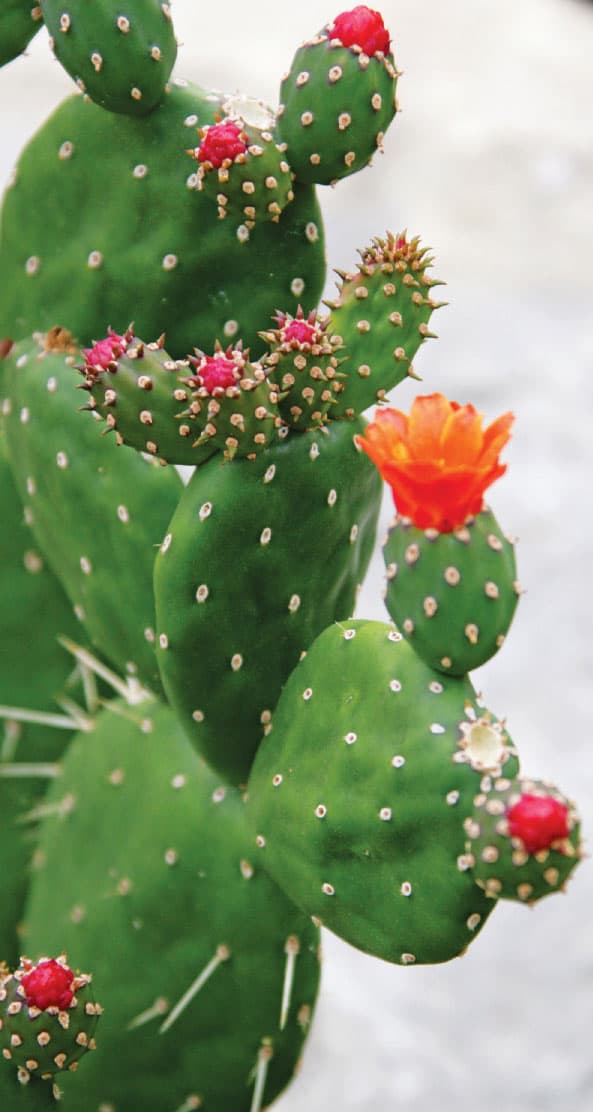
Opuntia subulata
AUSTROCYLINDROPUNTIA SUBULATA, EVE’S NEEDLE
FAMILY: Cactaceae
ORIGIN: Peru
CULTURE: Needs porous, well-drained soil with full sun. Water thoroughly, allowing the soil to dry out before watering again. Reduce watering through winter.
COLD HARDINESS: 20° to 25°F (–6.7 to –3.9°C)
PROPAGATION: By cuttings
BLOOM TIME: Summer
Not for the faint of heart! Here is a large, frequently branching, cylindrically stemmed cactus that can reach more than 10' (3.0 m) tall with a spread of more than 12' (3.7 m). It will form a large, dense thicket and is armed with extremely fierce, 2"- to 3"- (5.1 to 7.6 cm) long stiff yellow spines. In times of abundant water and especially on new growth, fleshy 1" to 2" (2.5 cm to 5.1 cm) cylindrical leaves form along the stems and copiously at the stem tips. These dry up and fall off as water becomes scarce. The flowers are an attractive red and a favorite of bees and hummingbirds. Because of its fast growth and heavily armed spines, this opuntia makes an excellent “security plant,” often used as a border fence or even planted under windows. It’s easily kept in control, as it takes well to pruning to shape.
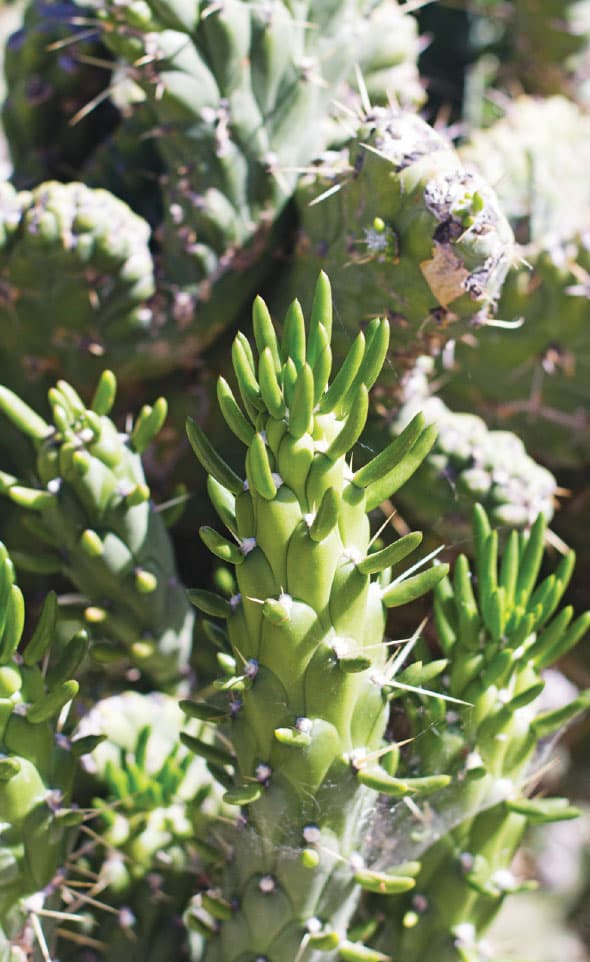
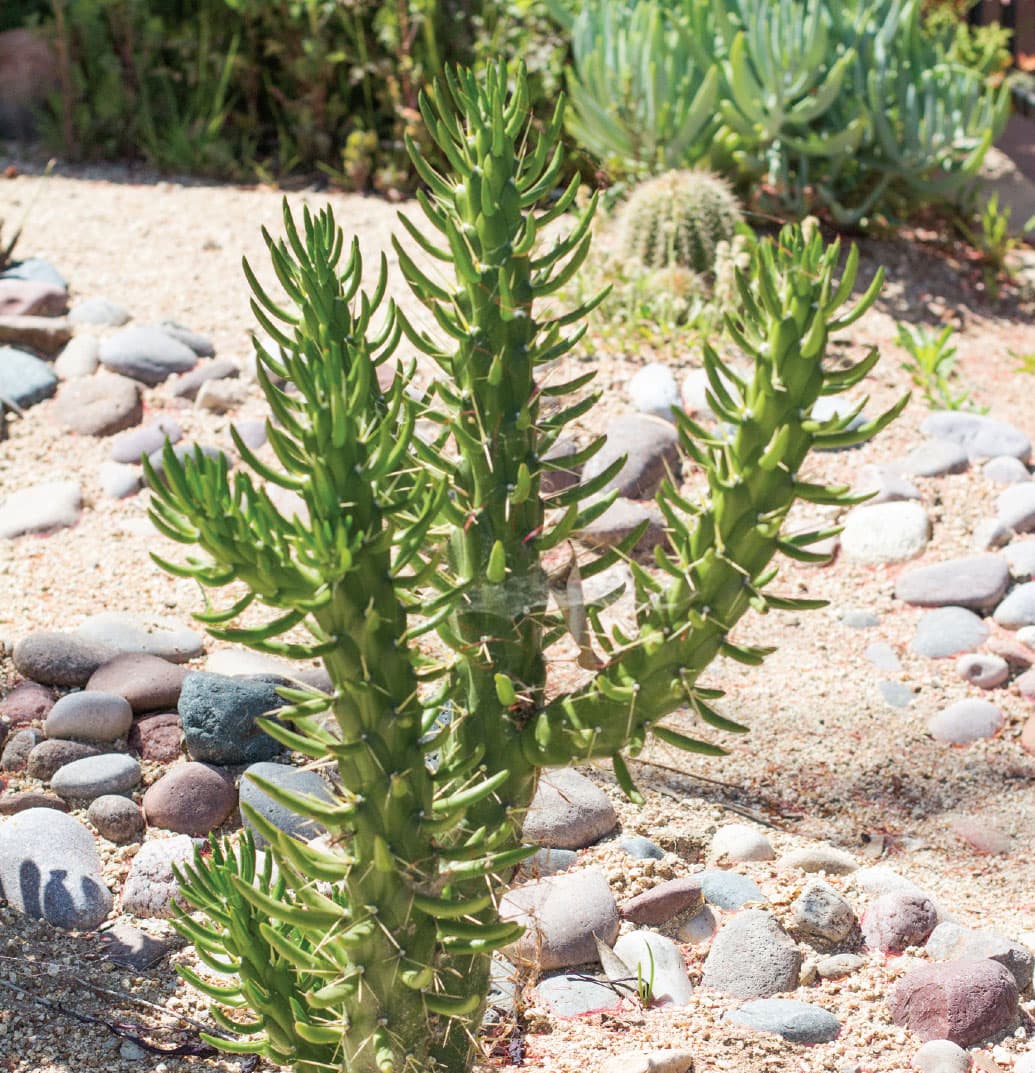
Opuntia chlorotica var. santa-rita
SANTA RITA PRICKLY PEAR, VIOLET PRICKLY PEAR
FAMILY: Cactaceae
ORIGIN: Arizona, northern Mexico
CULTURE: Needs porous, well-drained soil with full sun. Water thoroughly, allowing the soil to dry out before watering again. Looks best with supplemental water in the hottest months. Reduce watering through winter.
COLD HARDINESS: 25°F (–3.9°C)
PROPAGATION: By cuttings
BLOOM TIME: Late spring
Known for its rich purple color, the pads of this plant are at their best color when stressed due to extremes of heat, cold, or drought. The plant is very frost hardy, often surviving as far north as southern Virginia, where it is deer resistant. The pads lack long spines but are dotted with dense tufts of glochids (tiny, highly irritating spines) that easily stick into flesh like fiberglass. They don’t hurt like a big stiff spine, but become a very irritating, lingering problem and can take a long time to be rid of if contracted. Somewhat slow growing, the plant can reach 5' (1.5 m) tall and wide over time. Bright yellow flowers make a remarkable contrast to the violet-purple pads and are followed by edible purple fruits attractive to birds.
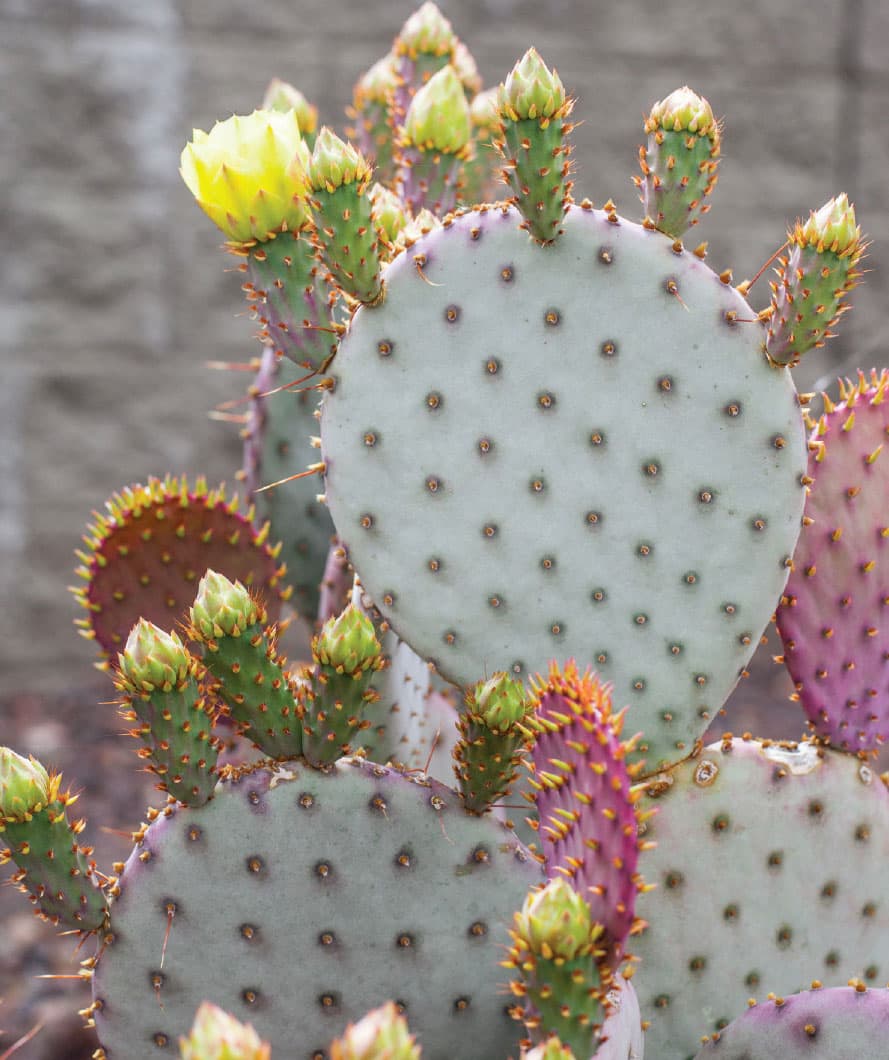
Oreocereus celsianus
OLD MAN OF THE ANDES
FAMILY: Cactaceae
ORIGIN: Andes of Argentina, Bolivia, Peru
CULTURE: Needs porous, well-drained soil with full sun. Water thoroughly, allowing the soil to dry out before watering again. Reduce watering through winter.
COLD HARDINESS: 10°F (–12.2°C)
PROPAGATION: By seed
BLOOM TIME: Spring
Popularly known as old man of the Andes, this “Cousin Itt”-–type cactus is from the higher altitudes of the Andes of South America. Known for the coat of fluffy white, coarse hairs that cover its entire length, this Oreocereus intrigues both children and adults. In its native habitat, the hairs help protect and shade the plant’s green skin from both intense high-altitude sunlight and the occasional cold snap. The main body of the cactus is well armed. The spines are stout, thick, and dirty yellow to reddish brown in color and occur in groups of one to four heavier spines surrounded by seven to nine very sharp radial spines. The spines are nestled deeply into the hairy cloak. At a mature age, this cactus produces flowers, but only at the top of the plant. Each rosy bud sits atop a thick, hairy stem about the size of a man’s little finger. Flowers face upward to receive hummingbirds and other insect pollinators.
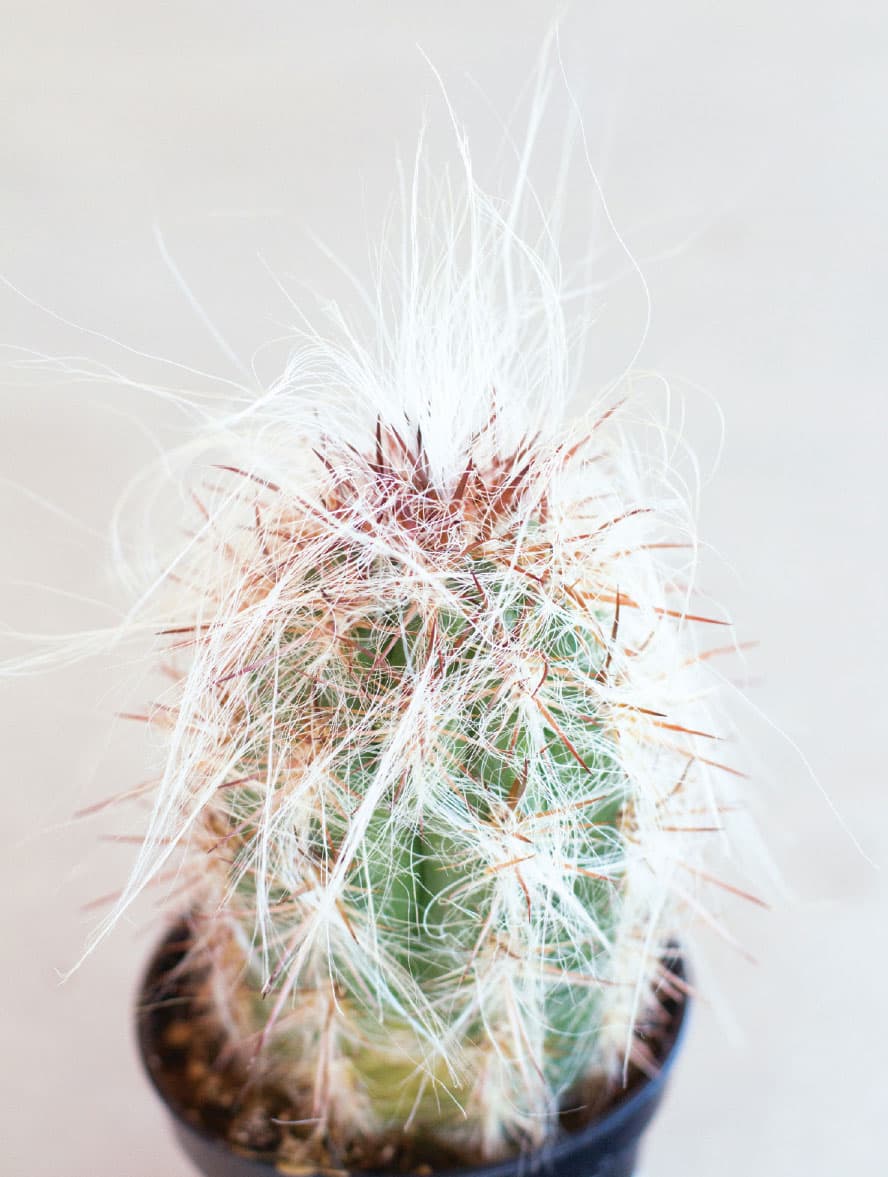
Pachycereus pringlei
CARDÓN, FALSE SAGUARO, ELEPHANT CACTUS
FAMILY: Cactaceae
ORIGIN: Baja California, and Baja California Sur, Mexico
CULTURE: Needs porous, well-drained soil with full sun. Water thoroughly, allowing the soil to dry out before watering again. Reduce watering through winter and protect from frost.
COLD HARDINESS: 28°F (–2.2°C)
PROPAGATION: By seed
BLOOM TIME: Spring to summer
Pachycereus is the colossus of the cactus family and is able to reach over 60' (18.3 m) tall! It is the Baja California equivalent of the giant saguaro, Carnegiea gigantea, of the Sonoran Desert region. Much faster growing than the saguaro, it will branch and put out “arms” at an earlier age than the saguaro, which can take up to 60 years to “branch out.” White, funnel-shaped flowers open midday and remain open during the night, when they are fertilized by bats, birds, and insects. The following fruits were eaten by indigenous cultures, but the flesh of this cactus contains alkaloids and may have been used as a psychoactive plant in Mexico, similar to other species in the genus. The fruit pulp and seeds are enjoyed by the local avian population.

Pachycereus schottii
SENITA
FAMILY: Cactaceae
ORIGIN: Southern Arizona and Sonora, Baja California, Mexico
CULTURE: Needs porous, well-drained soil with full sun. Water thoroughly, allowing the soil to dry out before watering again. Reduce watering through winter and protect from frost.
COLD HARDINESS: 35°F (1.7°C)
PROPAGATION: By seed, cuttings
BLOOM TIME: Summer
Senita is the rarest of Arizona’s three largest cactuses, after the giant saguaro (Carnegiea gigantea) and the organ pipe cactus (Stenocereus thurberi). Its scarceness is primarily due to its extreme sensitivity to frost—it will not tolerate it, thus restricting it to very specific locations. Branching from the base and growing to around 20' (6.1 m) tall, it can make hundreds of columns, creating large clumps. Dark, hairy tufts appear near the stem tops. Pink, nocturnal flowers with an unpleasant fragrance appear along the sides of the stems and are pollinated by a specific moth during the night. The variety ‘Monstrose’, known as the totem pole cactus, is a favorite of collectors and for use in frost-free landscapes. It is spineless, has lost its ribs, and develops random, smooth lumps and bumps.
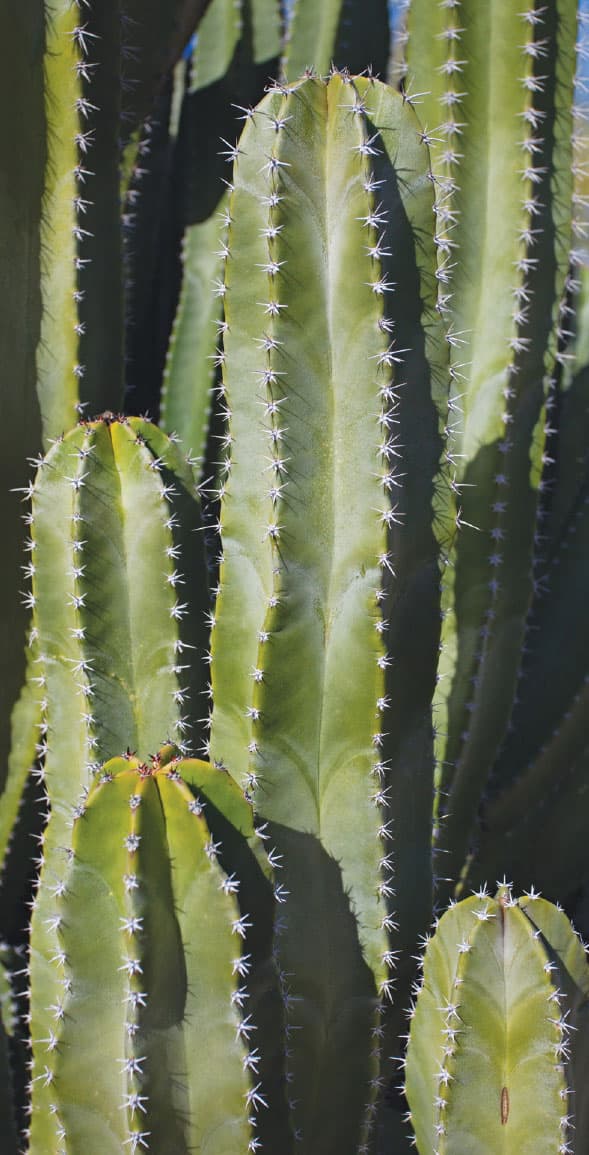

Pachypodium lamerei
MADAGASCAR PALM
FAMILY: Apocynaceae
ORIGIN: Madagascar
CULTURE: Needs porous, well-drained soil with full sun. Water thoroughly, allowing the soil to dry out before watering again. Reduce watering through winter and protect from frost.
COLD HARDINESS: 35°F (1.7°C)
PROPAGATION: By seed, division
BLOOM TIME: Spring to summer at maturity
As often occurs with common names, this not a palm at all. The Madagascar palm is easy to grow indoors as well as outdoors in frost-free climates. In their natural environment, pachypodiums grow under very hostile conditions. Most thrive in desert conditions and among rocks and gravel, which increase the heat they are exposed to via reflection. This is a popular caudiciform-type plant, meaning it has a swollen trunk that serves as a water reserve in times of drought. The entire trunk is heavily armed with spines in groups of three, and is topped with a crown of lance-shaped, dark green leaves. Only mature plants of some age will bloom, and being related to Plumeria, the blossoms are nearly identical in appearance—five petals, white with a yellow center, and pleasantly fragrant. Plants outdoors become deciduous, losing all their leaves when temperatures begin falling below 50°F (10°C). Keep winter watering to an absolute minimum, only maintaining the soil from drying out completely. Indoors, they make an excellent houseplant but need a full south- or west-facing window. Indoor plants are not likely to ever bloom.
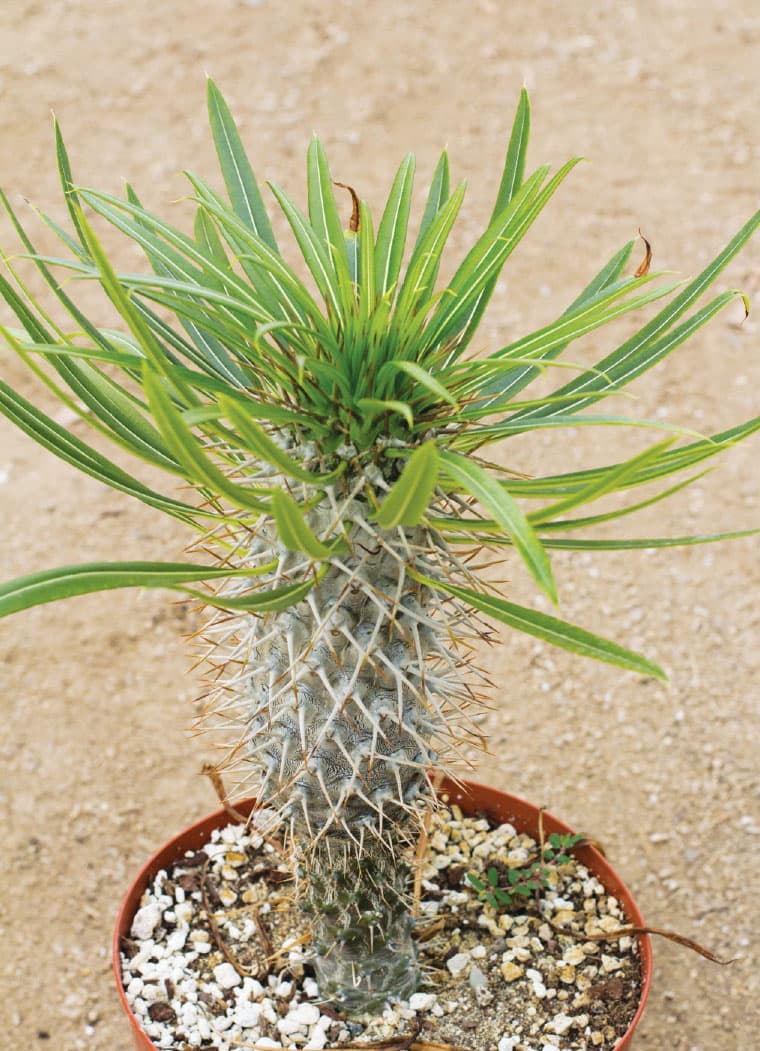
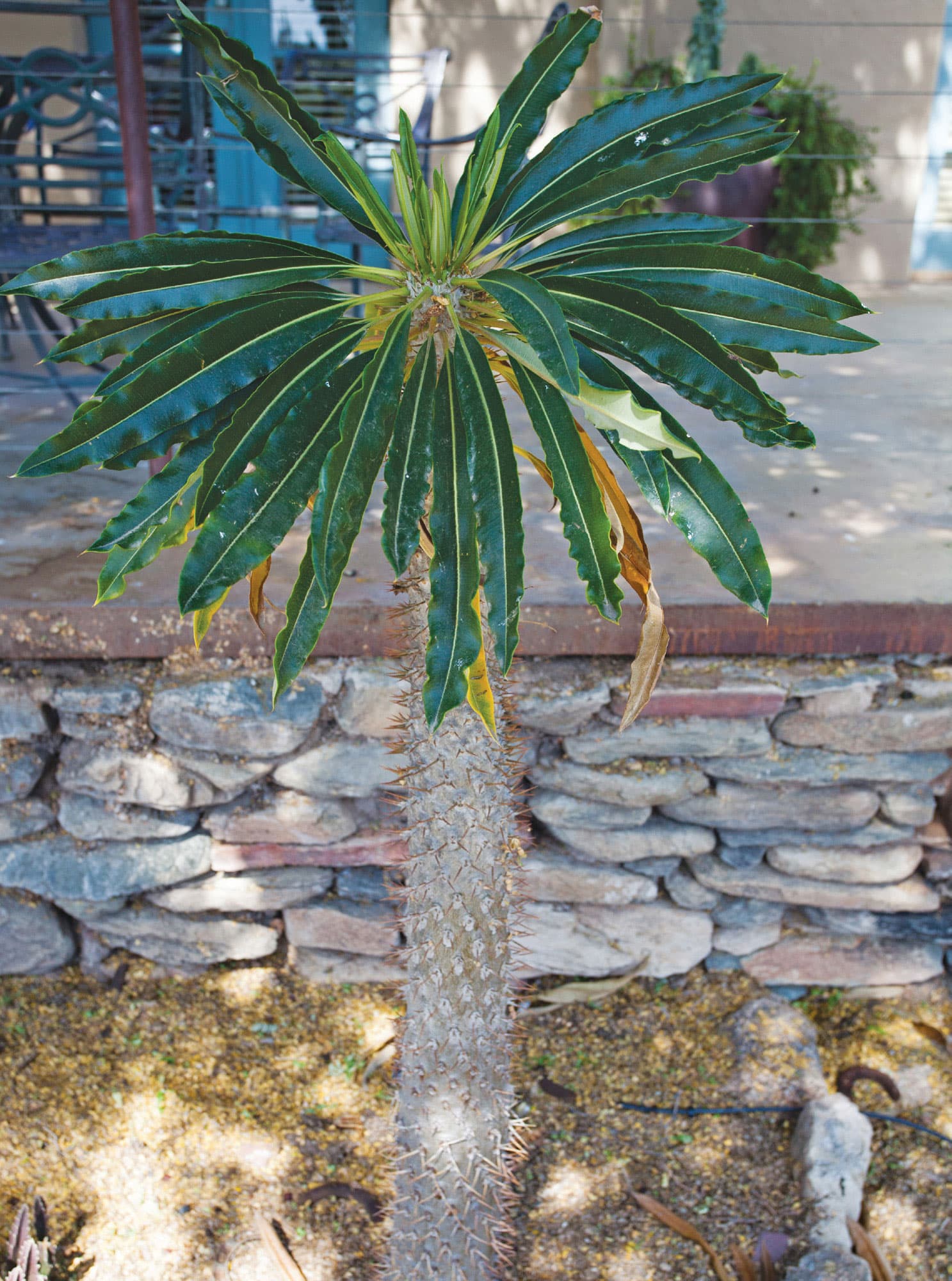
Parodia magnifica
BALLOON CACTUS
FAMILY: Cactaceae
ORIGIN: Southern Brazil
CULTURE: Needs porous, well-drained soil with full sun. Water thoroughly, allowing the soil to dry out before watering again. Reduce watering through winter.
COLD HARDINESS: 25°F (–3.9°C)
PROPAGATION: By seed
BLOOM TIME: Summer
Previously known as Notocactus magnificus, this is a beautifully geometric cactus. It is a blue-green globe with wool and golden spines along the vertical ribs, and it can be found growing singly or in large clustering mounds in time. Bright lemon-yellow flowers appear at the very top in summer. In its homeland, balloon cactus grows in hilly grasslands and on walls between cracks in the rocks or in the shade of larger growing plants. It grows in one of the most temperate regions of Brazil, with warm and cool seasons, and often temperatures will fall to just above freezing without harming the plants, because the locale is also very arid. The soil there is well drained and has a fairly high organic content. Water with caution in winter, as it can lose its roots if the soil stays cold and wet for extended periods.
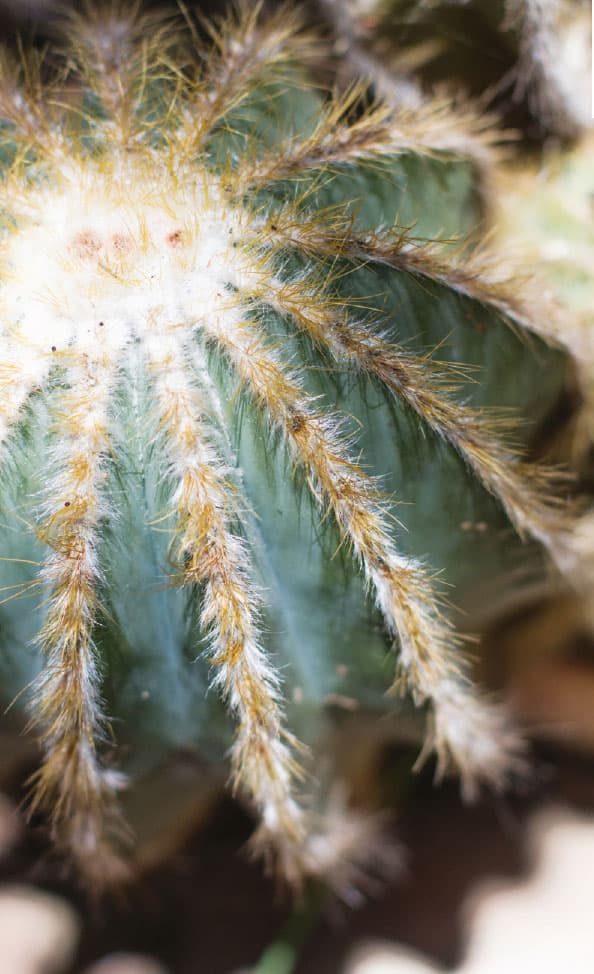
Peperomia graveolens
RUBY GLOW PEPEROMIA
FAMILY: Piperaceae
ORIGIN: Ecuador
CULTURE: Needs very porous soil with excellent drainage and very bright light to filtered sun. Water thoroughly when dry, but allow to dry somewhat inbetween. Protect from frost.
COLD HARDINESS: 35°F (1.7°C) PROPAGATION: By cuttings
BLOOM TIME: Summer
This plant is a high-altitude forest dweller and a favorite houseplant. The stems and undersides of the V-shaped leaves are a beautiful wine red, and the upper sides are green with a “window” in the top. The red coloration absorbs the reflected green light of the forest floor for photosynthesis, while the top green surface and the window take in the direct sunlight from above. When flowering, it will produce spikes held that are covered with microscopic cream or white flowers. They have an unpleasant odor, hence the name graveolens, which literally means “heavy-smelling” or, more appropriately, “rank.”
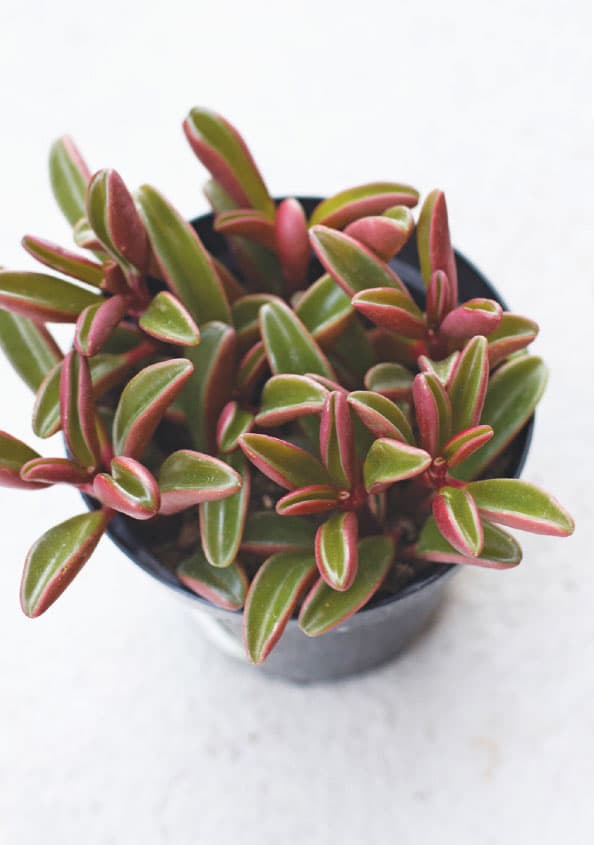
Pleiospilos nelii
SPLIT ROCK
FAMILY: Aizoaceae
ORIGIN: South Africa
CULTURE: Needs very porous soil with excellent drainage and full to part sun. Water thoroughly during the warmer months, allowing the soil to dry slightly before repeating. Reduce water in winter and protect from frost.
COLD HARDINESS: 25°F (–3.9°C)
PROPAGATION: By seed
BLOOM TIME: Spring
Being a member of the group of succulents known as “mimicry plants,” Pleiospilos nelii has evolved to imitate its surroundings by looking not unlike a rock or stone. The extremely succulent pair of grayish green leaves form a cleft egg shape, which can grow quite large, up to 4" (10.2 cm) in diameter. As a new pair of leaves emerges from the center, the two outer leaves deflate, putting their moisture back into the new growth. It has silky, golden-apricot flowers with white centers that are unusually large for the size of the plant. There is a purple-colored variety known as ‘Royal Flush’.
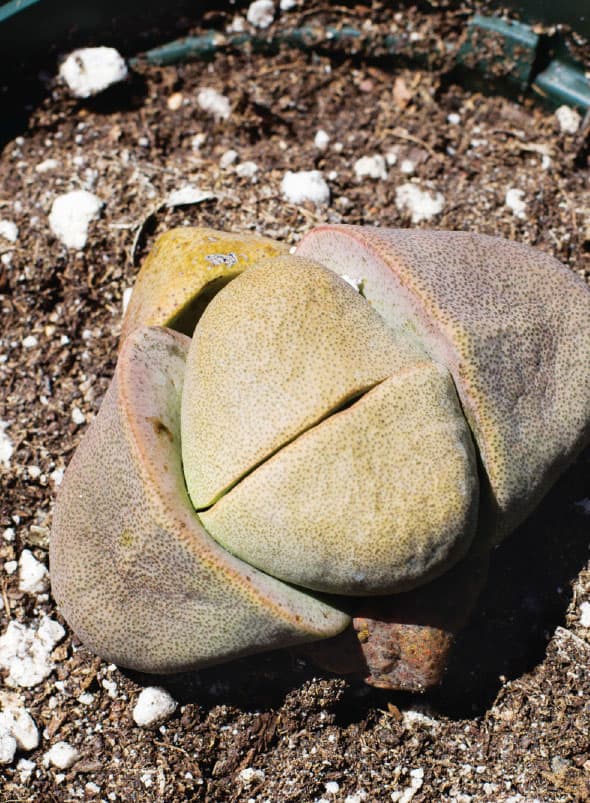
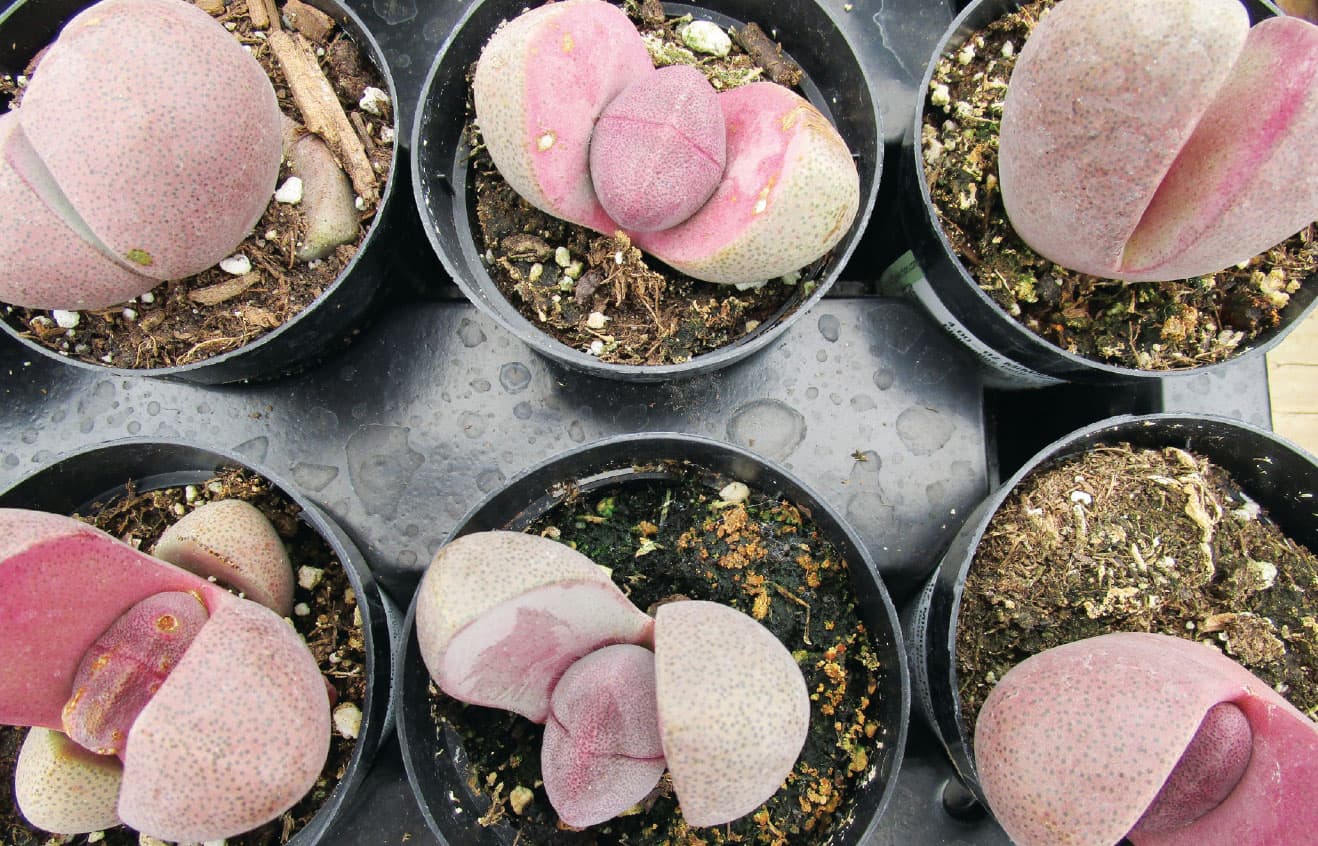
Plumeria rubra
PLUMERIA, FRANGIPANI
FAMILY: Apocynaceae
ORIGIN: Mexico, Central America, Colombia, Venezuela
CULTURE: Needs full sun with porous, well-draining soil. Water regularly spring to fall. Keep on the dry side in winter, watering only occasionally, and protect from frost.
COLD HARDINESS: 35°F (1.7°C)
PROPAGATION: By cuttings
BLOOM TIME: Summer to fall
The Central American heritage of Plumeria is nearly unknown, with its introduction to other tropical regions, such as Southeast Asia, India, Australia, and especially Tahiti and Hawaii, where its flowers are made into the ubiquitous floral lei. Plants grow as spreading shrubs to small trees 5' to 25' (1.5 m to 7.6 m) tall and wide. Leaves are large, dark green, and oval, ringing the tips of the succulent branches that display clusters of intoxicatingly fragrant five-petal flowers. White and yellow are typical flower colors but hybridizing with related species has now created many shades of pink, red, and even tricolored. As temperatures begin to cool in the fall, Plumeria go deciduous and dormant. They need very little water all winter until leafing out again in spring. A combination of cold and wet often leads to plants rotting during this time.
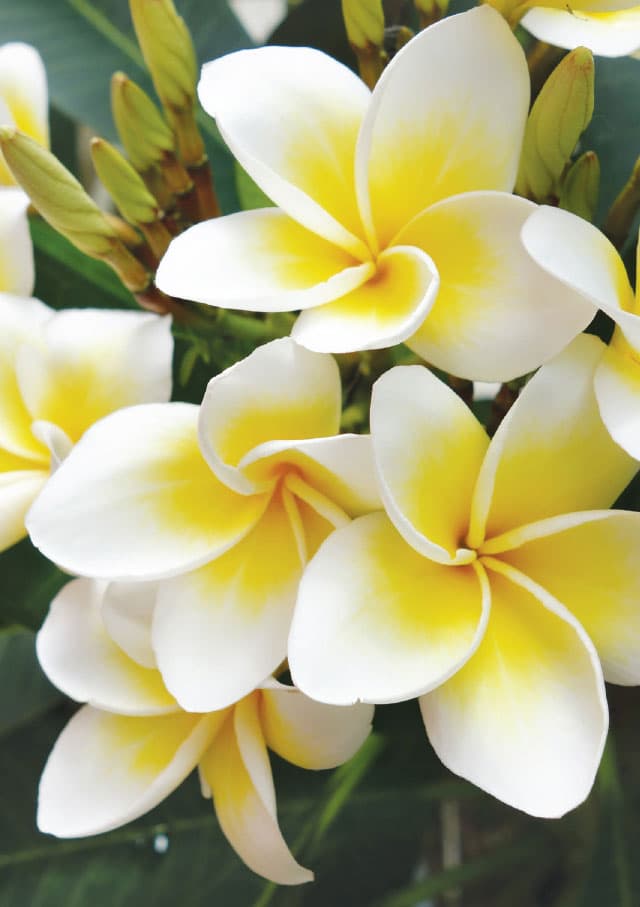
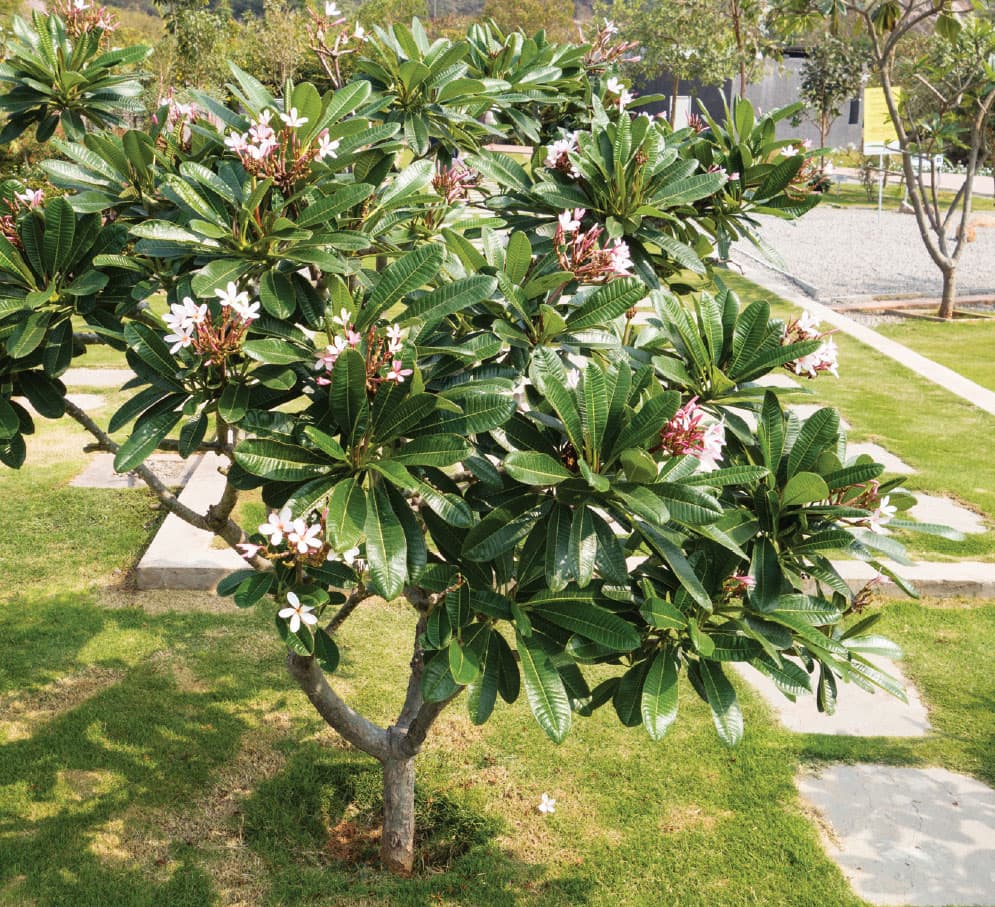
Portulacaria afra
ELEPHANT’S FOOD, ELEPHANT BUSH, SPEKBOOM
FAMILY: Portulacaceae
ORIGIN: Eastern Cape of South Africa, Mozambique
CULTURE: Needs full sun with porous, well-draining soil. Water regularly spring to fall, allowing the soil to dry between applications. Keep on the dry side in winter, watering only occasionally.
COLD HARDINESS: 25° to 30°F (–3.9° to –1.1°C)
PROPAGATION: By cuttings
BLOOM TIME: Summer
In its native habitat, Portulacaria afra forms large thickets known in the Afrikaans language as spekboomvelds. Elephants see these thickets of their favorite food as a buffet and it can provide up to 80 percent of their diet. A group of elephants can quickly strip all the leaves and smaller branches in a single feeding. Quick to bounce back, the plants will have regrown lush new greenery in as little as 2 weeks. Stocky 3" (7.6 cm)-diameter trunks support a framework of mahogany-colored lateral branches, with an overall mature height of 8' to 12' (2.4 to 3.7 m). Rounded, very succulent, emerald-green leaves are the perfect accent to the red-brown branches. In summer, small clusters of sweetly fragrant, tiny lilac to purple flowers are an unexpected surprise. In relatively frost-free locations, this is an excellent landscape plant for containers and patios or for use as a privacy screen. It has also become a favorite succulent for bonsai treatment.
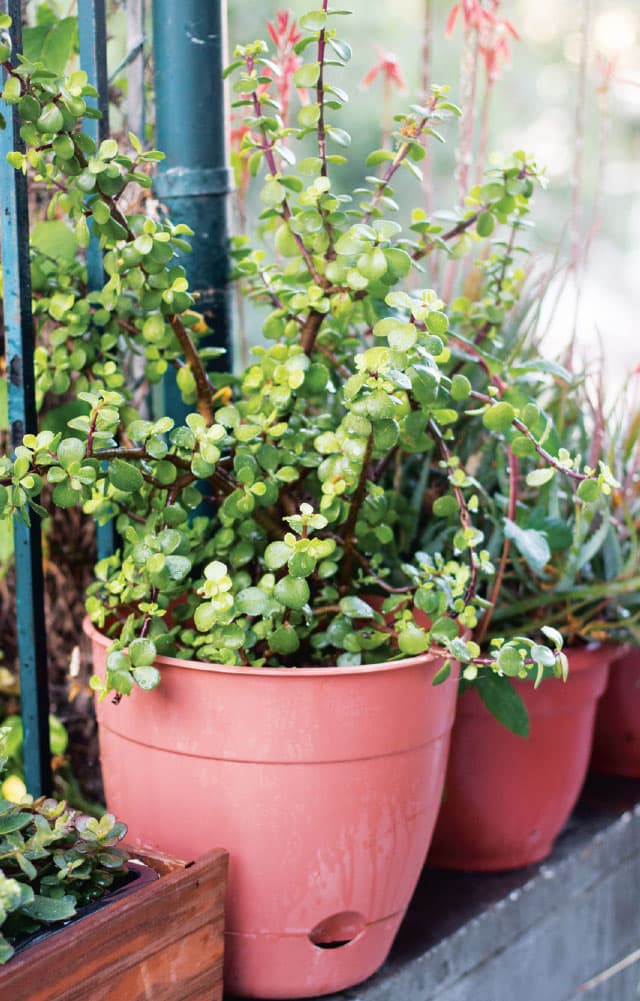
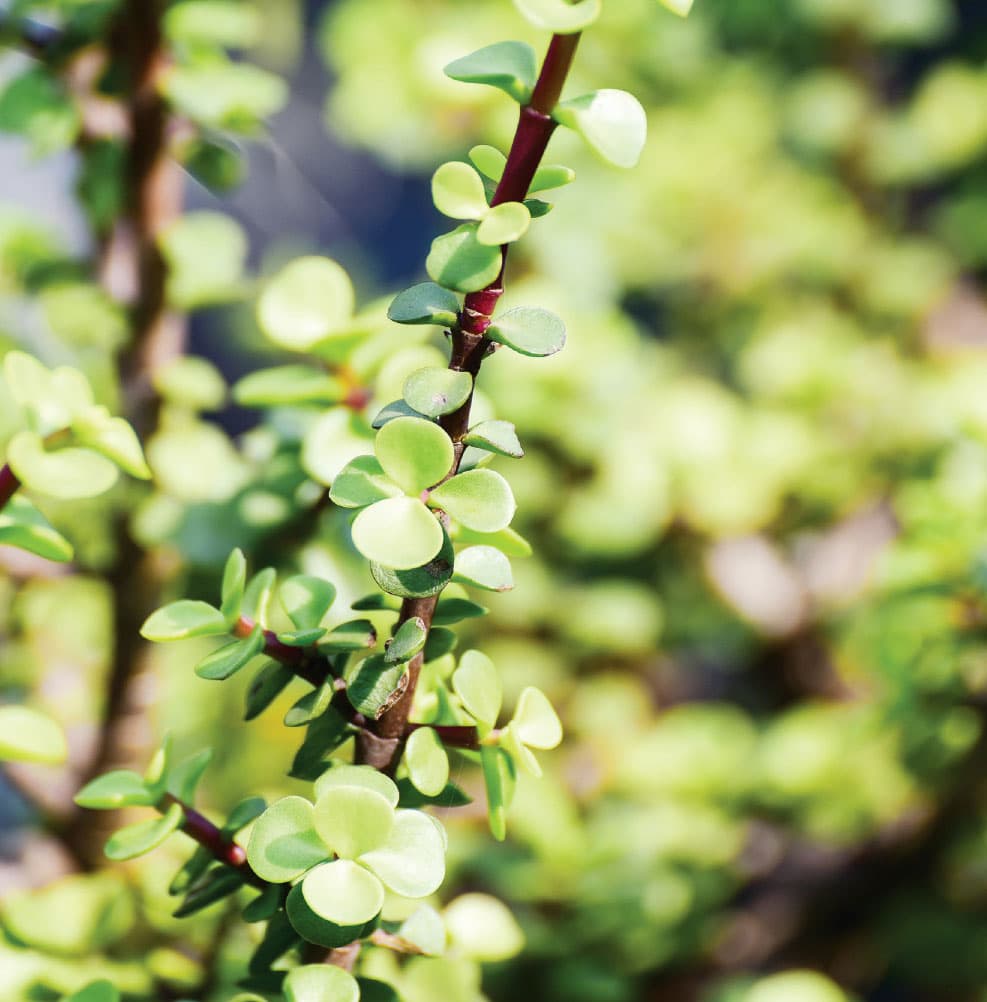
Sansevieria trifasciata ‘Laurentii’
SNAKE PLANT, MOTHER-IN-LAW’S TONGUE, BOWSTRING HEMP
FAMILY: Asparagaceae
ORIGIN: Tropical West Africa
CULTURE: Needs very porous, well-draining soil with bright light to filtered sun. Water thoroughly, allowing soil to dry out before watering again, and protect from frost.
COLD HARDINESS: 35°F (1.7°C)
PROPAGATION: By division, leaf cuttings
BLOOM TIME: Summer to fall
One of the common names, bowstring hemp, most likely is from the USDA’s attempt to grow the species as a fiber replacement for cannabis in the early part of the last century. This tropical plant forms clumps of erect, sword-shaped, deep green leaves with pale green transverse bands. The small, tubular, pale green flowers are on a stiff spike and have a pleasant fragrance. They often go unnoticed, being hidden among the taller clumps of upright leaves. This is an excellent indoor houseplant with lower light requirements compared to most succulent plants. Do not allow the plant to sit in water, as this may lead to root rot.
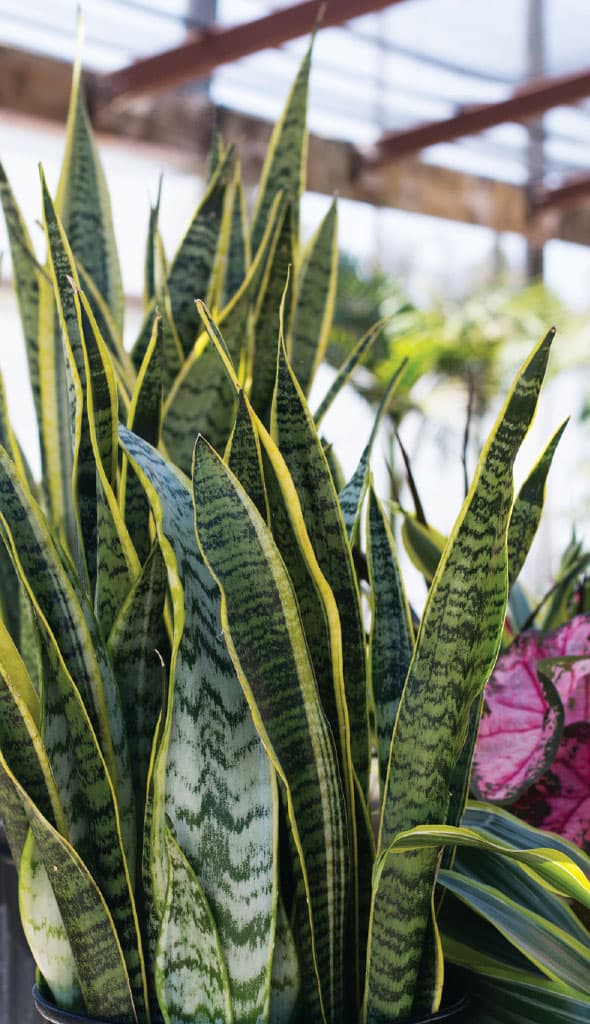
Sedum morganianum ‘Burrito’
BURRO’S TAIL
FAMILY: Crassulaceae
ORIGIN: Mexico, Honduras
CULTURE: Needs very porous, well-draining soil with very bright light to filtered sun. Water thoroughly, allowing soil to almost dry out before watering again, and protect from frost.
COLD HARDINESS: 35°F (1.7°C)
PROPAGATION: By cuttings, leaves
BLOOM TIME: Rarely
This grows well outside (in frost-free areas) or indoors in very bright light or filtered sun but not extreme heat. It does well with moderate watering all year, except in winter, when it should be infrequently watered. Excess water can damage the plant in a short time. The leaf structure is fragile and will readily break off the stem when manipulated. The leaves will stay alive for many days and roots will emerge after a few days. Protect from frost. ‘Burrito’ (which means “little burro”) is a select cultivar of the regular species Morganianum and has smaller, shorter, and fatter leaves compared to the usual burro’s tail.
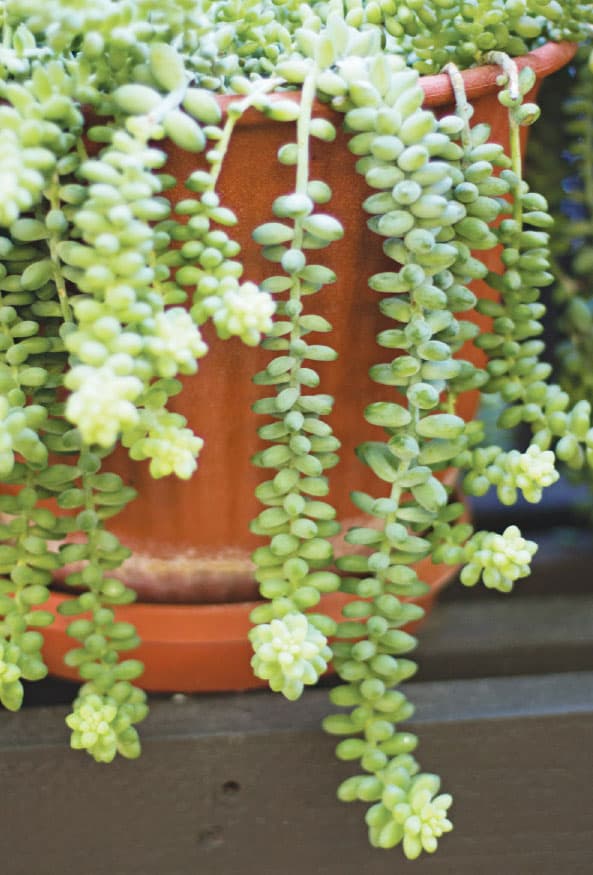
Sedum praealtum
BUSH SEDUM, BUSH STONECROP
FAMILY: Crassulaceae
ORIGIN: Mexico
CULTURE: Needs loose, well-draining soil and full sun. Water thoroughly, allowing the soil to dry slightly before watering again. Enjoys supplemental water in the hottest months but requires little to none in winter.
COLD HARDINESS: 20°F (–6.7°C)
PROPAGATION: By cuttings, leaves
BLOOM TIME: Spring
This is an unusual sedum in that, unlike most all others, it grows as a small sub-shrub rather than a creeping groundcover. Freely branching, the tangle of sturdy stems provide support to one another, allowing it to grow as an upright mounded shrub to 3' (0.9 m) tall and wide with time. The leaves form bright green, loose rosettes at the stem ends, looking similar to an Aeonium. In the landscape, it can be used in street medians and other locations where a low-growing, low-maintenance, drought-resistant plant is needed. Masses of bright yellow, star-shaped flowers cover the plant in spring.
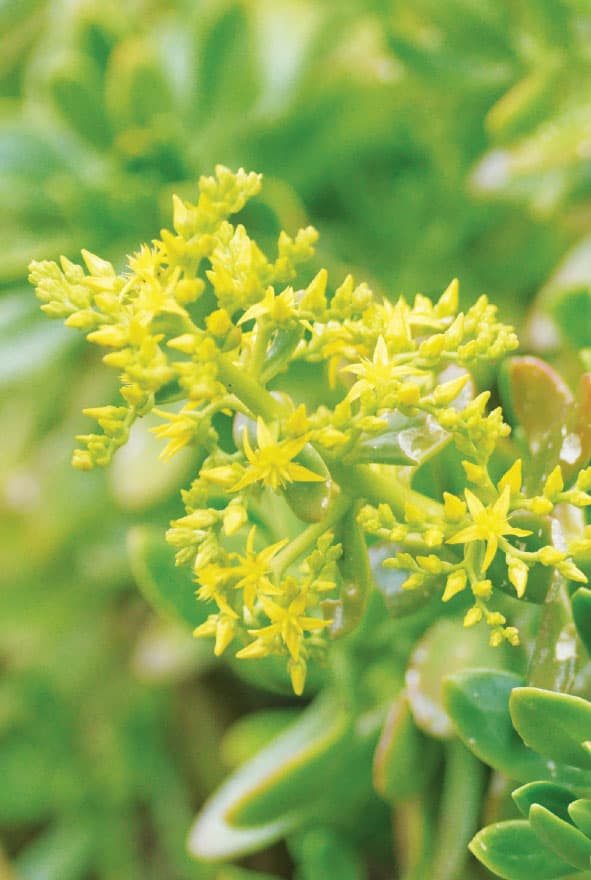
Sedum rubrotinctum
PORK AND BEANS, CHRISTMAS CHEER STONECROP, JELLY BEANS
FAMILY: Crassulaceae
ORIGIN: Mexico
CULTURE: Needs loose, well-draining soil and full sun to light shade. Water thoroughly, allowing the soil to dry slightly before watering again. Enjoys supplemental water in the hottest months but requires little to none in winter.
COLD HARDINESS: 25°F (–3.9°C)
PROPAGATION: By cuttings, leaves
BLOOM TIME: Summer
This is a familiar succulent classic that works well as a small area groundcover and certainly as a filler in rock gardens. The slowly trailing stems reach 8" to 10" (20.3 to 25.4 cm) long and are covered with gleaming green jelly bean leaves tipped in cherry-red. Don’t be tempted by the candy-like appeal, though. Sedum rubrotinctum is not edible and may cause irritation when ingested or touched. Stress from excess sun, heat, cold, or drought intensifies the color. Too little sun and the stems grow long and stretched, losing their compact look and signature color and becoming just an unremarkable green. S. rubrotinctum variegata ‘Aurora’ is a beautiful cultivar that is a pale whitish green infused with light pink and darker pink tips.
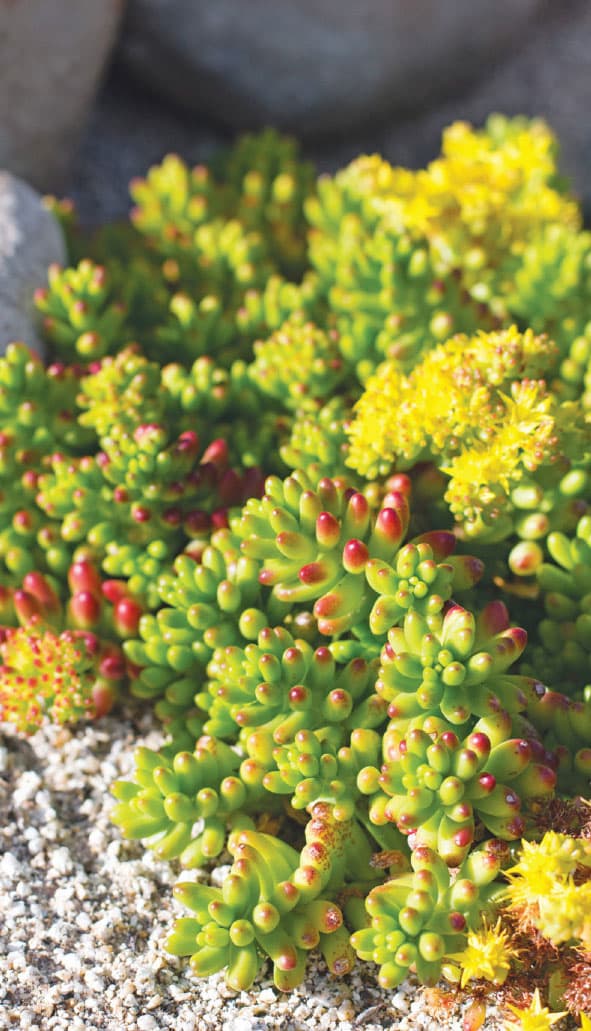
Sedum rupestre ‘Angelina’
‘ANGELINA’ STONECROP
FAMILY: Crassulaceae
ORIGIN: Europe
CULTURE: Needs full sun, well-draining porous soil, and thorough watering, allowing the soil to dry before repeating. Reduce water in winter.
COLD HARDINESS: 35°F (1.7°C)
PROPAGATION: By cuttings, leaves
BLOOM TIME: Summer
The type species (particular species on which the description of a genus is based), Sedum rupestre, is plain green. The cultivar ‘Angelina’ was found as a sport growing in a private garden in Croatia and named in honor of the owner. Unlike the species, it is a bright yellow, especially when grown in full sun; with stress in fall as temperatures begin to drop, it takes on a very attractive orange blush. This is a very tough stonecrop with extreme cold hardiness and drought tolerance. It does look better with occasional watering in the hottest months and locations. Rapidly growing, it makes a suitable small area groundcover and can be used as a trailing, cascading plant in hanging baskets and containers. Lower light conditions will cause it to lose its brilliance and become primarily green.
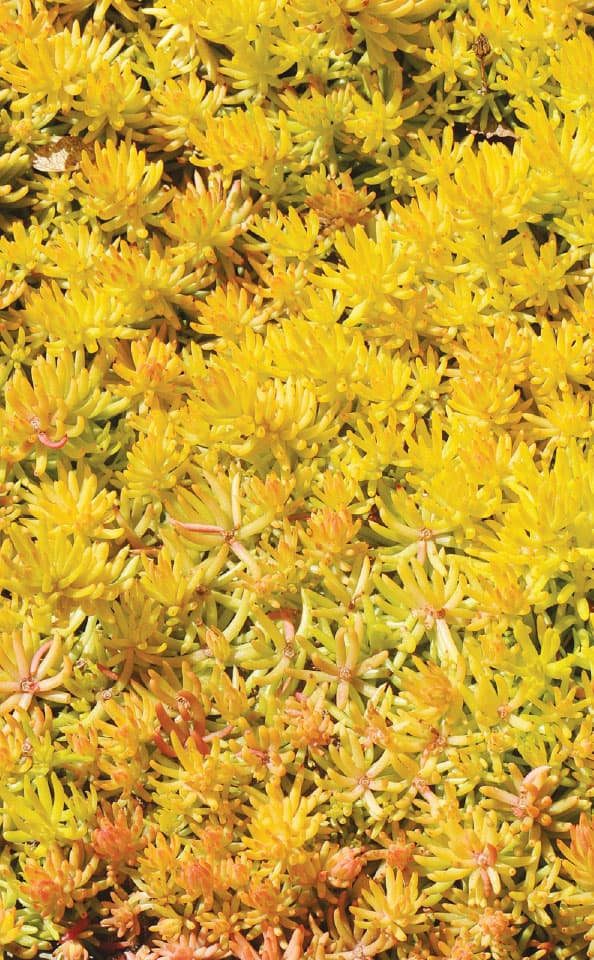
Sedum spathulifolium ‘Capo Blanco’
SPOON LEAF STONECROP
FAMILY: Crassulaceae
ORIGIN: North American Pacific Northwest
CULTURE: Needs full sun and well-draining soil with occasional watering in the hotter months, but must be kept on the dry side in winter. Cold, wet soil encourages root rot.
COLD HARDINESS: −15°F (–26.1°C)
PROPAGATION: By cuttings
BLOOM TIME: Summer
A well-behaved species, ‘Capo Blanco’ leaves form tight rosettes that are covered in a heavy, powdery, silvery-white coating. In cooler weather, the green coloring underneath takes on a dark purple hue that looks particularly attractive combined with the silvery powder coat. As an added bonus, clusters of tiny yellow flowers contrast nicely with the foliage in summer. This is a great choice for a groundcover, container, rock garden, or pathway accent, because it stays compact and low growing at around 3" (7.6 cm) tall and spreading to 12" (30.5 cm). It is fairly cold hardy, but remember to keep the soil dry in winter to avoid root rot.
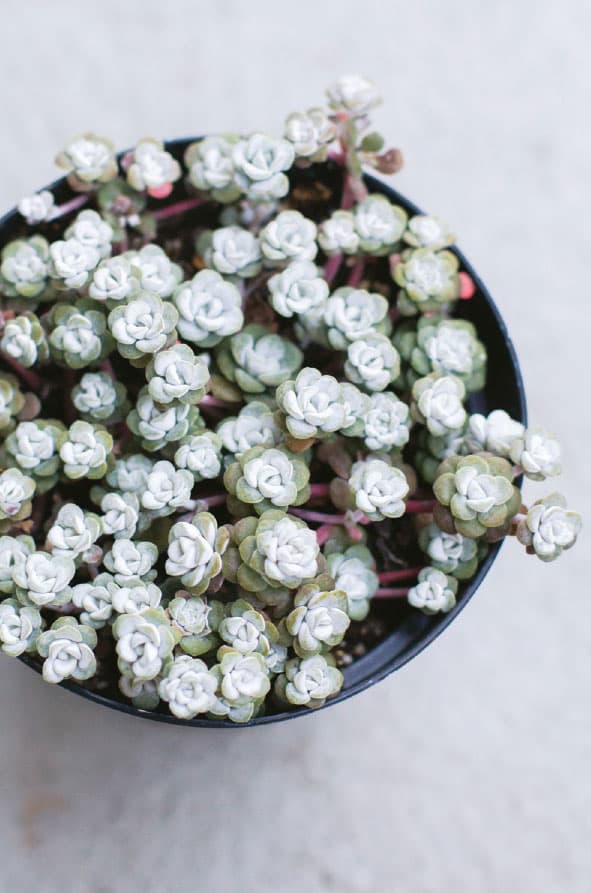
Sempervivum arachnoideum
COBWEB HOUSELEEK, SPIDER WEB HENS AND CHICKS
FAMILY: Crassulaceae
ORIGIN: Southern Europe
CULTURE: Needs full sun to light shade and shade protection in very hot, sunny locations. Prefers a sandy, well-draining soil and requires little watering once established.
COLD HARDINESS: −25°F (–31.7°C)
PROPAGATION: By offsets
BLOOM TIME: Spring to summer
The name for the genus comes from the Latin words semper, meaning “always,” and vivus, meaning “living,” in reference to the long-living nature of these plants. Spider web hens and chicks forms hardy, compact rosettes that have small white threads running back and forth across the face and bears an uncanny resemblance to a spider’s web building. The short bloom stalks that appear spring to summer display beautifully exotic, star-shaped, magenta flowers. Historically, it was thought to have mysterious abilities to ward off evil and protect a house from lightning strikes. As such, it was planted outside of dwelling entrances and used on the thatched roofs of Europe. It is a perfect plant for growing in crevices of stone walls and rocky outcroppings.
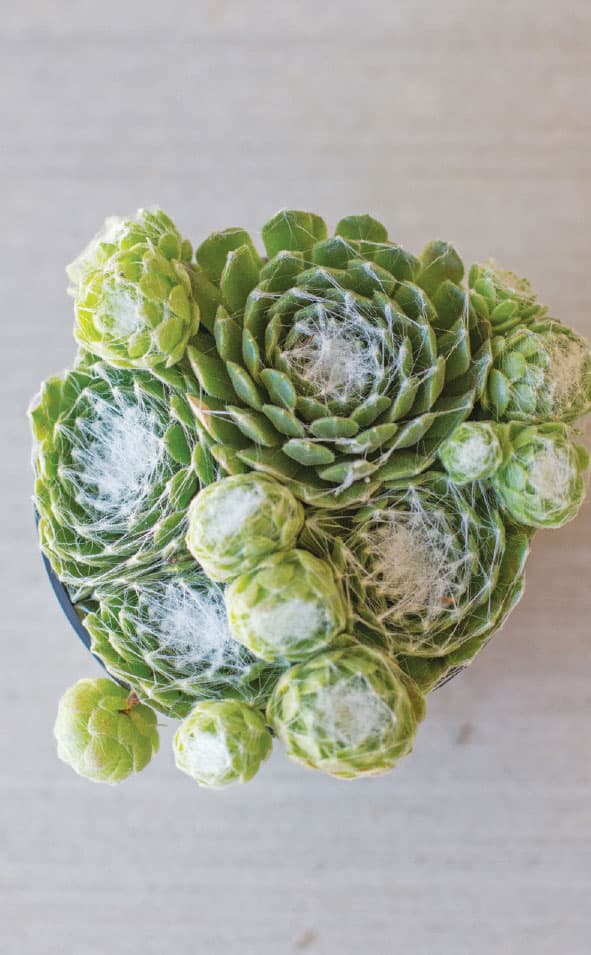
Senecio articulatus ‘Variegatus’
VARIEGATED CANDLE PLANT
FAMILY: Asteraceae
ORIGIN: South Africa
CULTURE: Needs filtered sun or light shade and very porous, well-draining soil. A winter grower, it takes occasional watering at that time and water should be reduced to even less in warmer months. Protect from frost.
COLD HARDINESS: 35°F (1.7°C)
PROPAGATION: By cuttings
BLOOM TIME: Summer to fall
Variegated candle plant is a wonderfully unusual-looking succulent. It is comprised of short sausage-like as well as round stem segments, reaching an overall height of 1' to 2' (0.3 to 0.6 m) tall with some branching. Erect but supple stems are green with a light green pattern, and the leaves exhibit exotic combinations of white, green, cream, pink, and purple variegation. Being a winter grower, it is leafless most of the rest of the year and exists as simple, swollen stems. Care problems can be caused by the urge to water during the summer dormancy period, when watering should really be reduced to a bare minimum. Rotting becomes very likely under this type of regime.
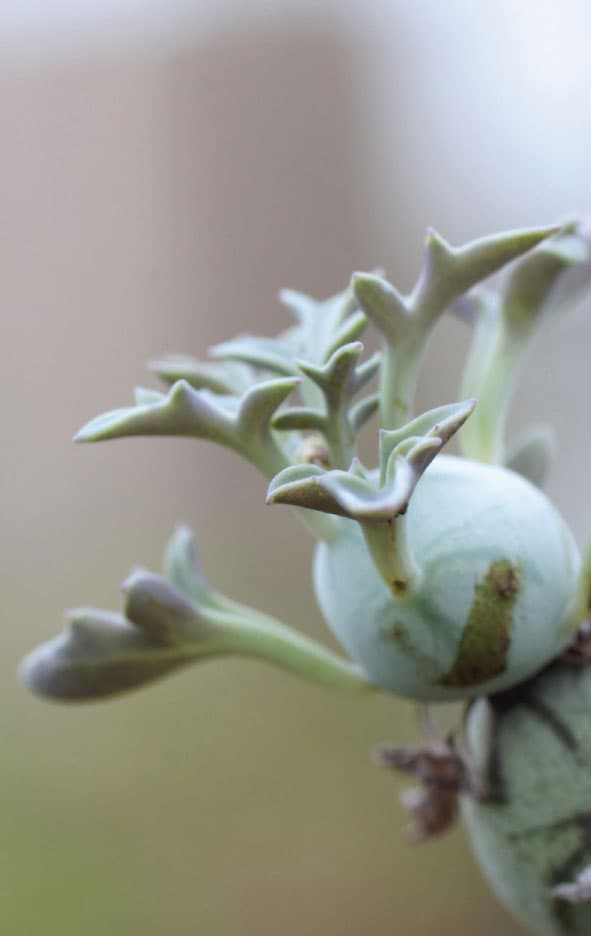
Senecio talinoides var. mandraliscae
BLUE CHALK STICKS
FAMILY: Asteraceae
ORIGIN: South Africa
CULTURE: Needs full sun and porous, well-draining soil. Provide thorough watering, allowing the soil to dry before repeating, and reduce water in winter. Looks best with supplemental watering during the hottest months and in inland areas.
COLD HARDINESS: 20°F (–6.7°C)
PROPAGATION: By cuttings
BLOOM TIME: Summer
This is an excellent ice plant–type trailing groundcover. Its most noticeable feature is the glowing blue-gray succulent foliage. Leaves like blue fingers stand upright on trailing stems that spread outward to 3' (0.9 m) in length. Like most senecios, it produces white to tan powder puff–type flowers that are relatively unremarkable. The noteworthy blue color of the fingers creates a breathtaking contrast in the garden when combined with other dark-colored succulents, such as Aeonium ‘Zwartkop’.
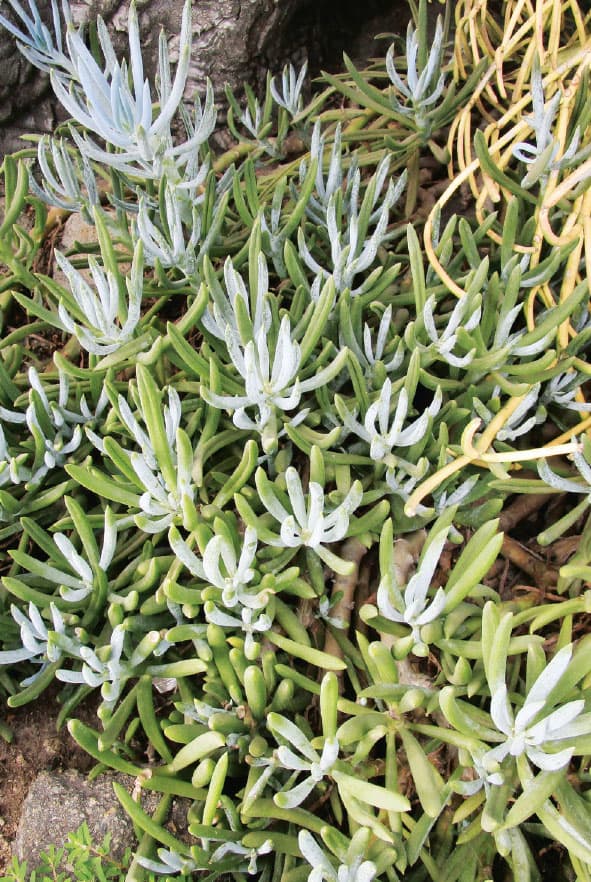
Senecio scaposus
SILVER CORAL
FAMILY: Asteraceae
ORIGIN: South Africa
CULTURE: Prefers full sun to light shade and very porous, well-draining soil. Water thoroughly, allowing the soil to dry out before watering again. Water only enough to keep from shriveling in winter.
COLD HARDINESS: 25°F (–3.9°C)
PROPAGATION: By cuttings
BLOOM TIME: Summer
Members of the Senecio family come in all shapes and sizes, and this is a most attractive species with long, dazzling, bright silver-white, succulent finger-like leaves. The leaves are actually covered with a silver-white felt-type skin that may shed over time as the leaves expand, exposing solid green. The felt-like coating serves as protection against the harsh sun in its native habitat. This is a short-stemmed shrublet that branches at the base and can make a 1'- (0.3 m) tall mound. The unusual finger-like leaves resemble a sea anemone or finger coral, making it a favorite to use when planting a faux “undersea-themed” succulent garden. Showy yellow daisy flowers appear in summer.
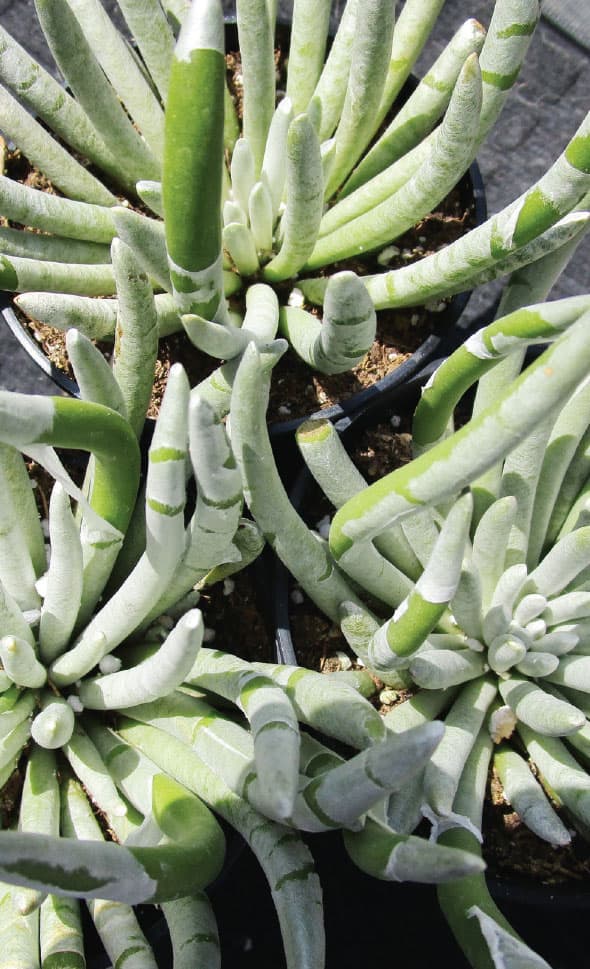
Stapelia gigantea
CARRION FLOWER, AFRICAN STARFISH FLOWER
FAMILY: Apocynaceae
ORIGIN: Tropical and southern Africa
CULTURE: Grow in full sun to light shade in hottest, inland locations. Needs porous, well-draining soil. Water occasionally, allowing the soil to dry slightly before watering again. Keep on the dry side in winter, watering only enough to avoid shriveling, and protect from frost.
COLD HARDINESS: 30°F (–1.1°C)
PROPAGATION: By cuttings
BLOOM TIME: Late summer–fall
Listed among plants with the worst-smelling flowers, this member of the milkweed family sports one of the largest flowers in the plant kingdom. Huge, balloon-like buds open to amazing (10"- to 16" [25.4 to 40.6 cm]-wide) perfect five-point stars. Pale yellow-ochre and decorated with thin, narrow maroon bars, the flowers exude the infamous aroma of rotting flesh like other members of the Stapelia clan. The unpleasant fragrance is the mechanism for attracting its main pollinator—flies. The upright pale green stems are four sided and 6" to 12" (15.3 to 30.5 cm) tall, taking on a red-purple hue in extreme sun exposure. Plants spread outward 18" to 24" (45.7 to 61 cm) on creeping stems and can make an interesting small-scale groundcover in sunny, frost-free locations.
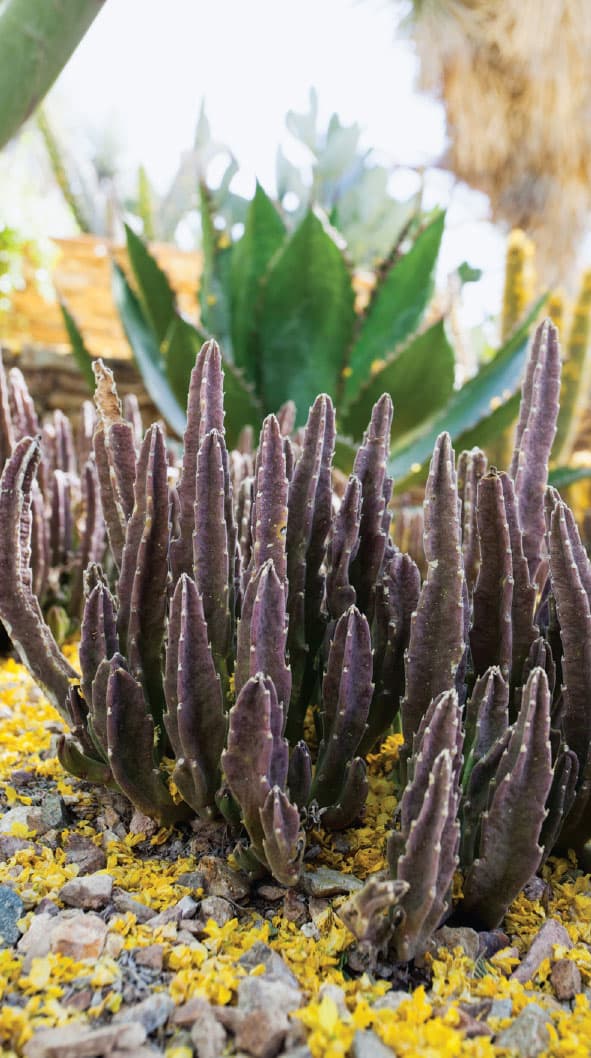
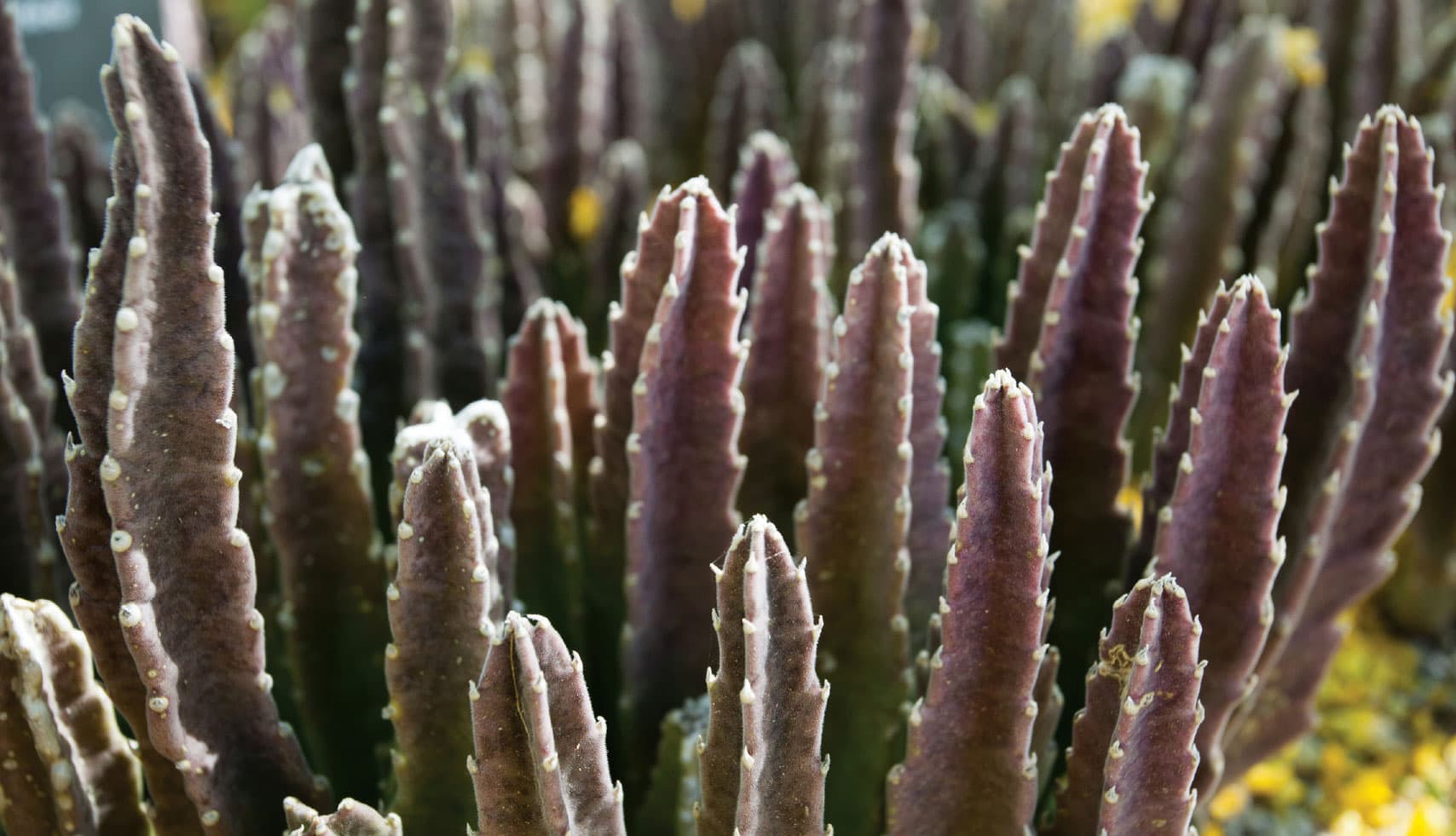
Titanopsis calcarea
JEWEL PLANT, CONCRETE LEAF
FAMILY: Aizoaceae
ORIGIN: South Africa
CULTURE: Grow in full sun to light shade in hottest, inland locations. Needs porous, well-draining soil. Water occasionally, allowing the soil to dry slightly before watering again. Keep on the dry side in summer, watering only enough to avoid shriveling, and protect from frost.
COLD HARDINESS: 25°F (–3.9°C)
PROPAGATION: By seed, division
BLOOM TIME: Fall to winter
Titanopsis is another fascinating member of the group known as “mimicry” plants that physically blend in and “mimic” their habitat. Coming from a coarse sand and pebble environment, the plant features leaves tipped with numerous wart-like bumps that are a variety of subtle colors and look like the surrounding sandy soil. The leaves are also actually very hard to the touch, feeling almost stone-like. This is a winter grower, receiving the bulk of its water at that time and preferring to stay quite dry from spring through summer, with only an occasional drink to keep it from shriveling. Bright yellow, daisy-like flowers, large for the size of the plant, appear in fall and winter. This is one of the more easily grown mimicry plants as long as it doesn’t get overwatered.
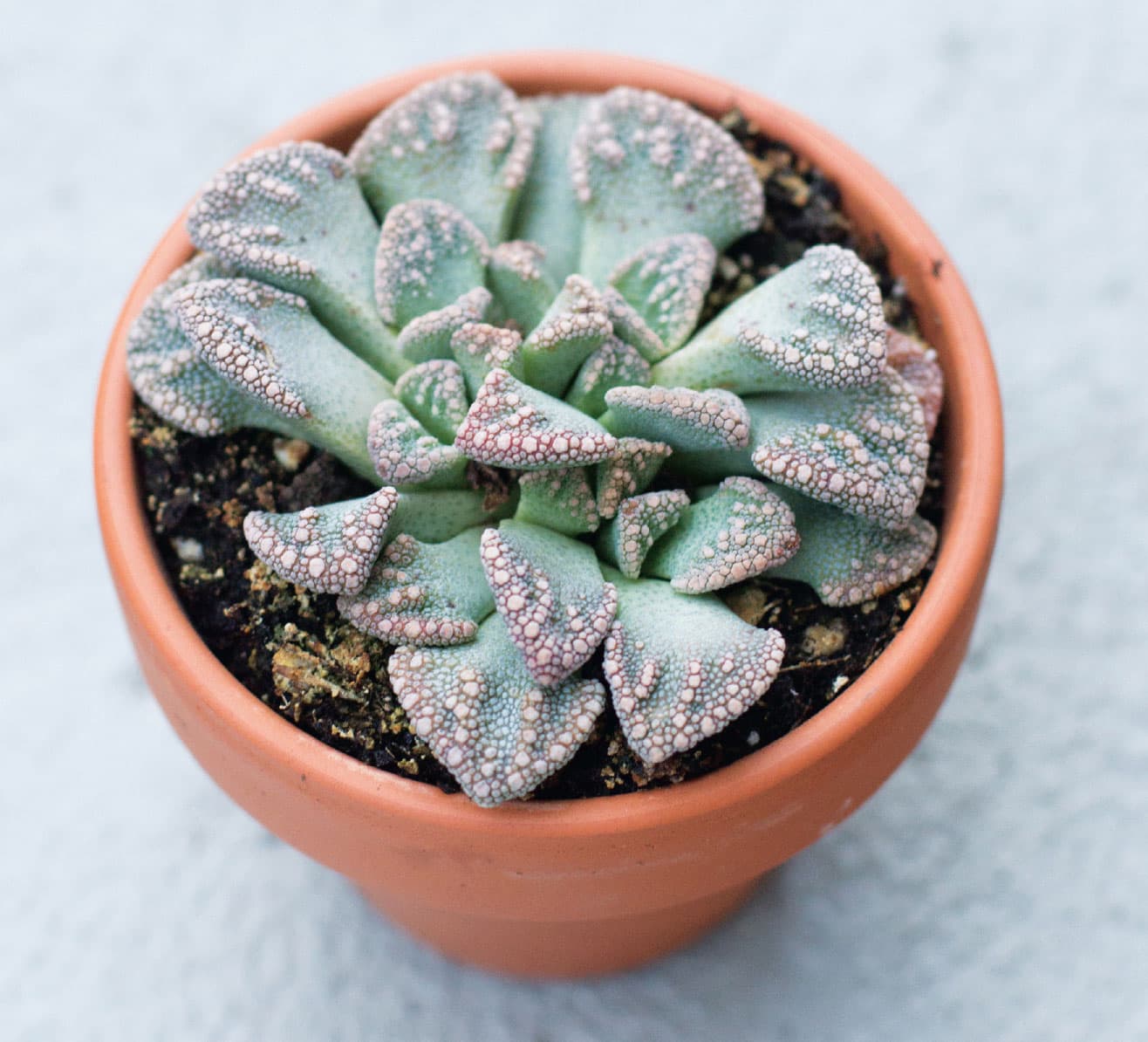
Trichocereus grandiflorus Hybrids
TORCH CACTUS
FAMILY: Cactaceae
ORIGIN: Argentina
CULTURE: Needs full sun, well-draining porous soil, and thorough watering, allowing the soil to dry before repeating. Reduce water in winter.
COLD HARDINESS: 15°F (–9.4°C)
PROPAGATION: By offsets
BLOOM TIME: Summer
Torch cactuses form a clumping colony, with stems to 15" (38.1 cm) in height. The species is known for its beautiful, clear red flowers to 4" (10.2 cm) in diameter. Over the years, the species has been continuously hybridized, resulting in a vast array of colors, including yellow, gold, white, pink, light pink with rose mid-stripes, orange, red, and purple; some are even bicolored. In many cases, the flower size has been increased as well to 9" (22.9 cm) in diameter, competing with Epiphyllum, or “orchid cactuses,” for their outlandish size and colors. They respond dramatically to generous water and fertilizer. With weekly watering and monthly feeding, the best cultivars will respond with blooms biweekly or so for three months and longer. Through hybridization, the actual appearance of the plant has changed as well. Compared to the slenderer species type, many newer hybrids have thick, cylindrical bodies to 10" (25.4 cm)in diameter, with offsets forming clumps or colonies that span several feet across. A mass group like this is breathtaking when in bloom, with dozens of large, brightly colored trumpets all open together. Blooming can continue on and off in flushes over several weeks.
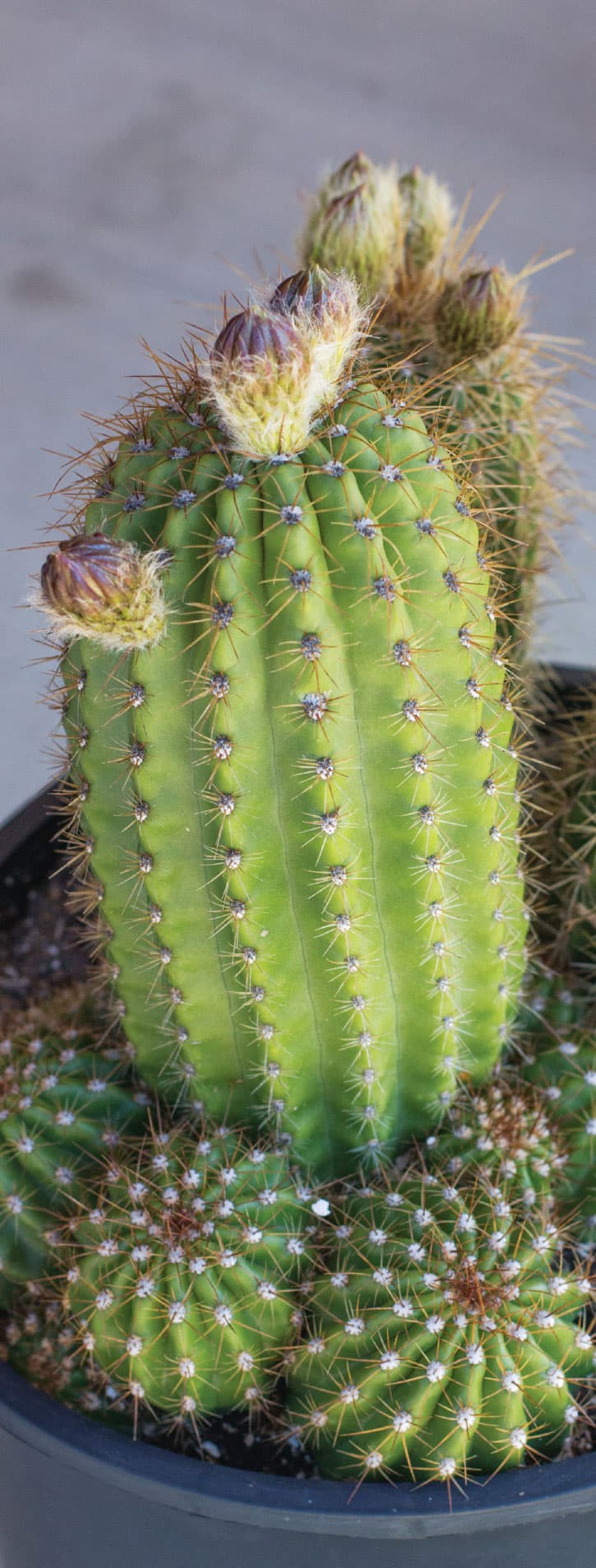
Trichocereus pachanoi/Echinopsis pachanoi
SAN PEDRO CACTUS
FAMILY: Cactaceae
ORIGIN: Peru, Ecuador, Bolivia, Argentina
CULTURE: Grow in full sun with porous, well-draining soil. Water regularly spring to fall, allowing soil to dry slightly between applications. Keep on the dry side in winter, watering only occasionally.
COLD HARDINESS: 15°F (–9.4°C)
PROPAGATION: By seed, cuttings
BLOOM TIME: Summer
The San Pedro cactus is a resident of the higher altitudes of the Andes in the northernmost part of South America. This is an area of somewhat regular high rainfall in the spring and summer months. Because of this, in culture it can be watered much more regularly than most cactuses during this time and is a relatively fast grower. Speed of growth is also increased by feeding monthly during this growing season with a balanced, all-purpose fertilizer. Growth is columnar and can reach 18' (5.5 m) tall. Established plants with this kind of care can grow 1' (0.3 m) a year. It can sunburn in extremely hot summer locations, so light shade is recommended. Stop feeding by the end of summer and reduce watering in fall to initiate winter dormancy. It will only need occasional water in winter. This is a night bloomer with large, white, fragrant flowers. Aside from being a statuesque landscape plant, it is one of several cactuses grown for its psychoactive properties. Archeological studies have found evidence of use going back 2,000 years, to Moche culture in Peru.
